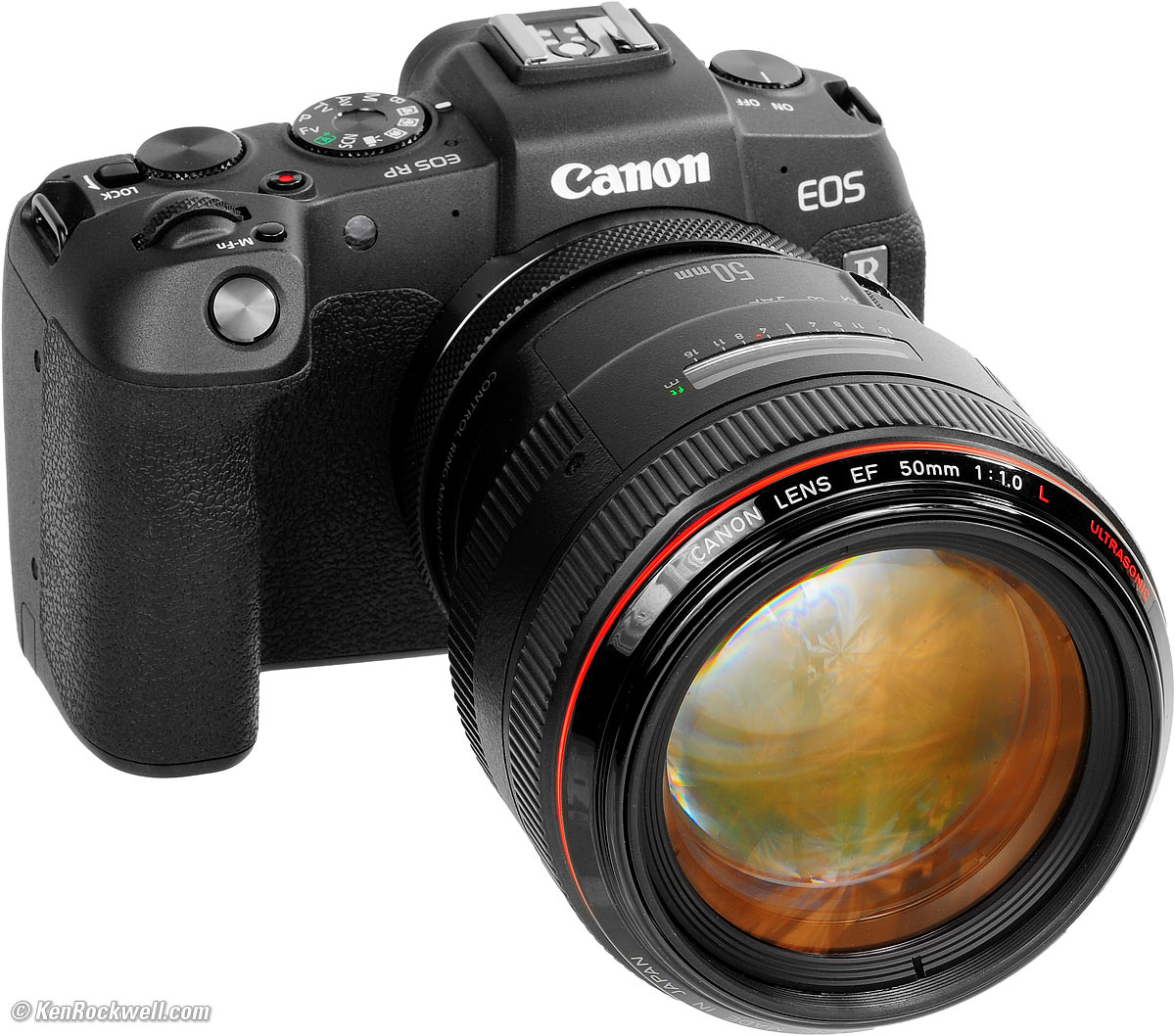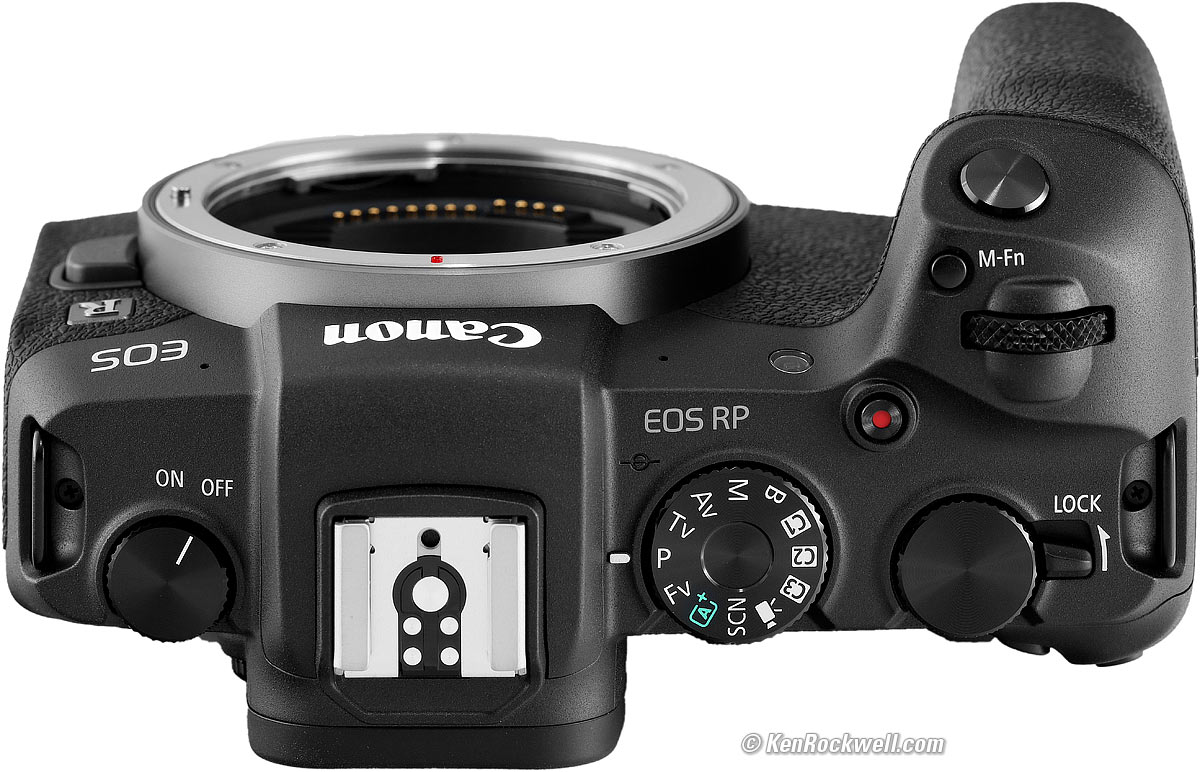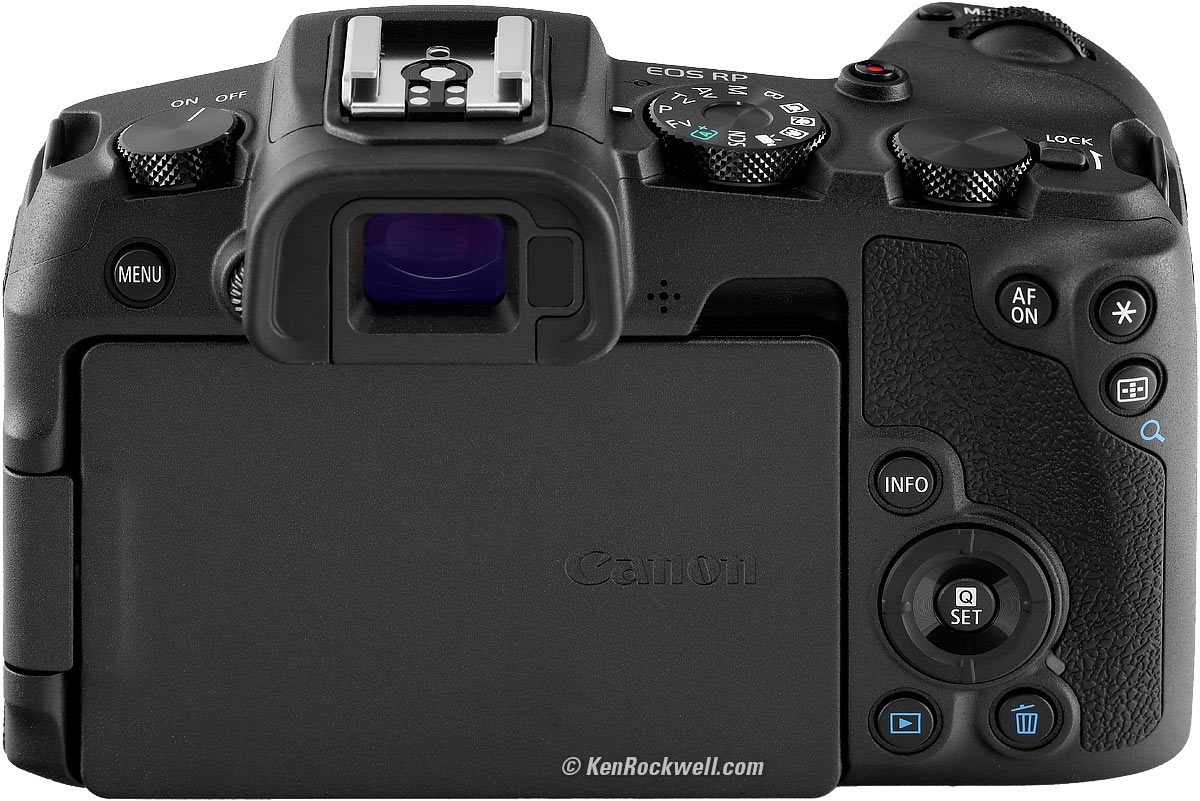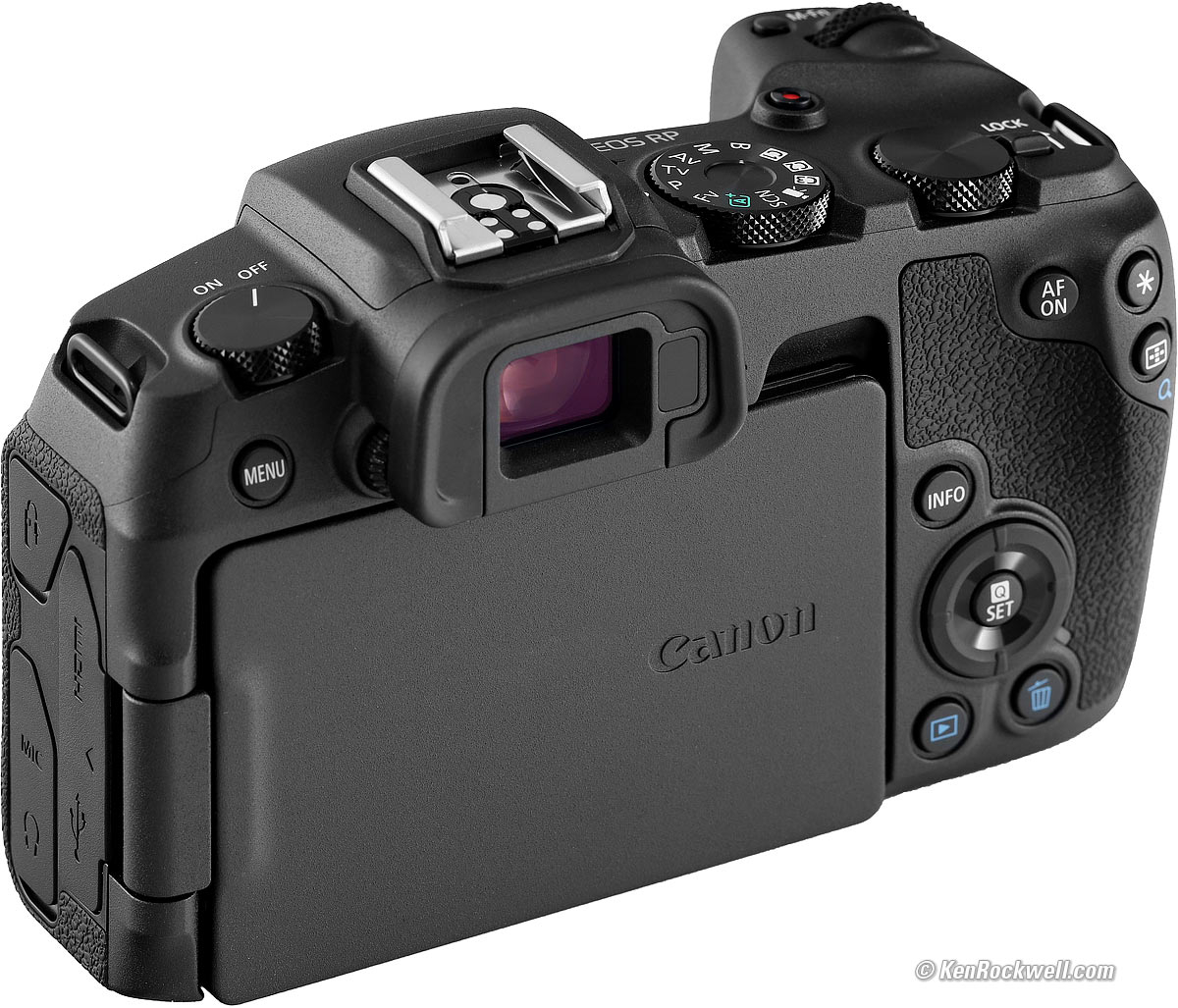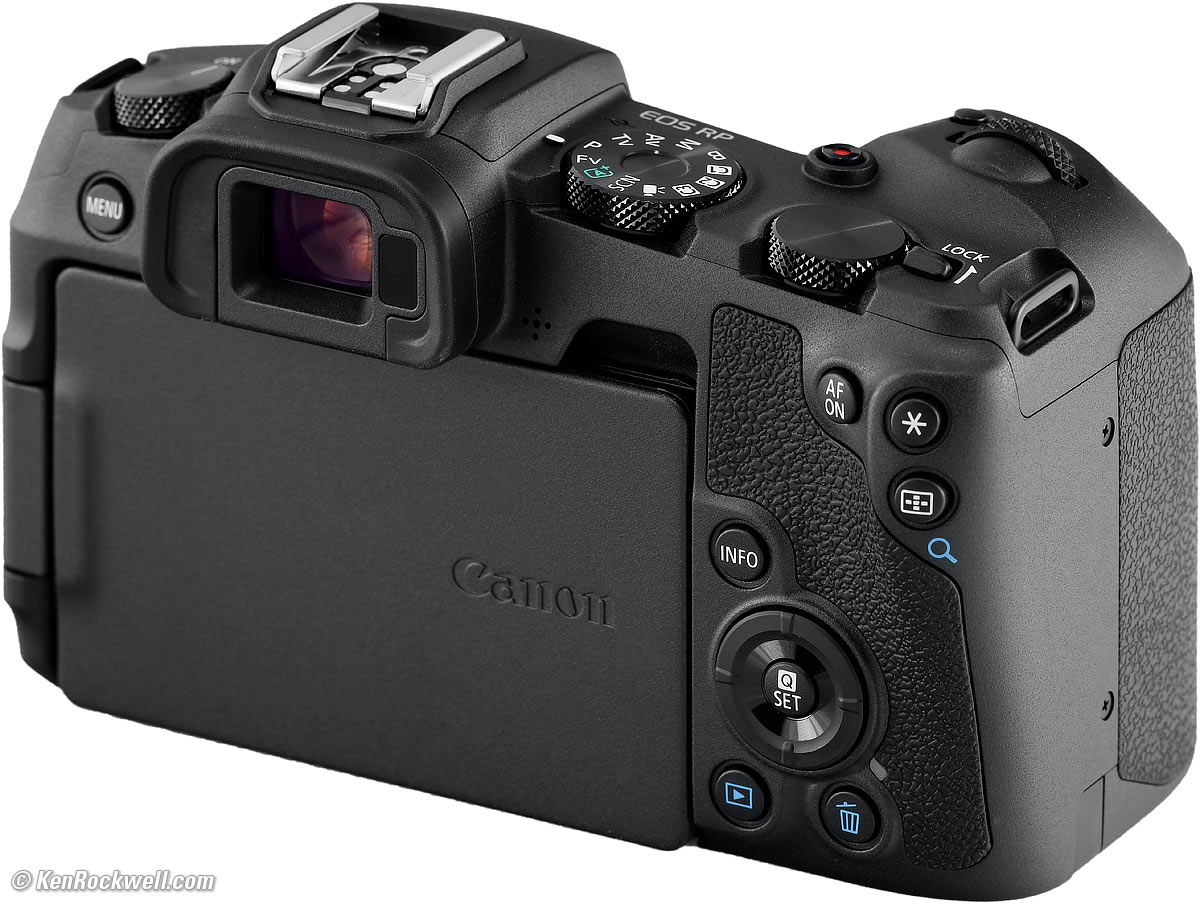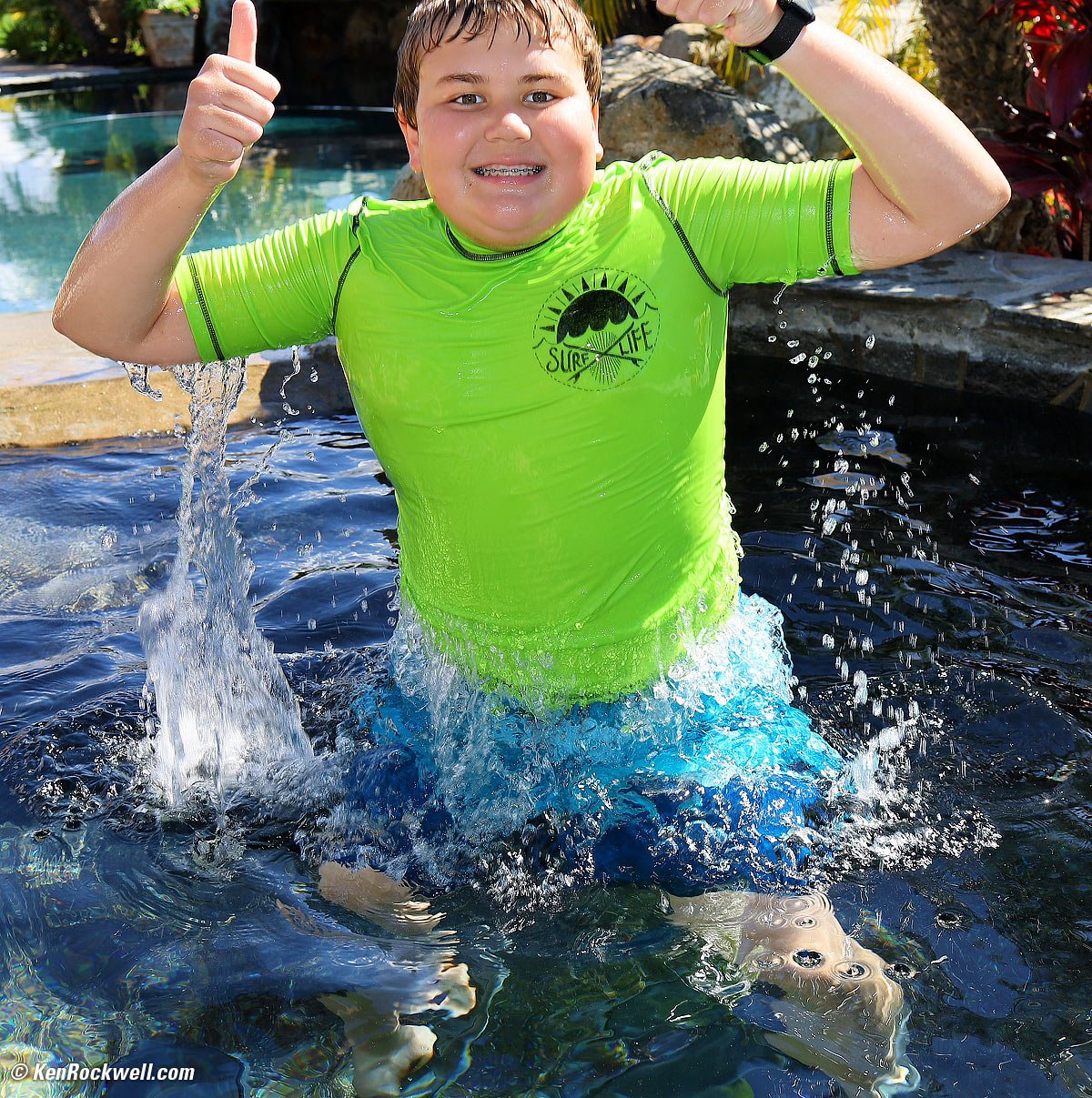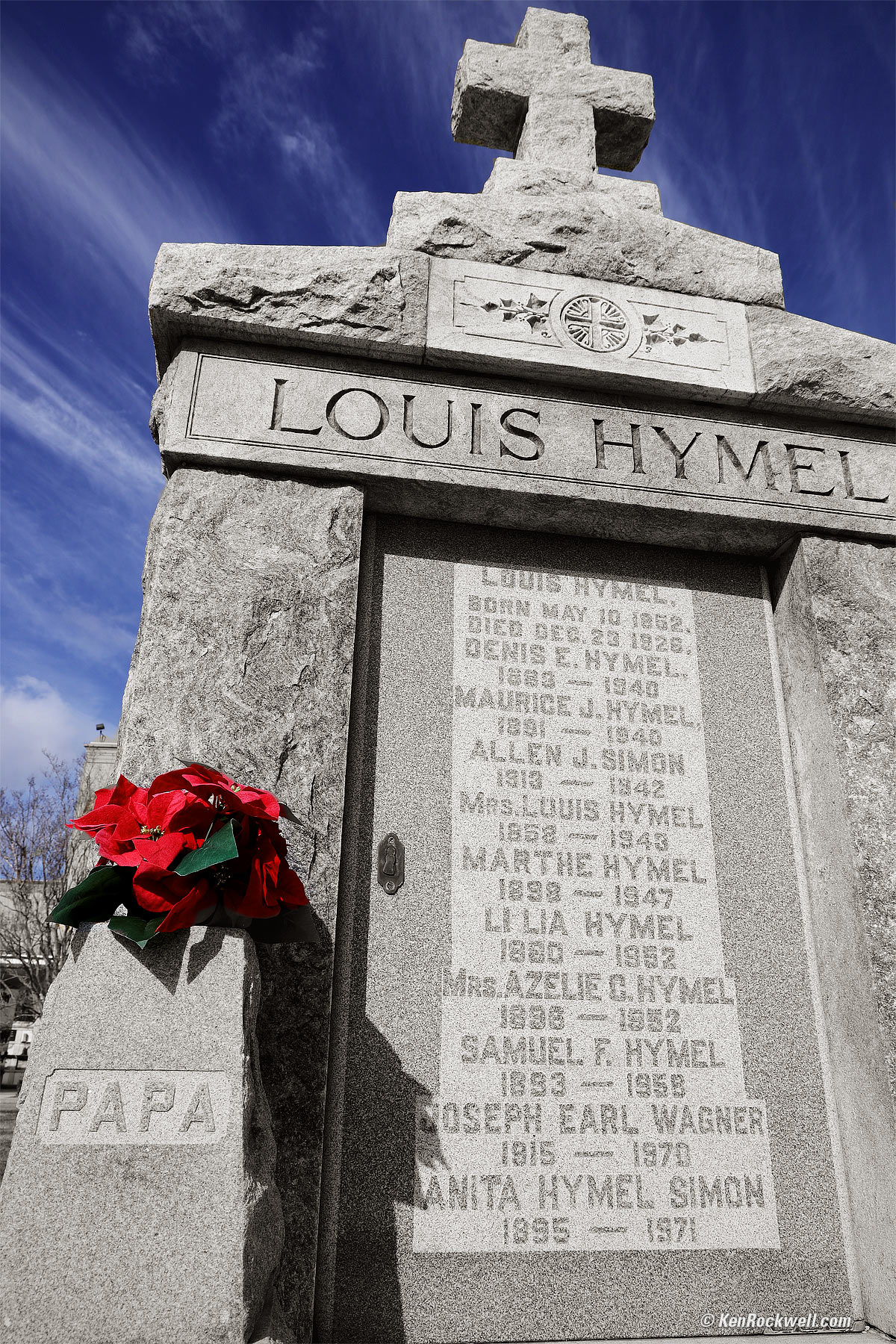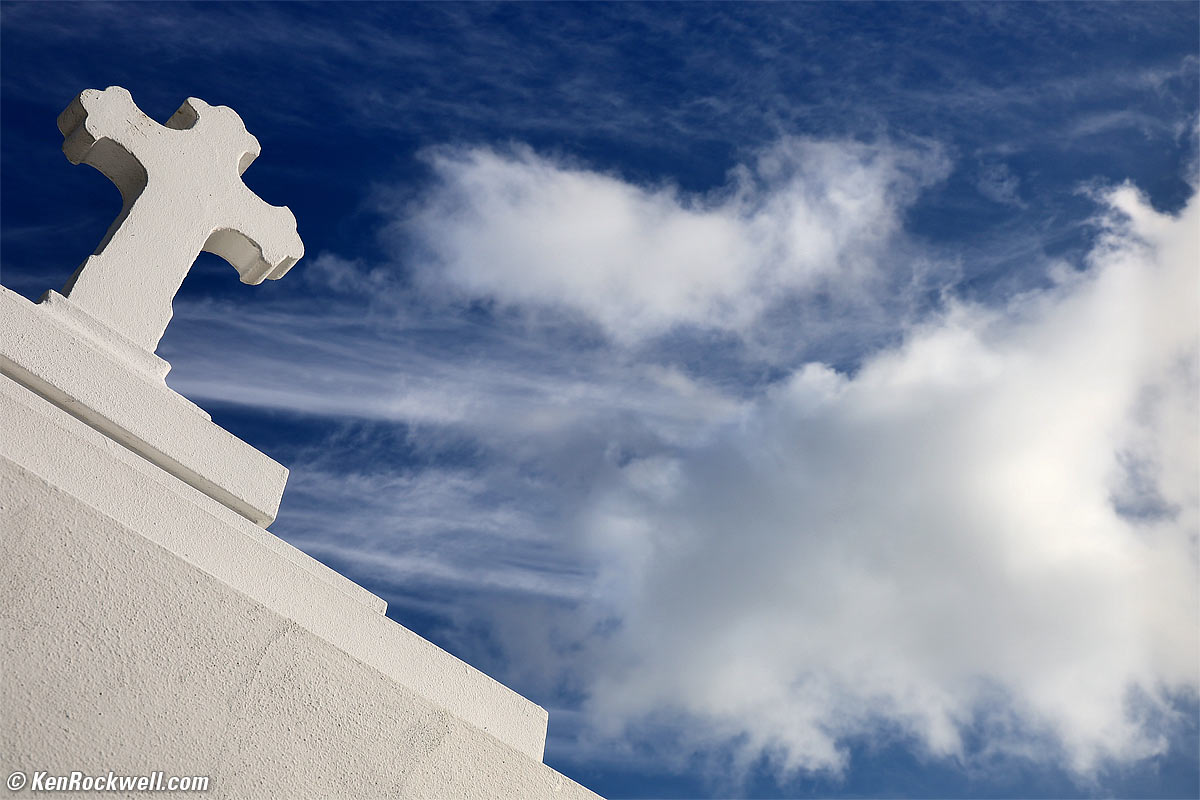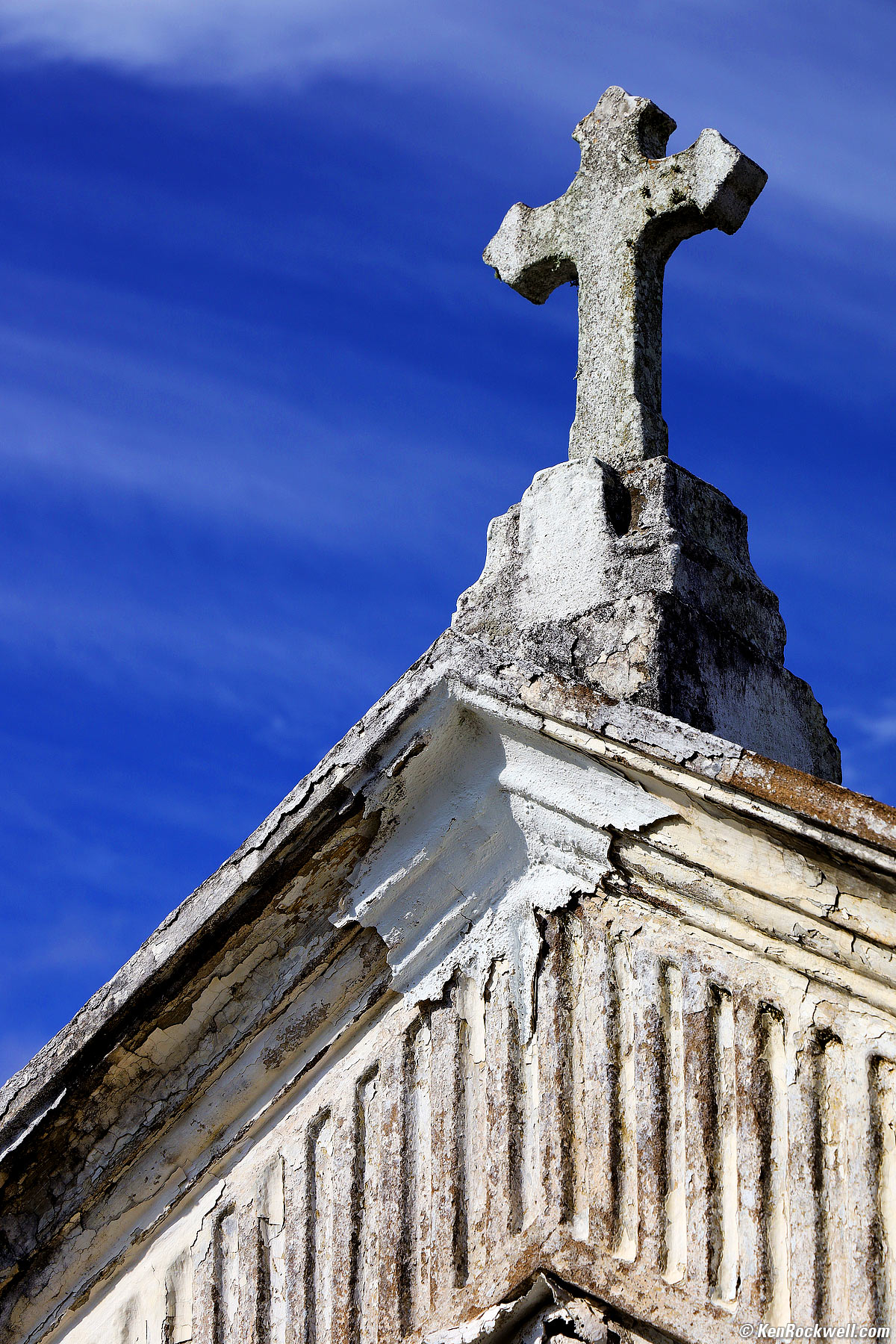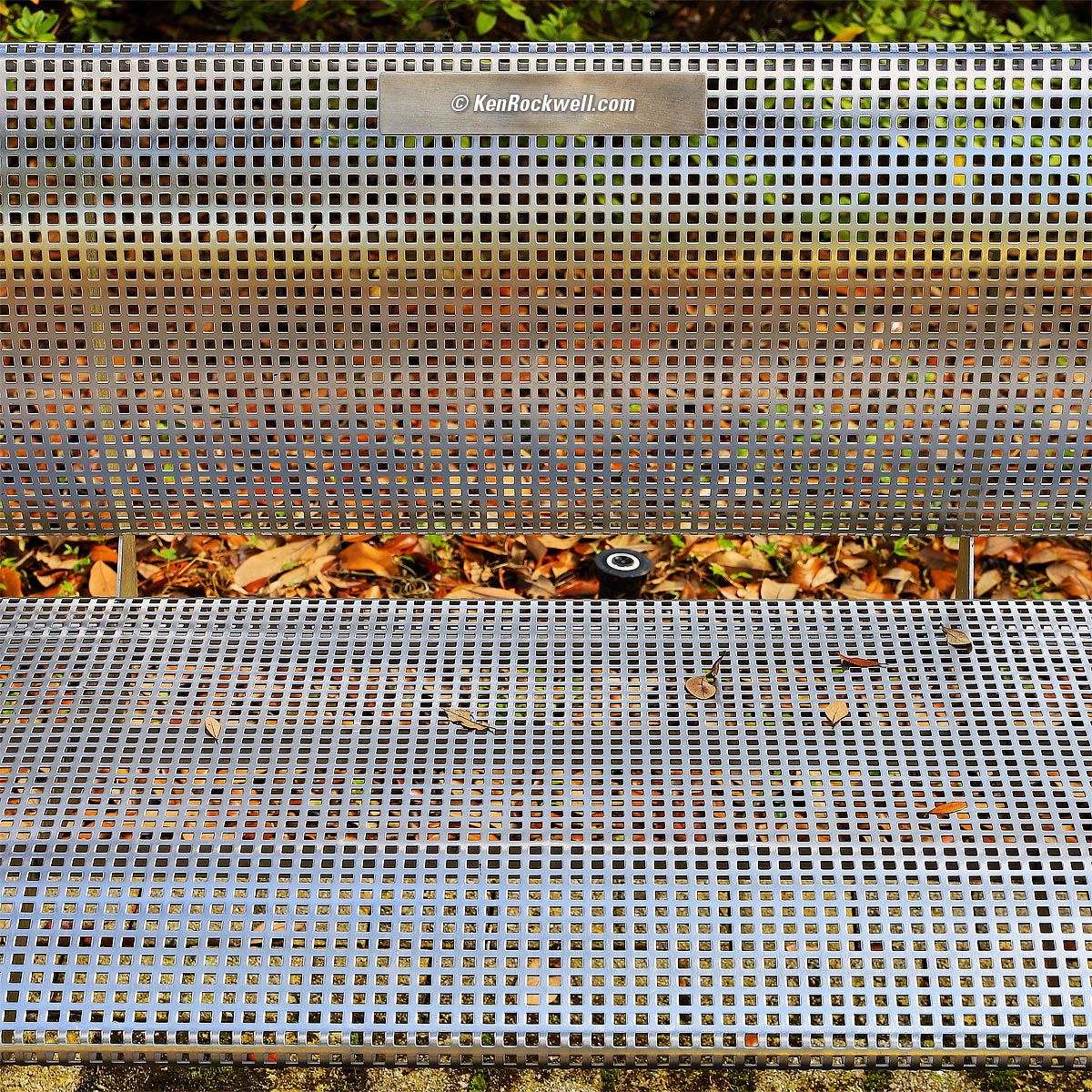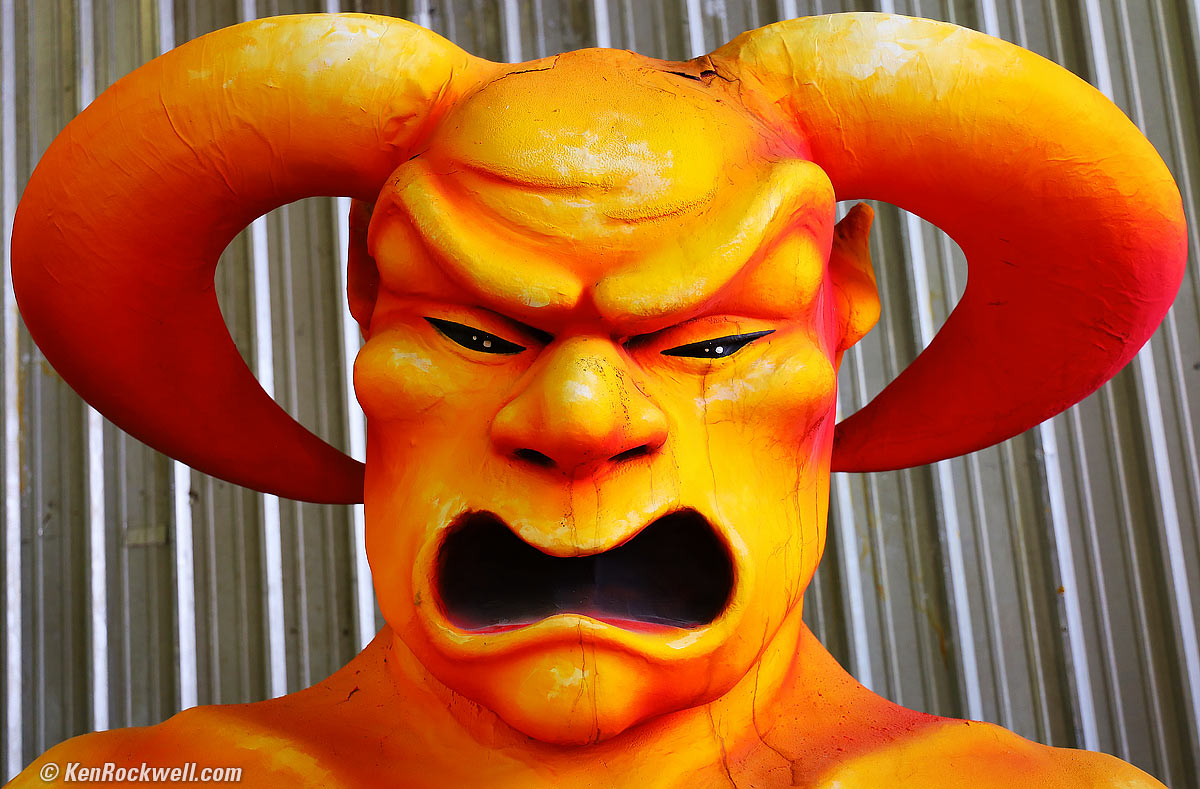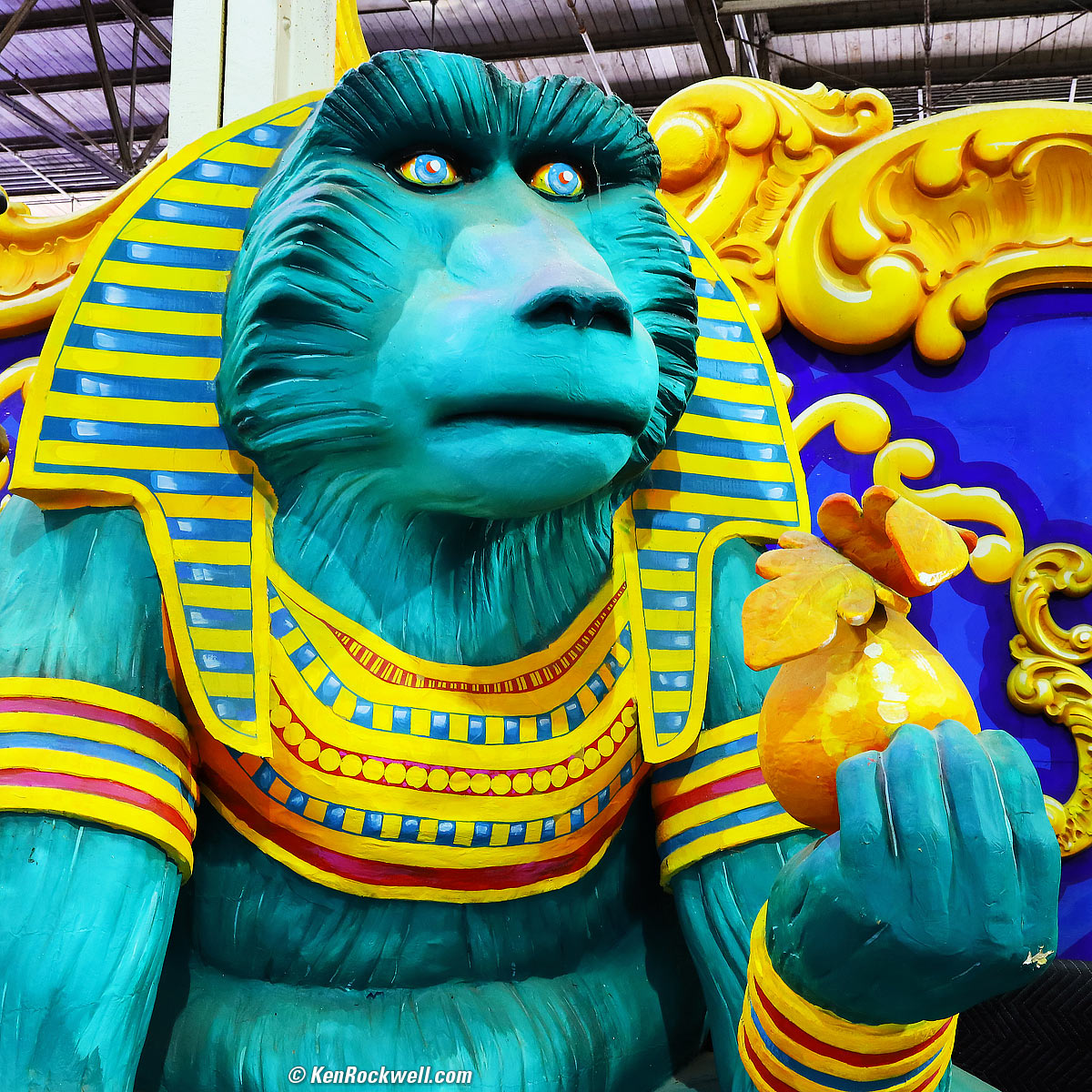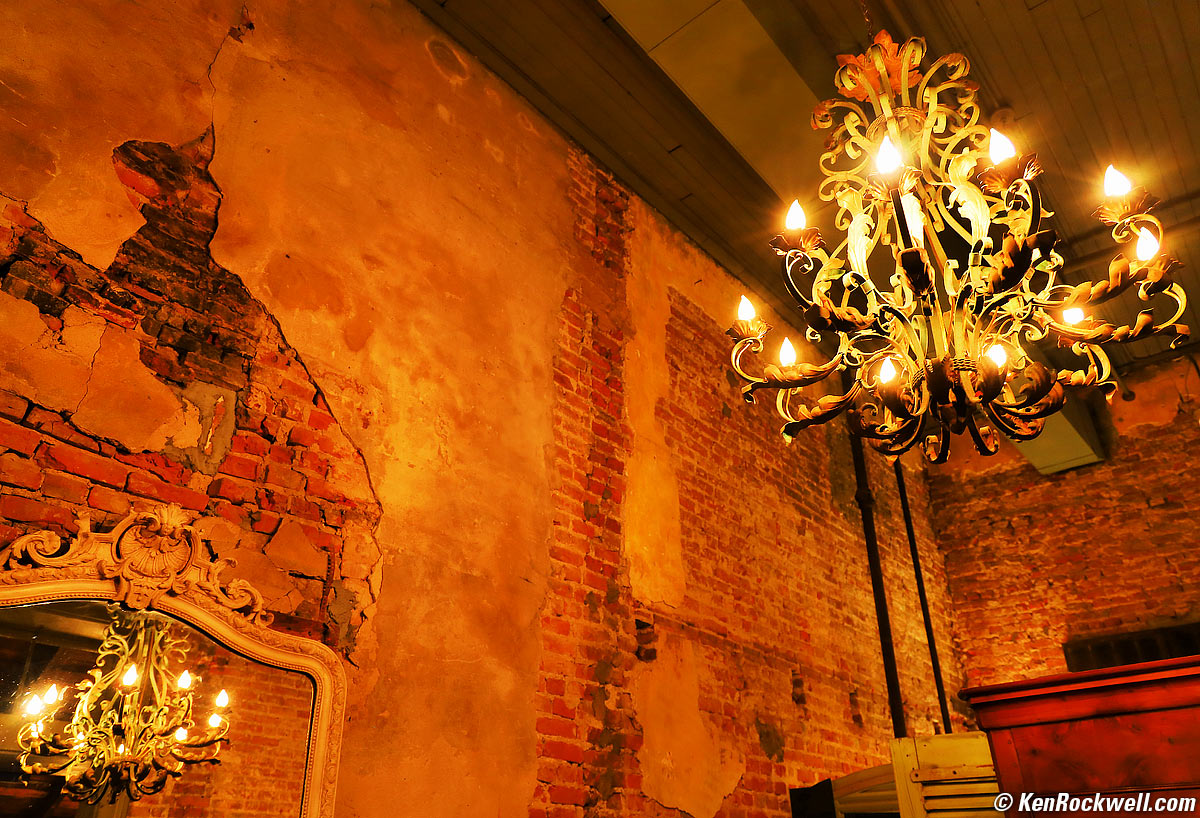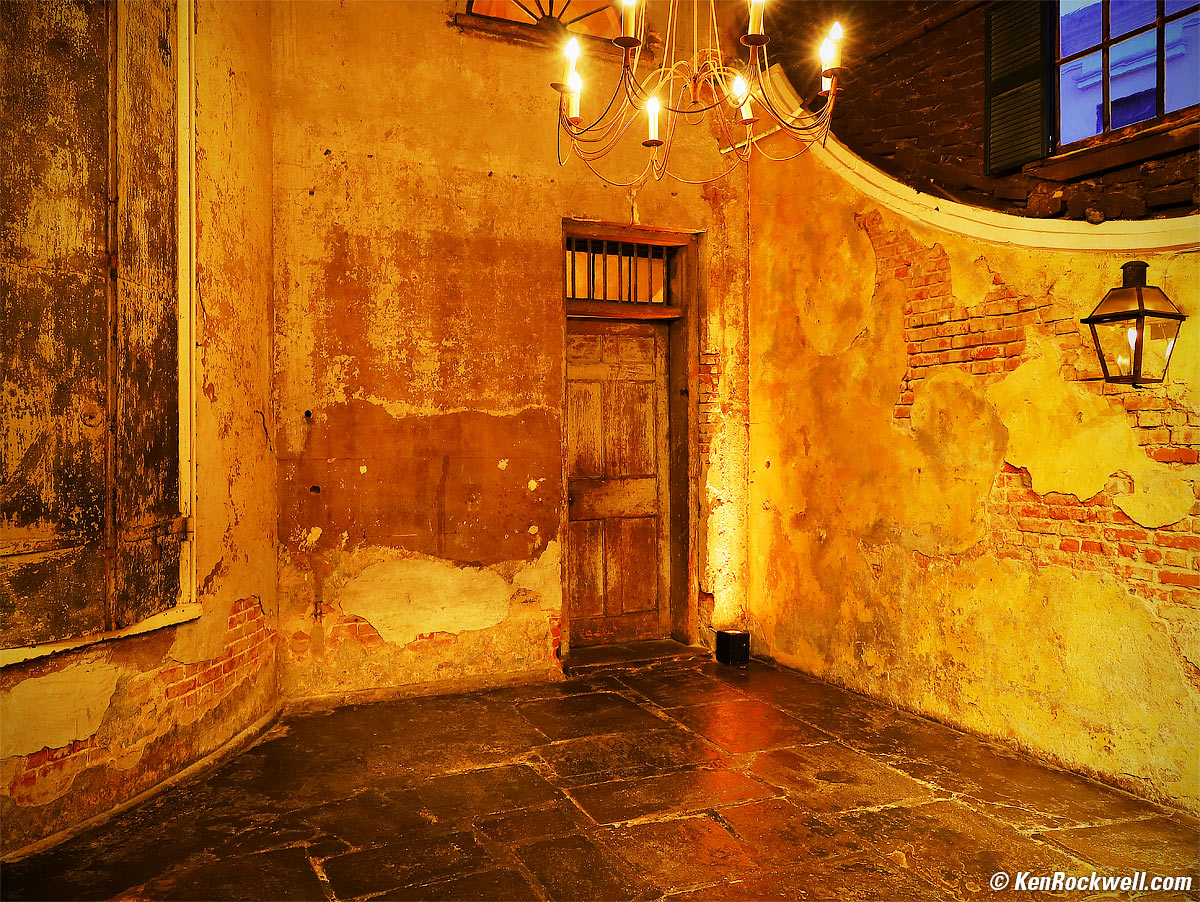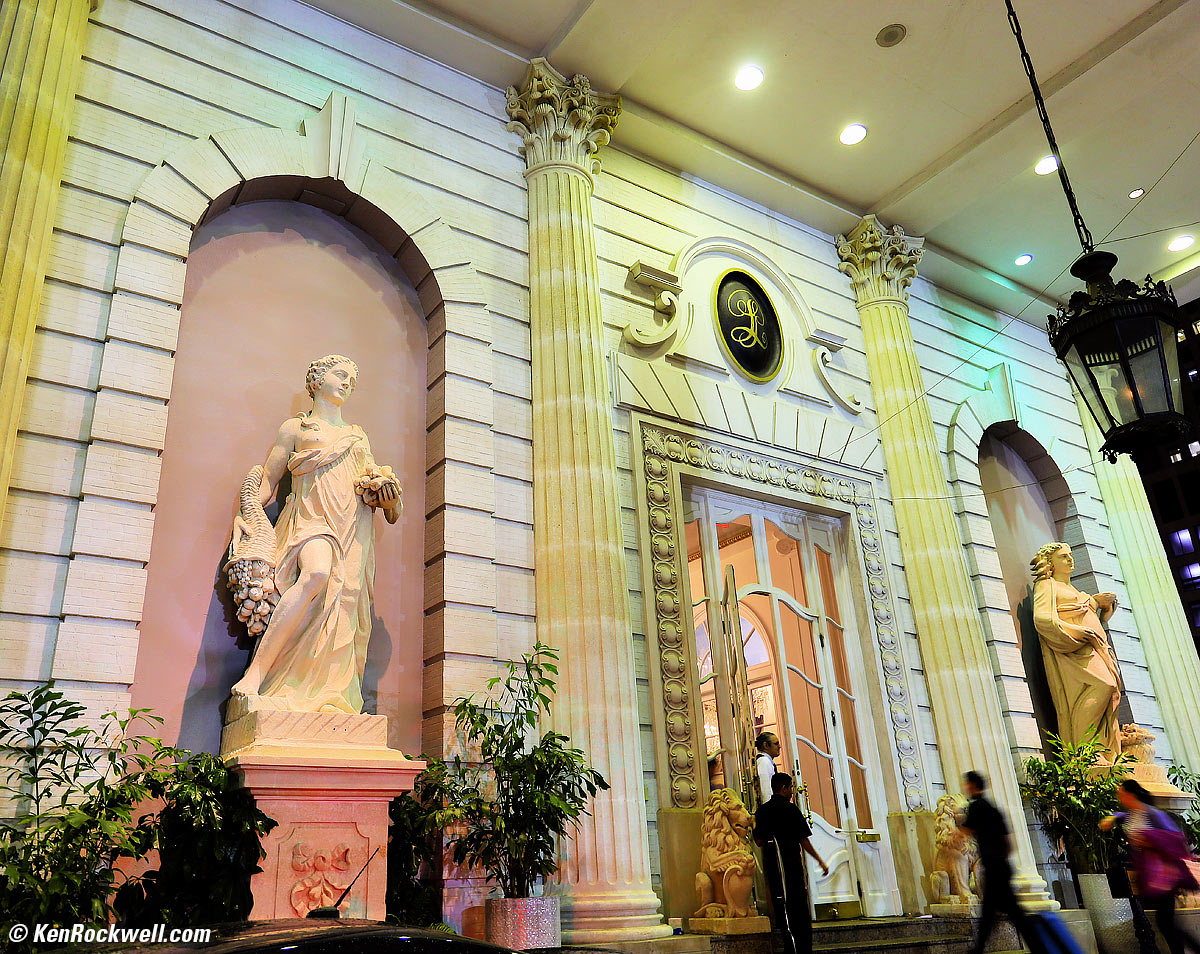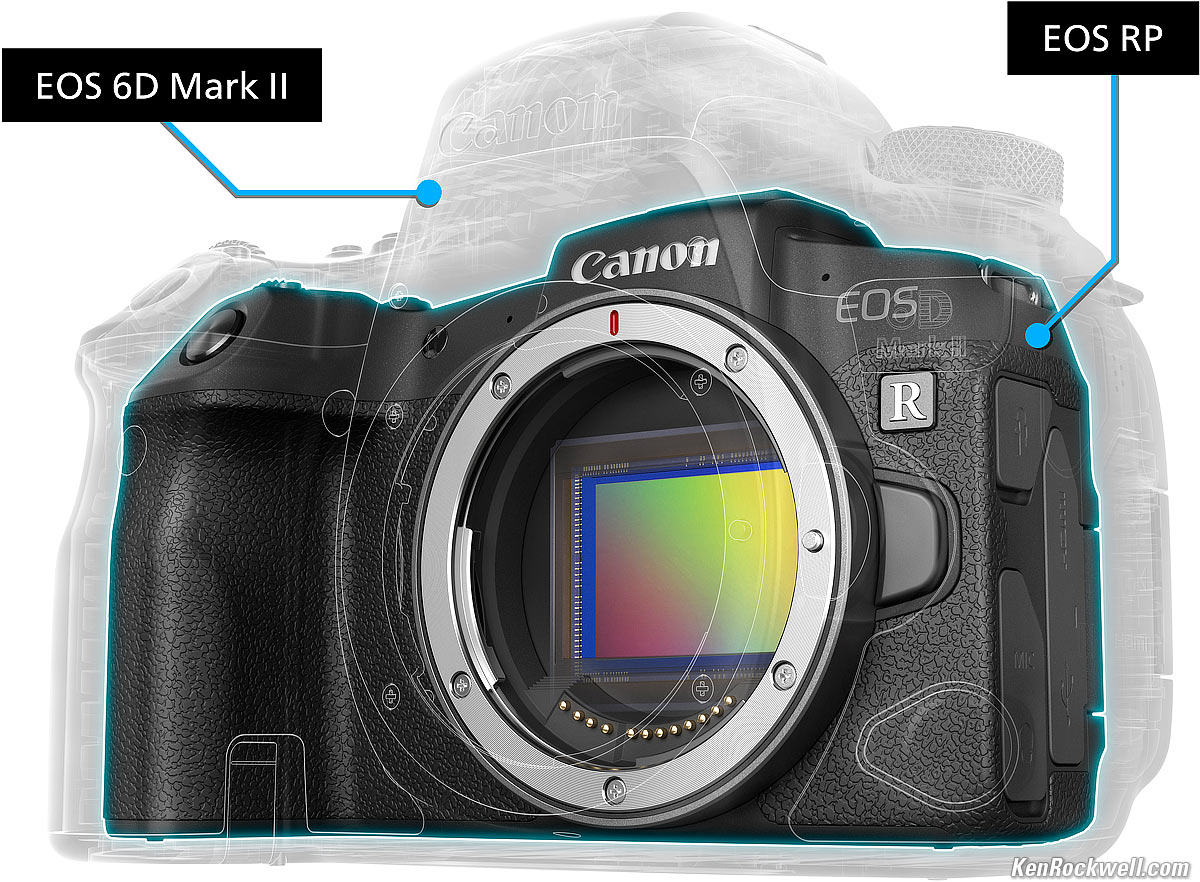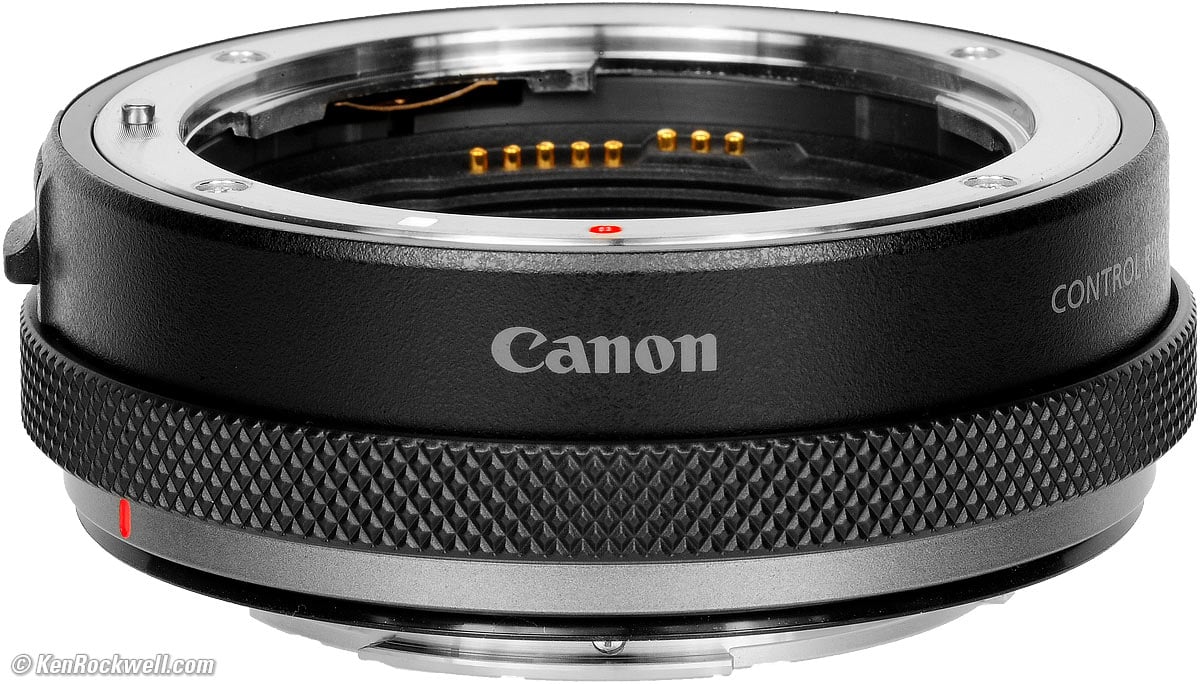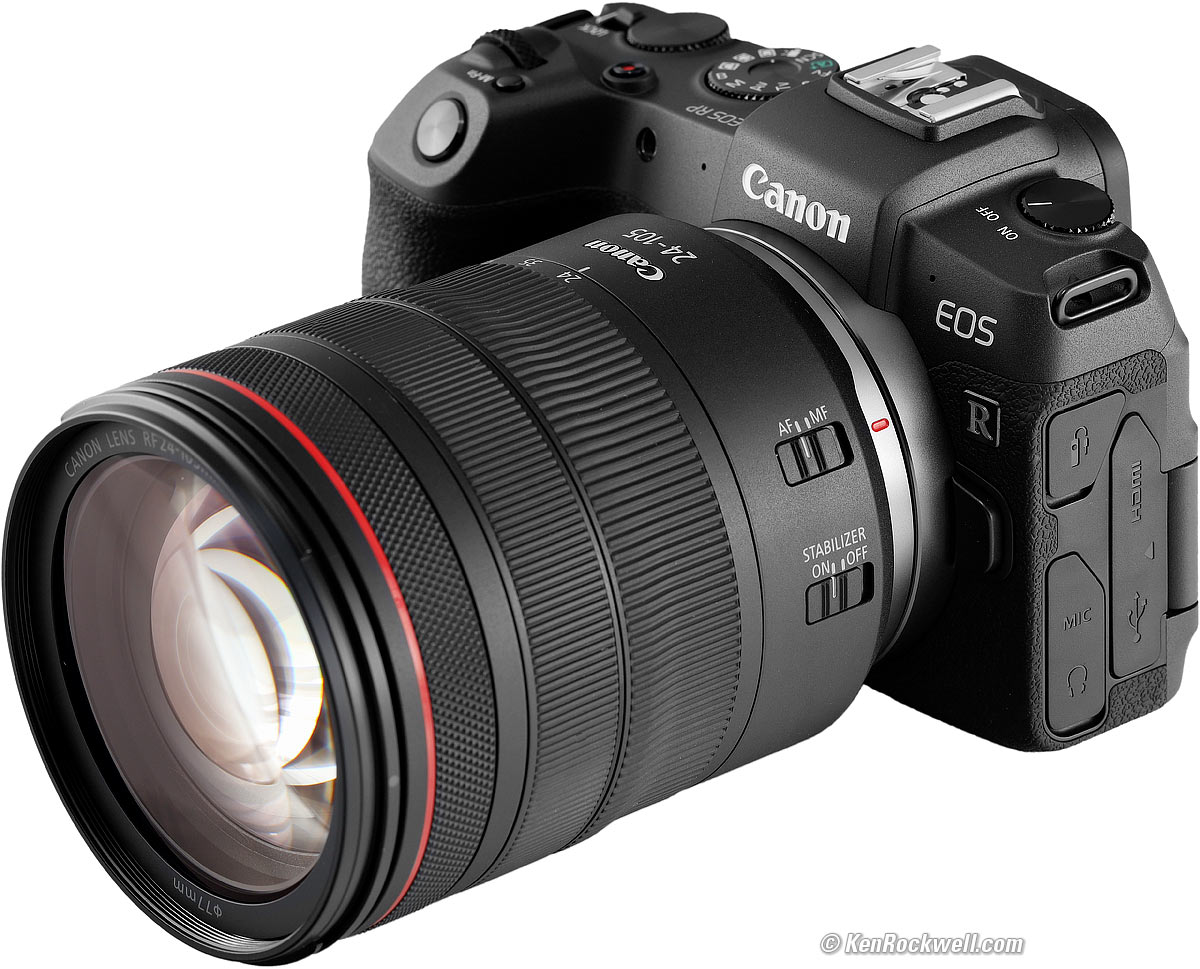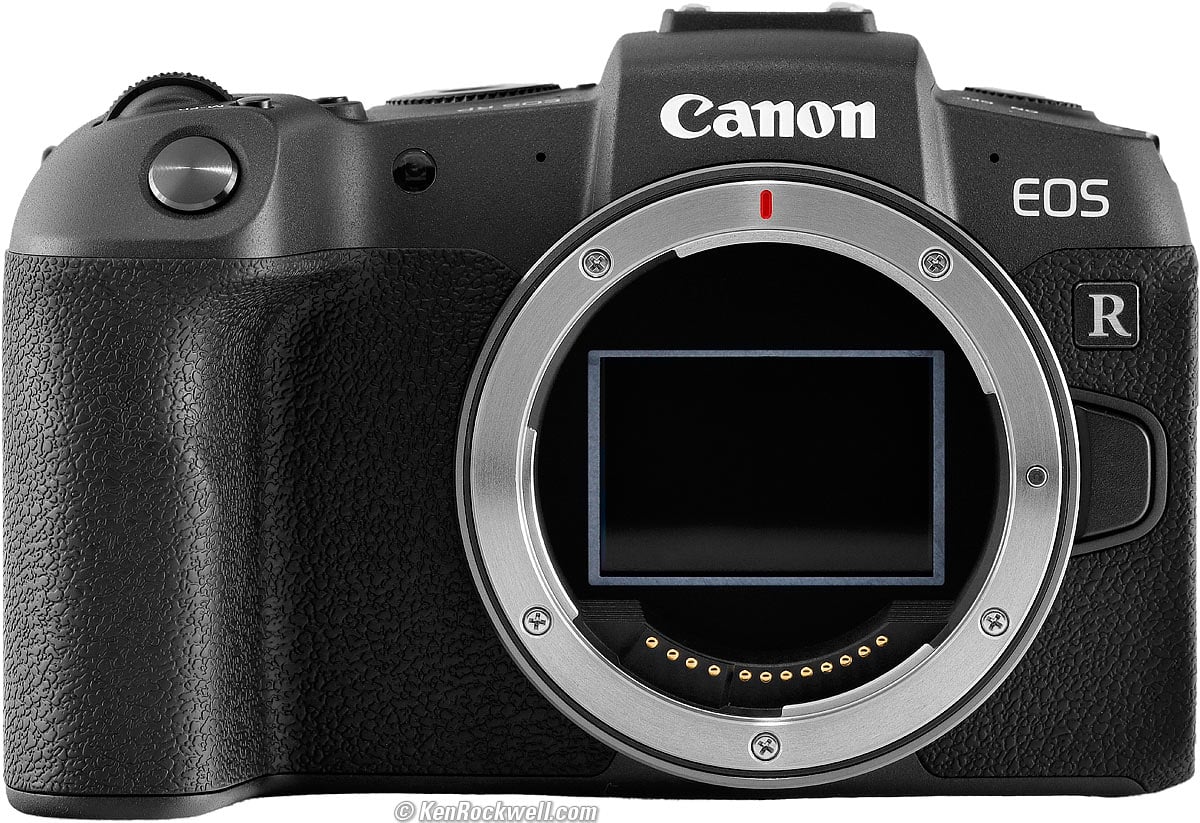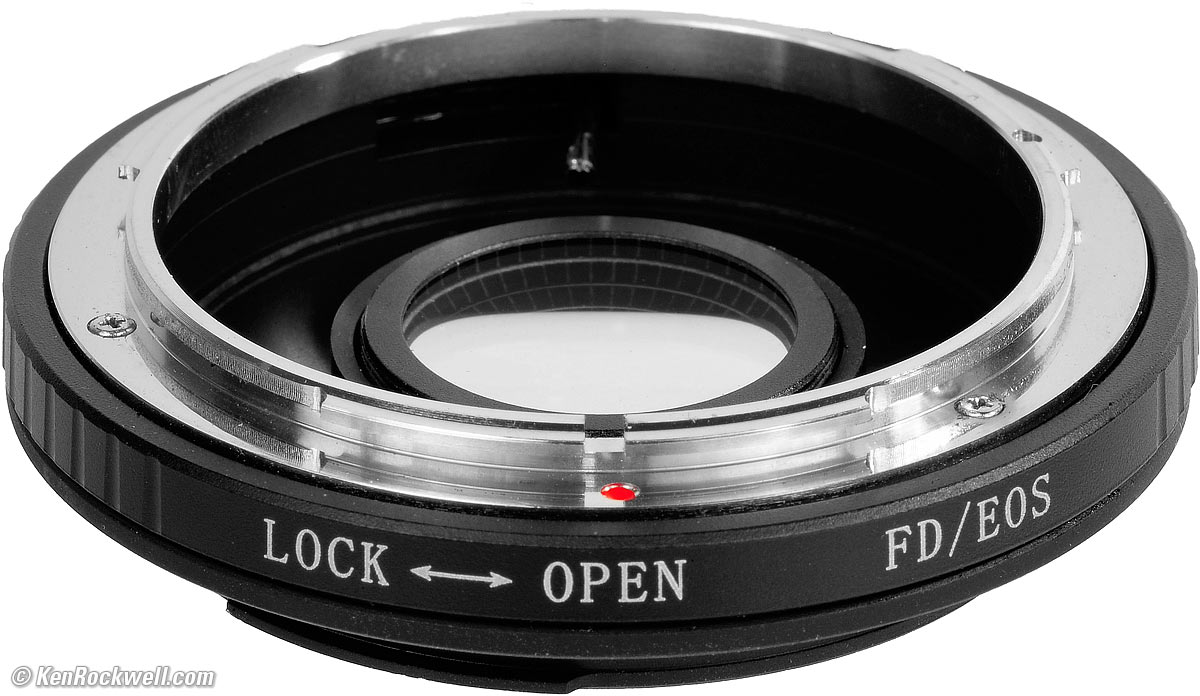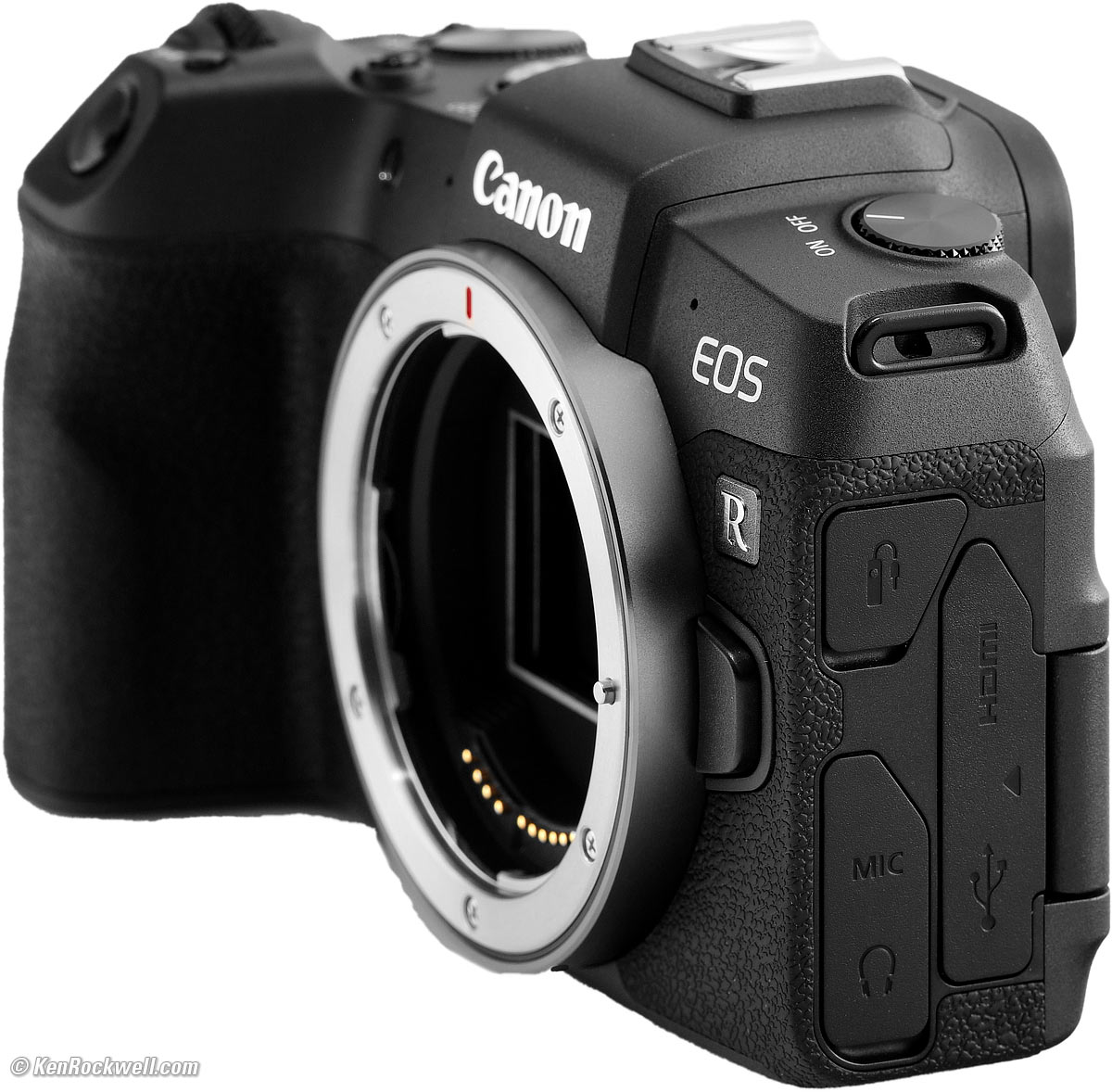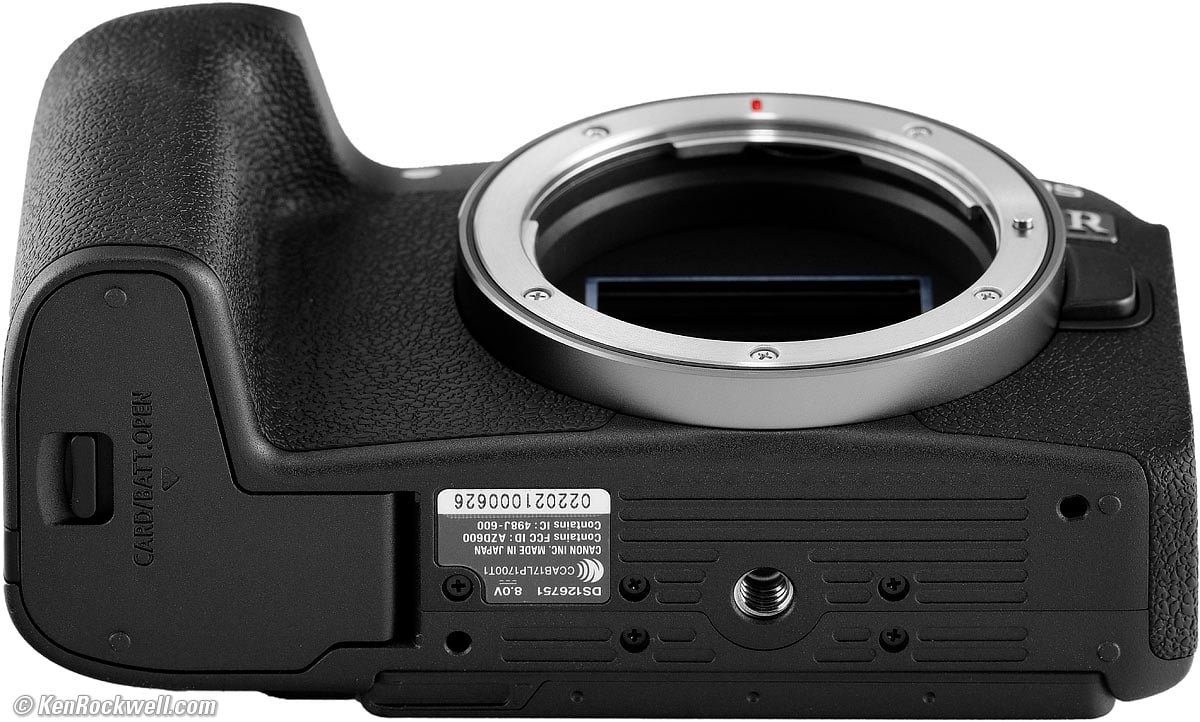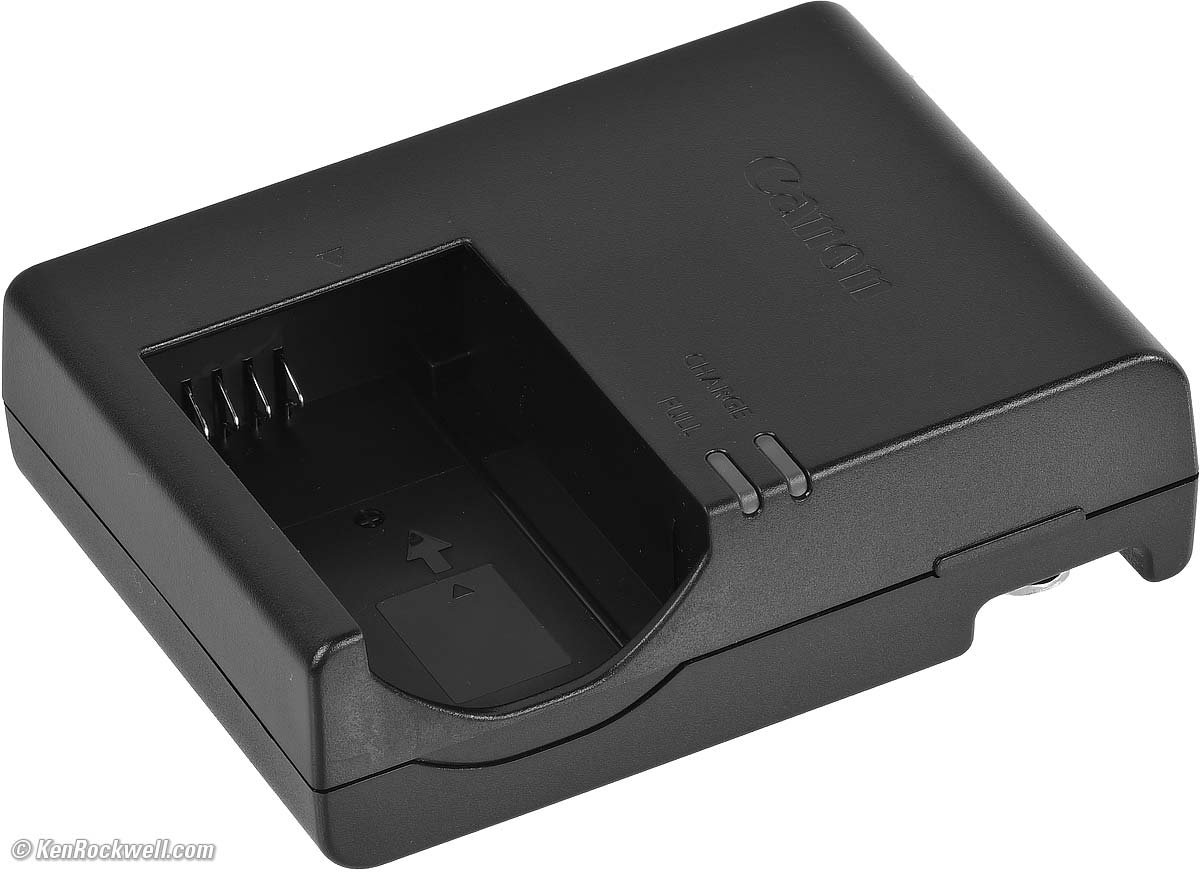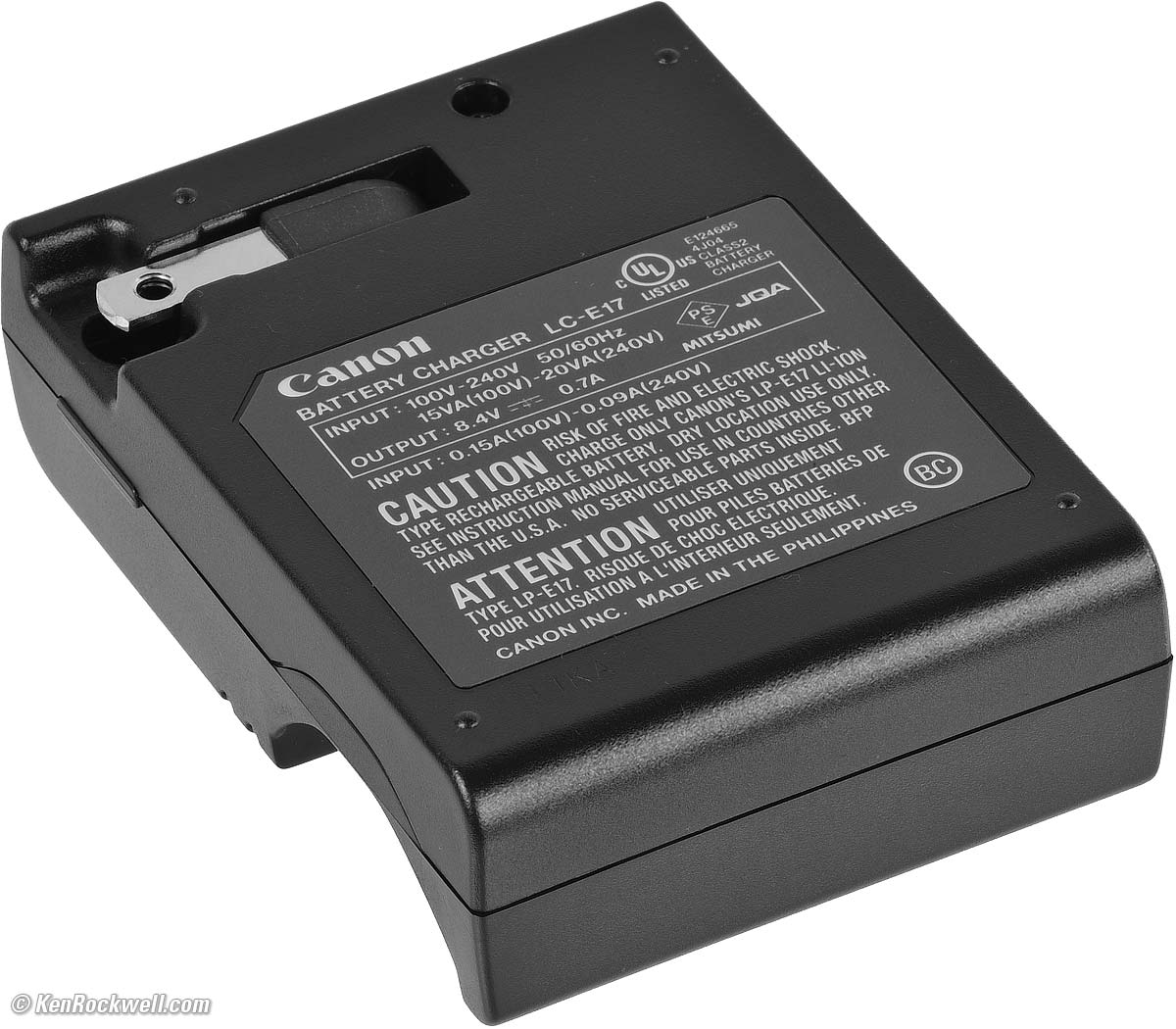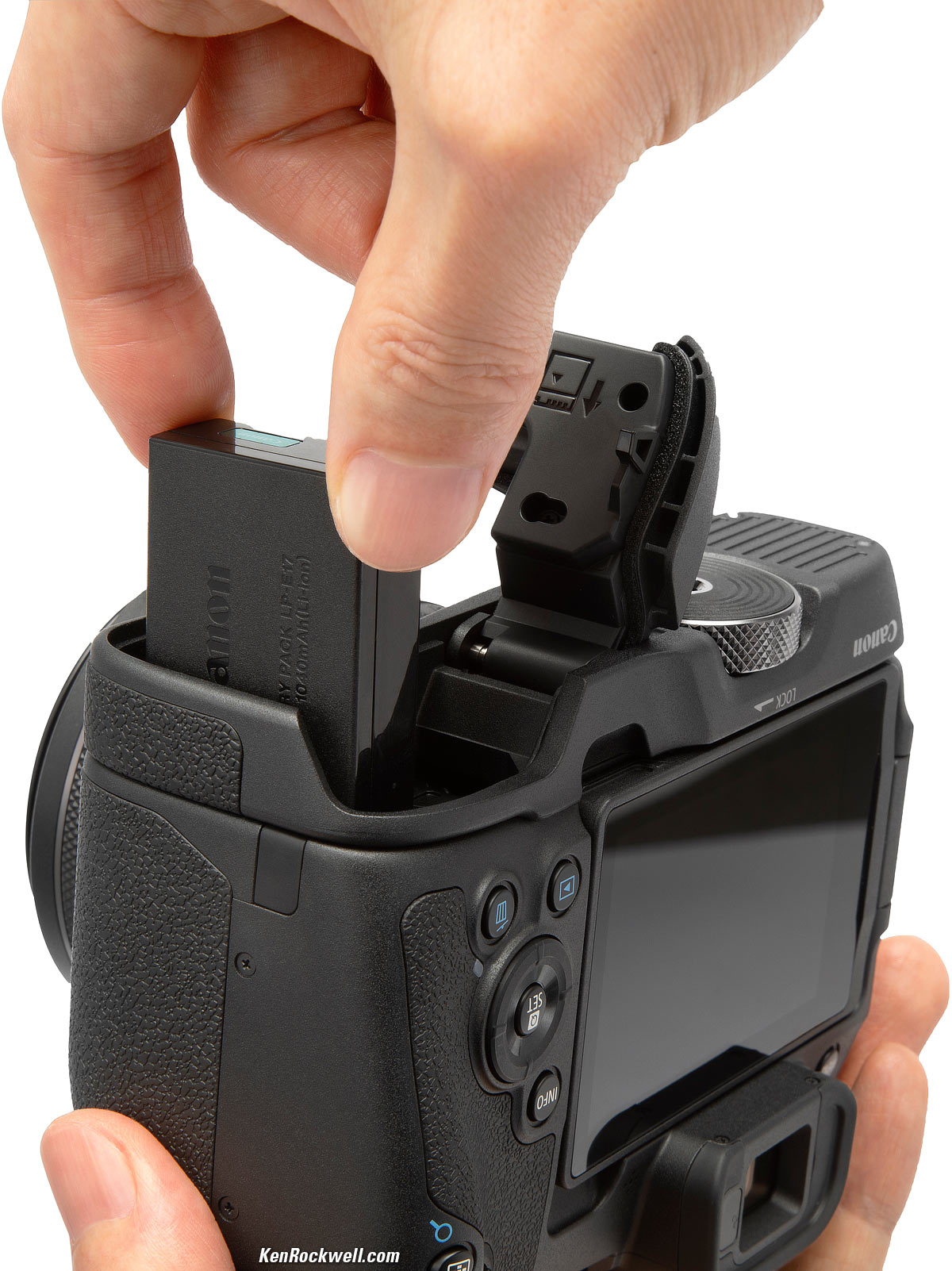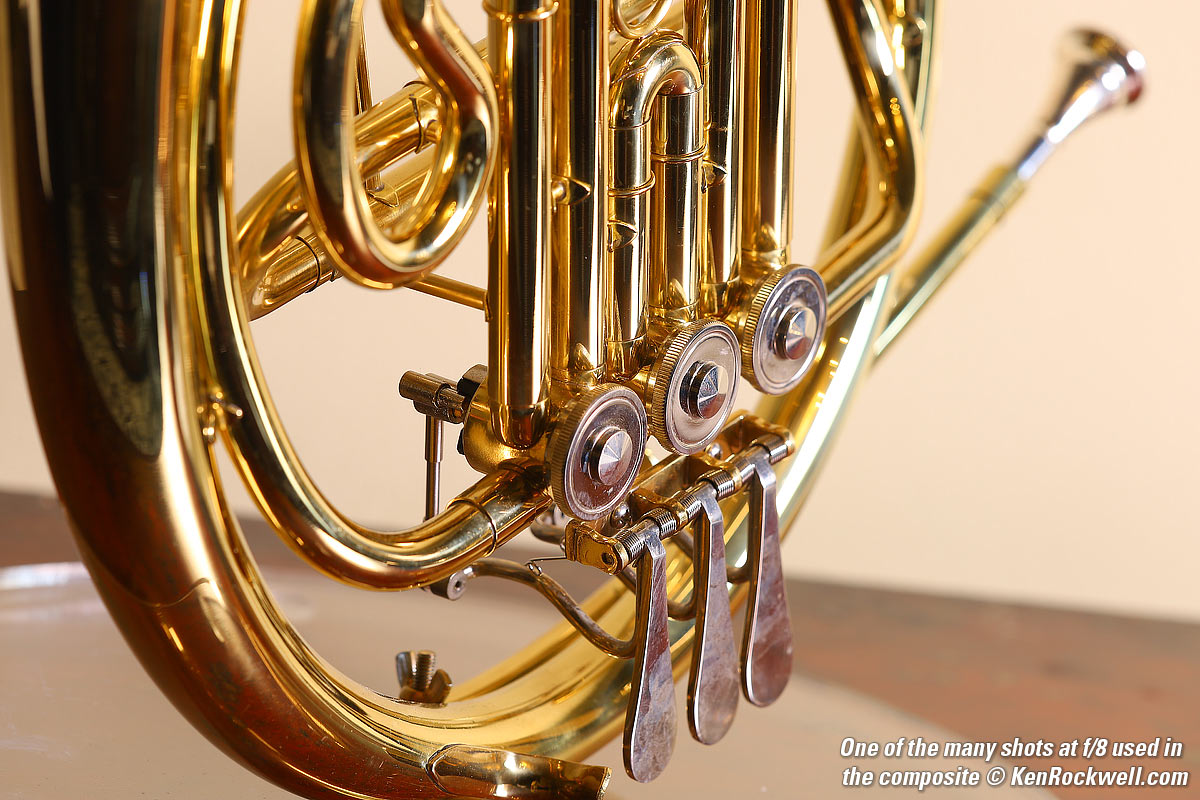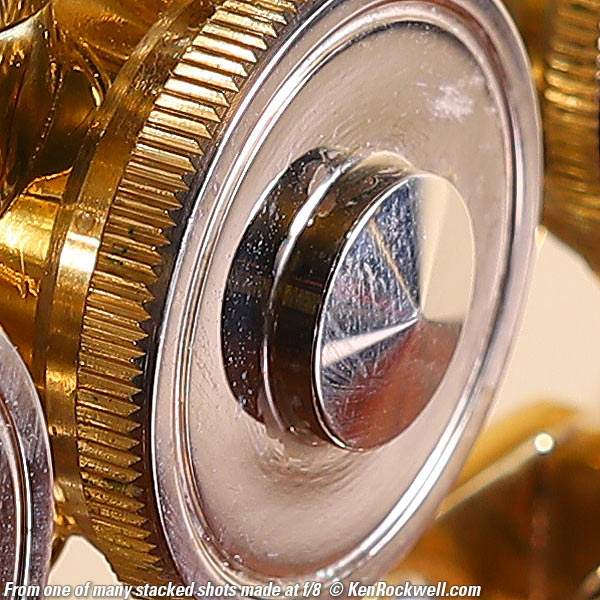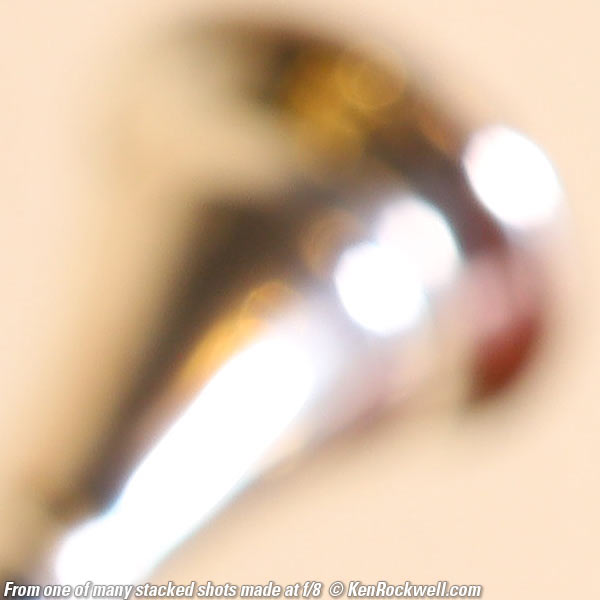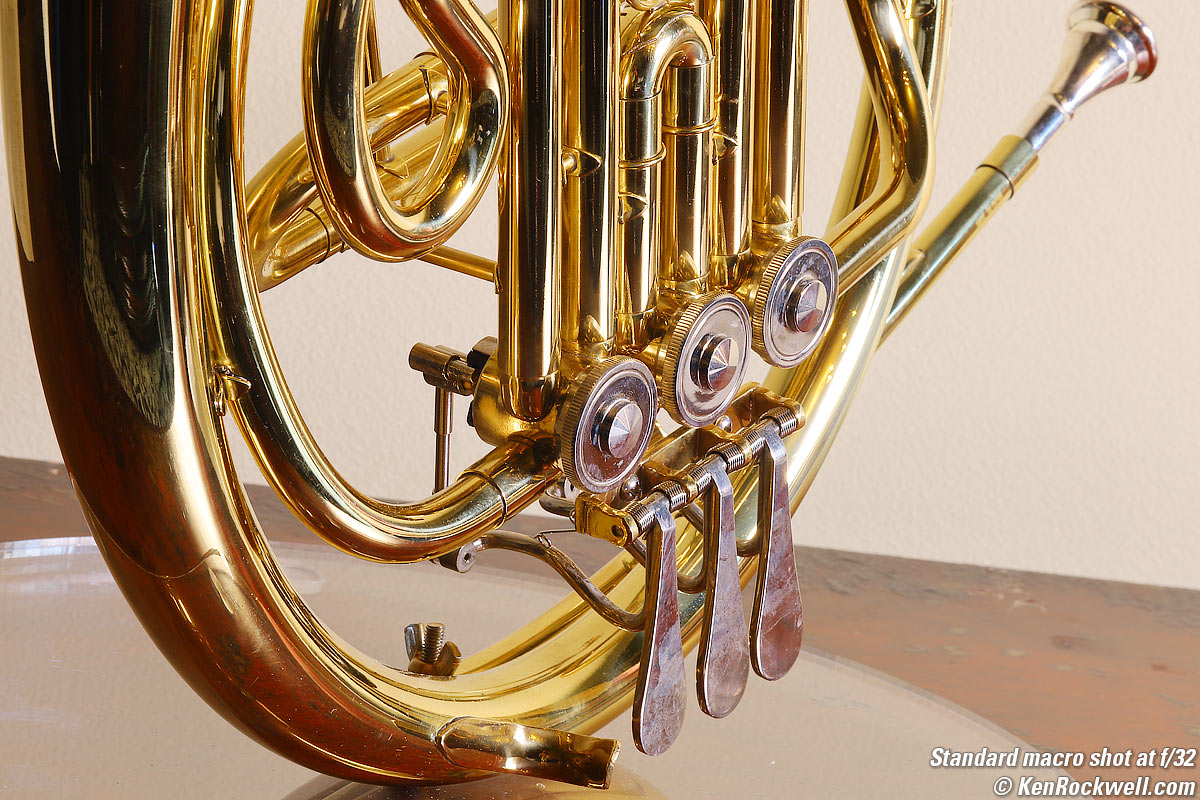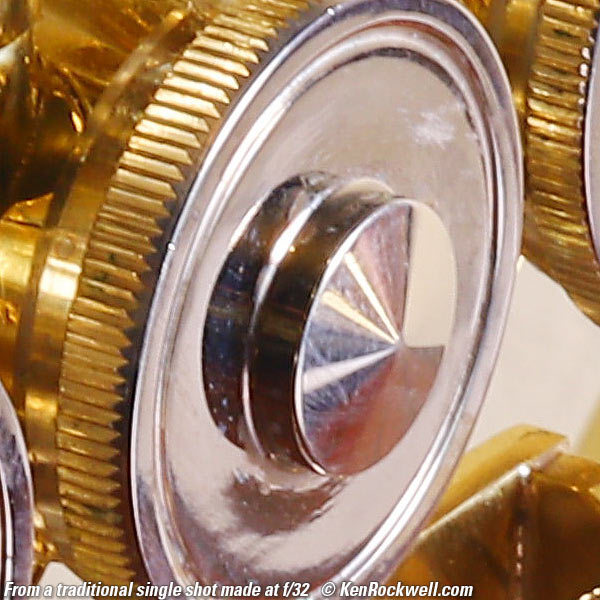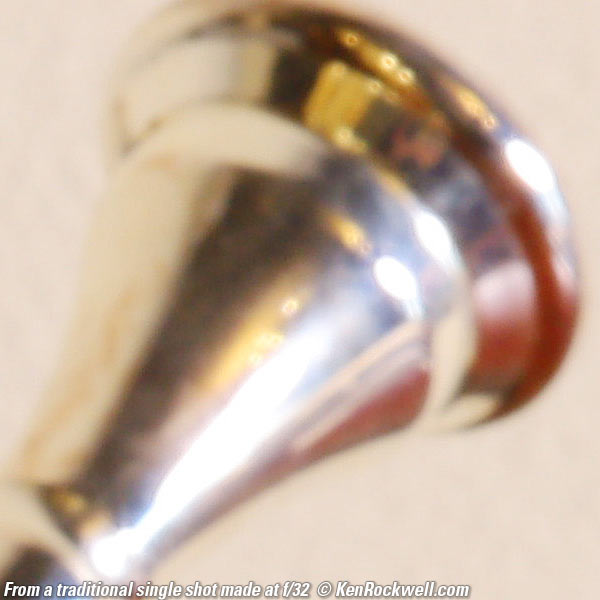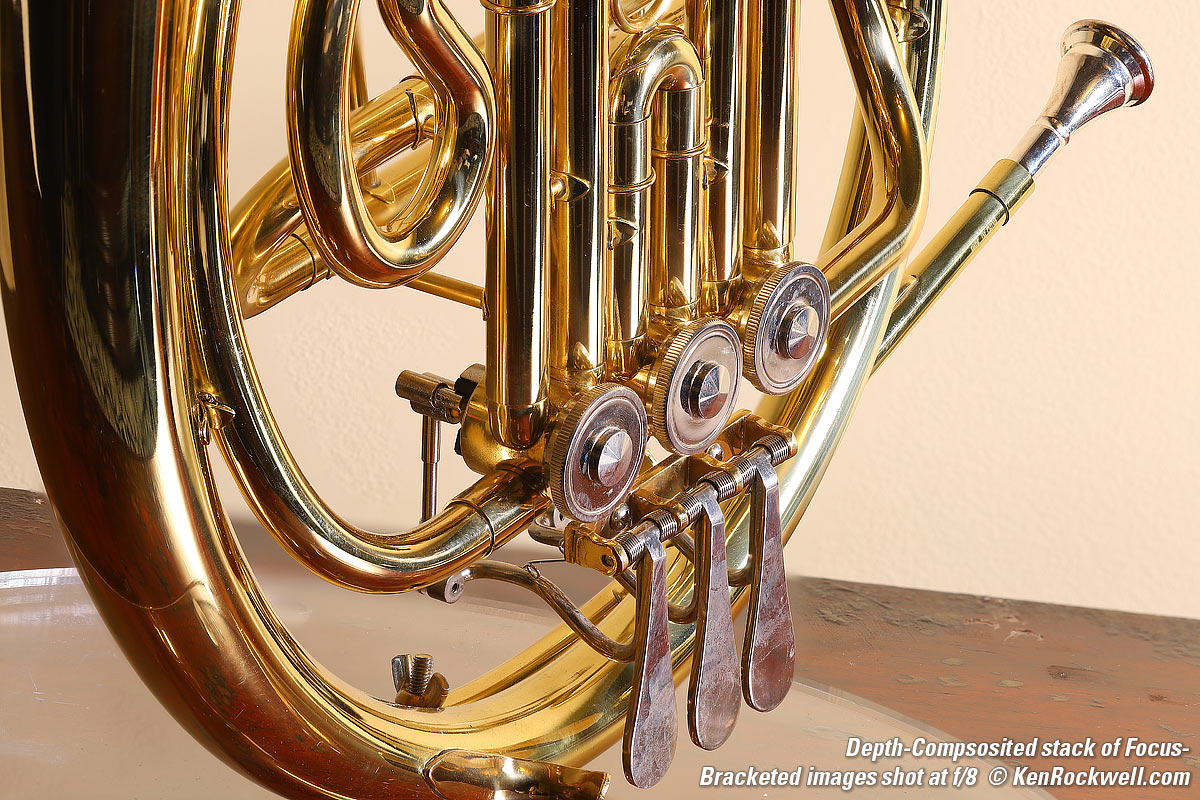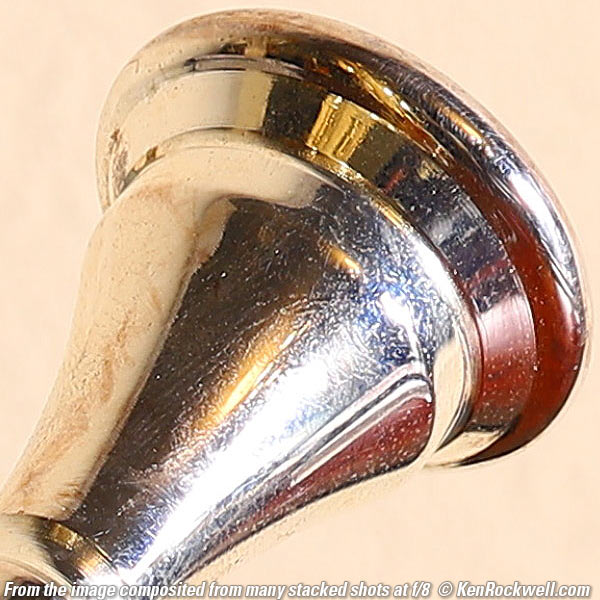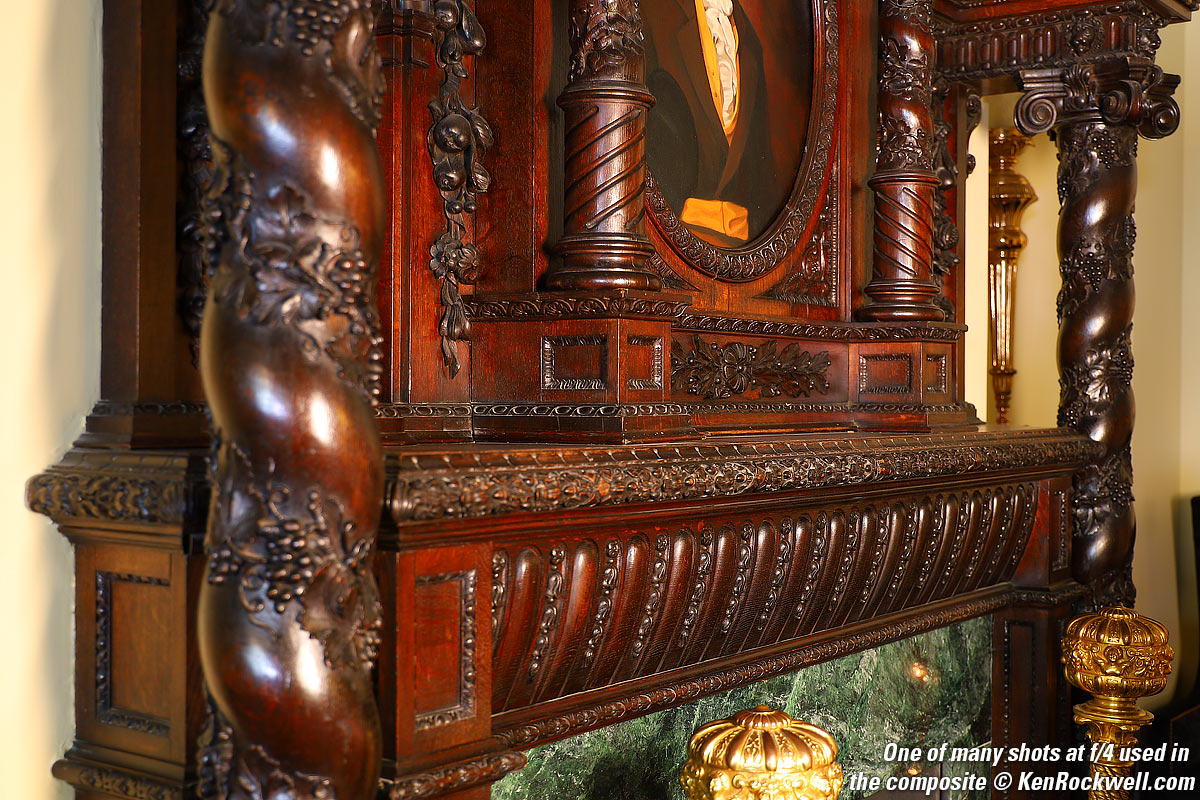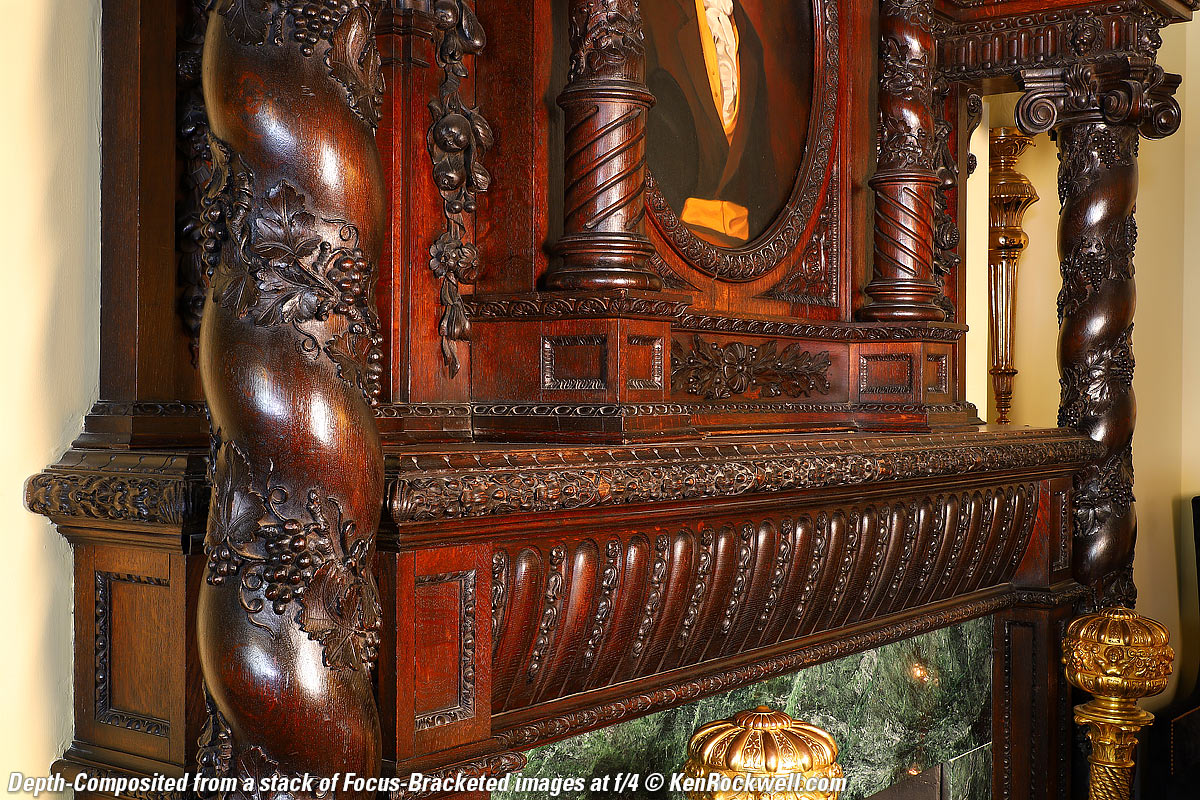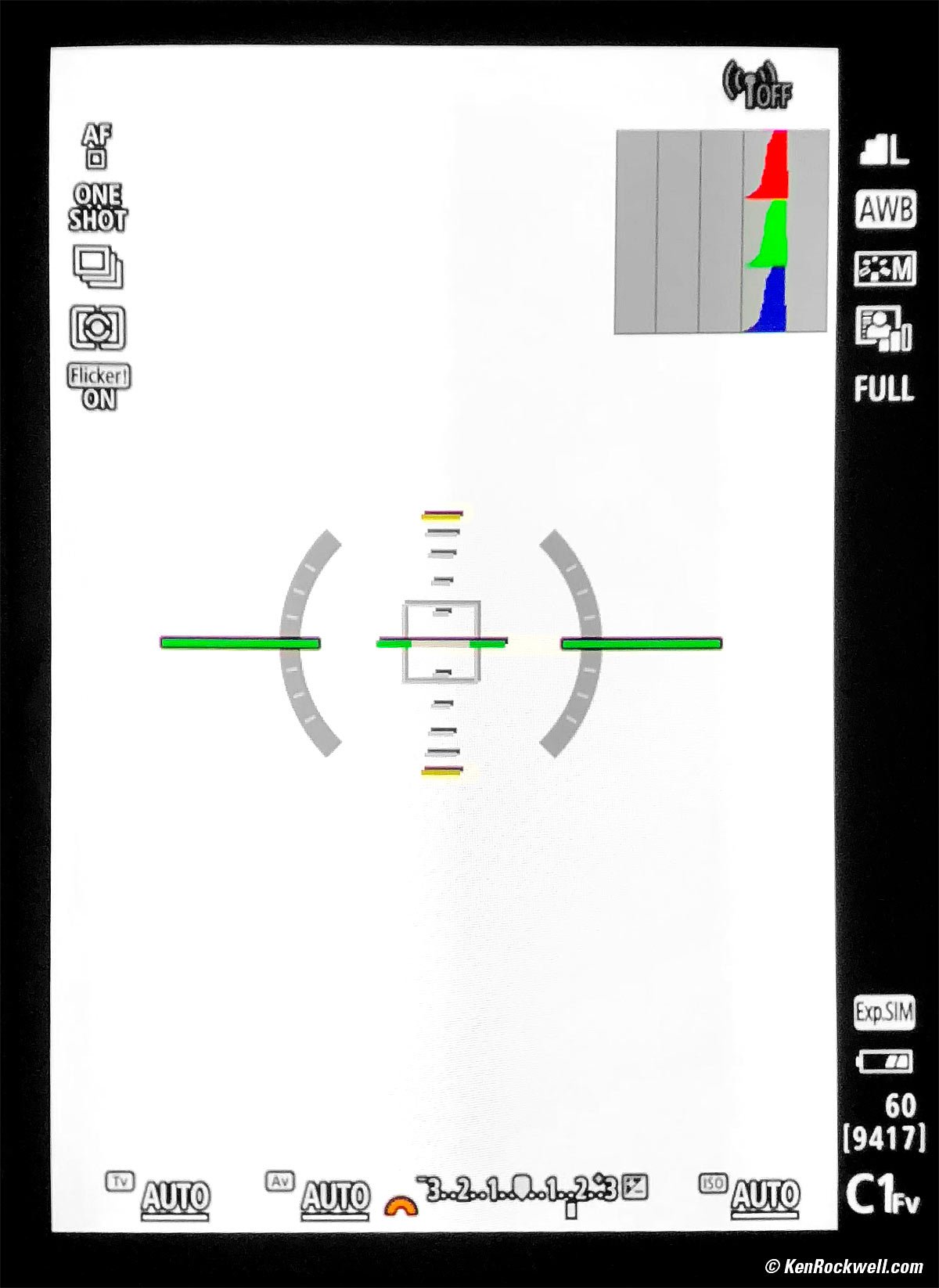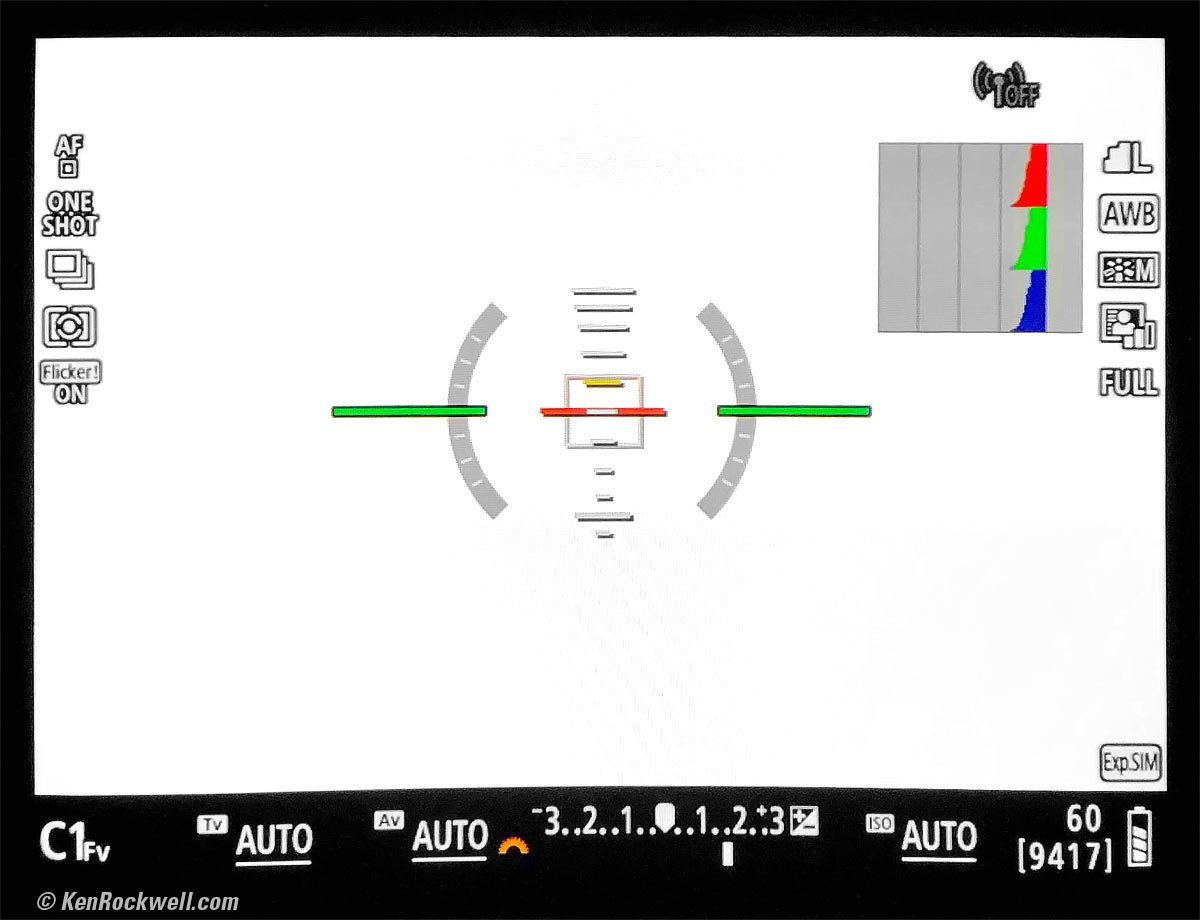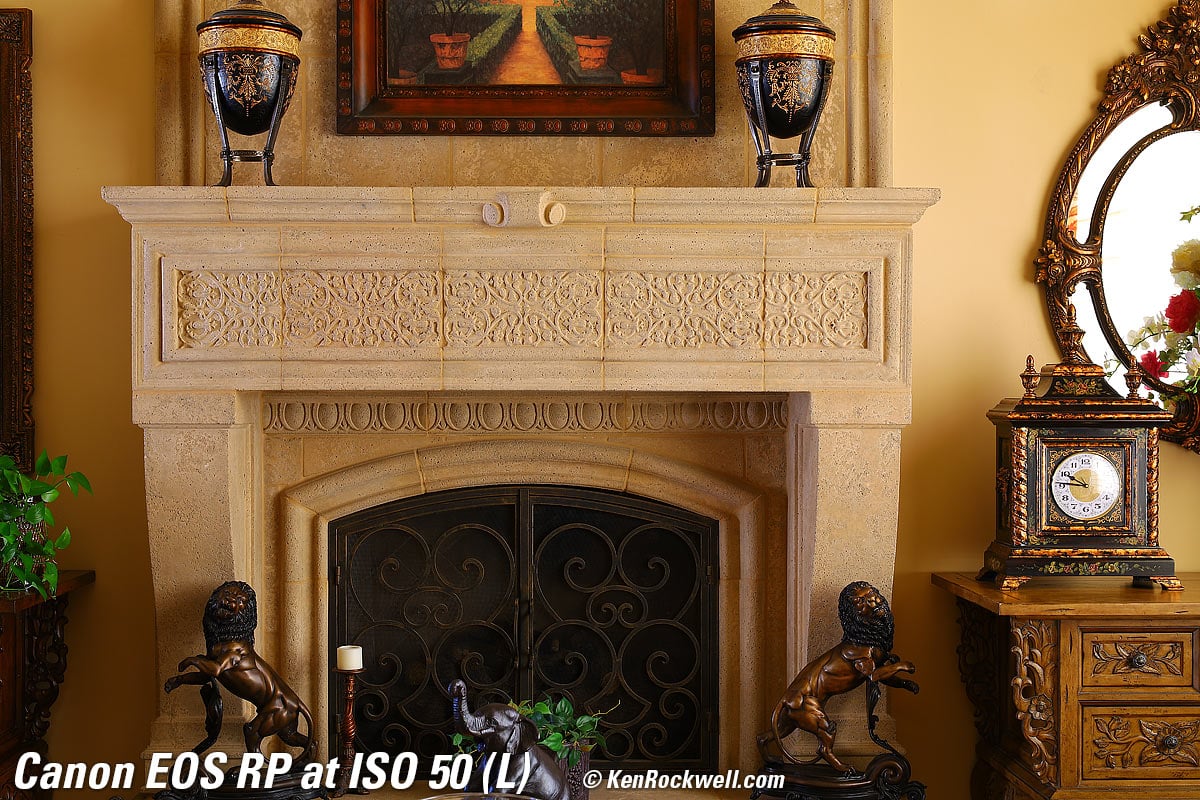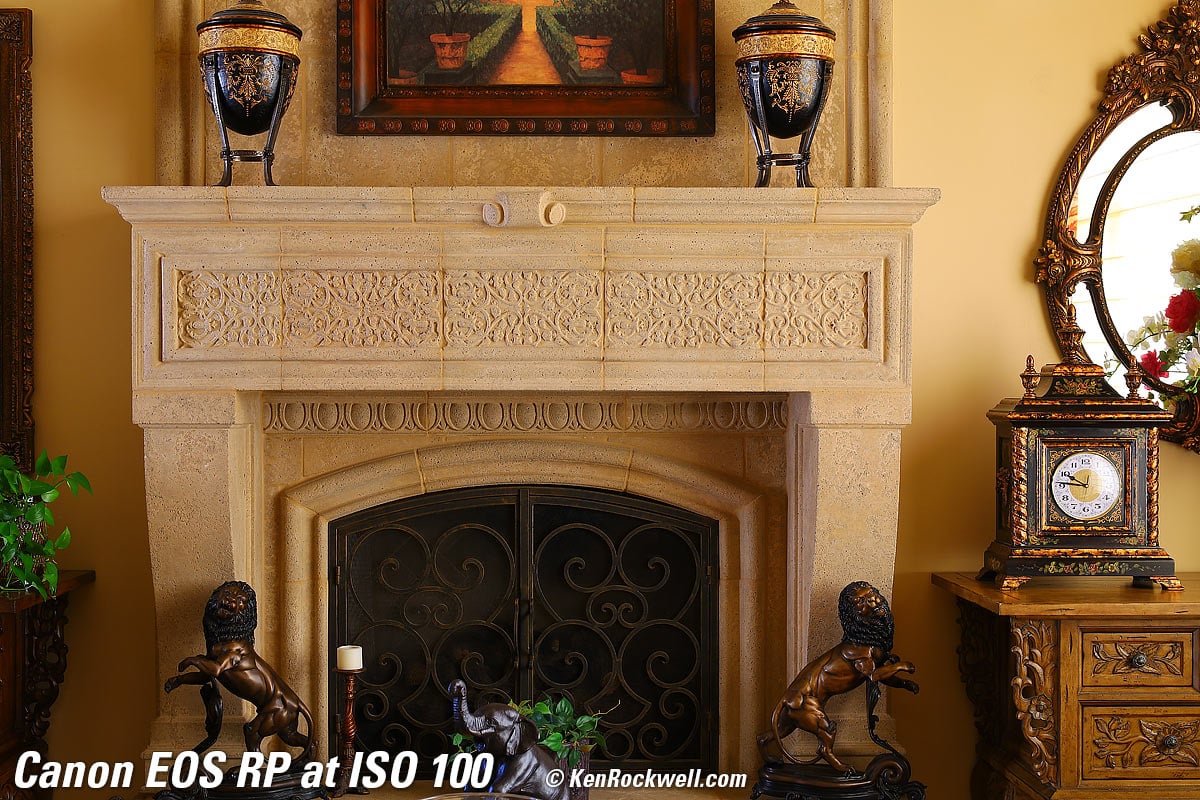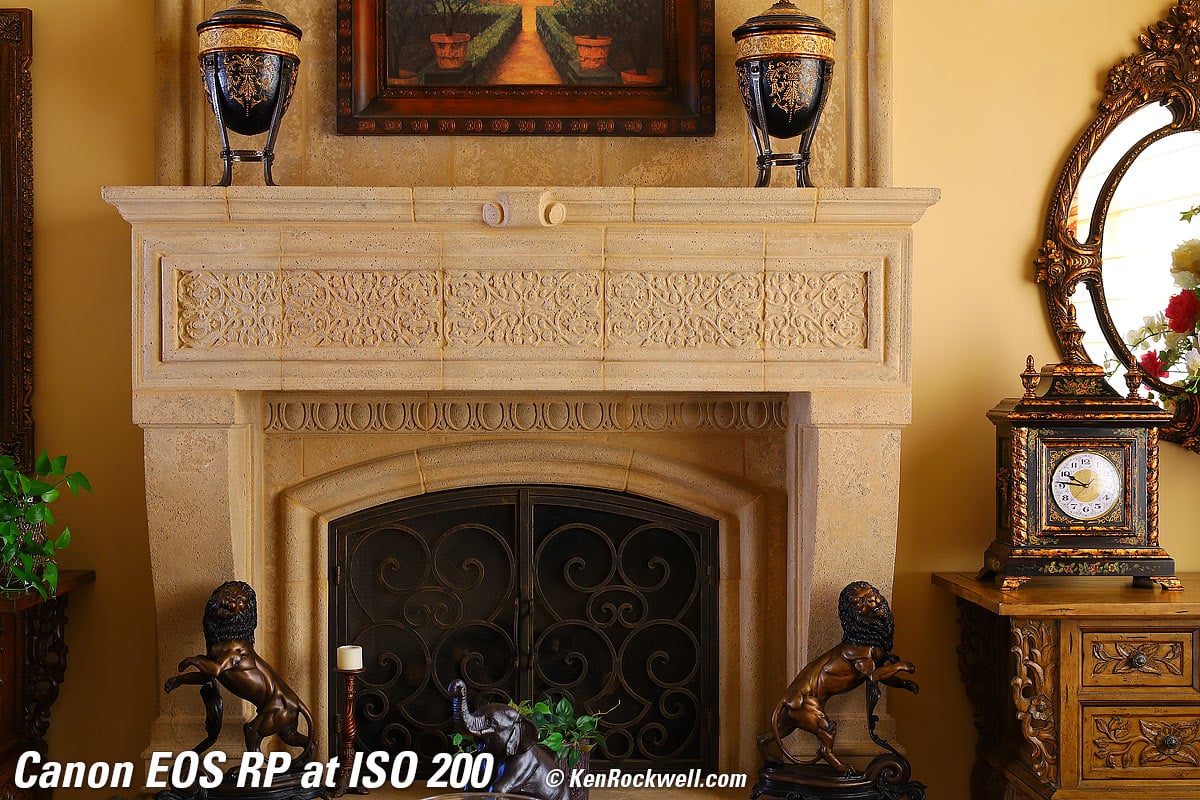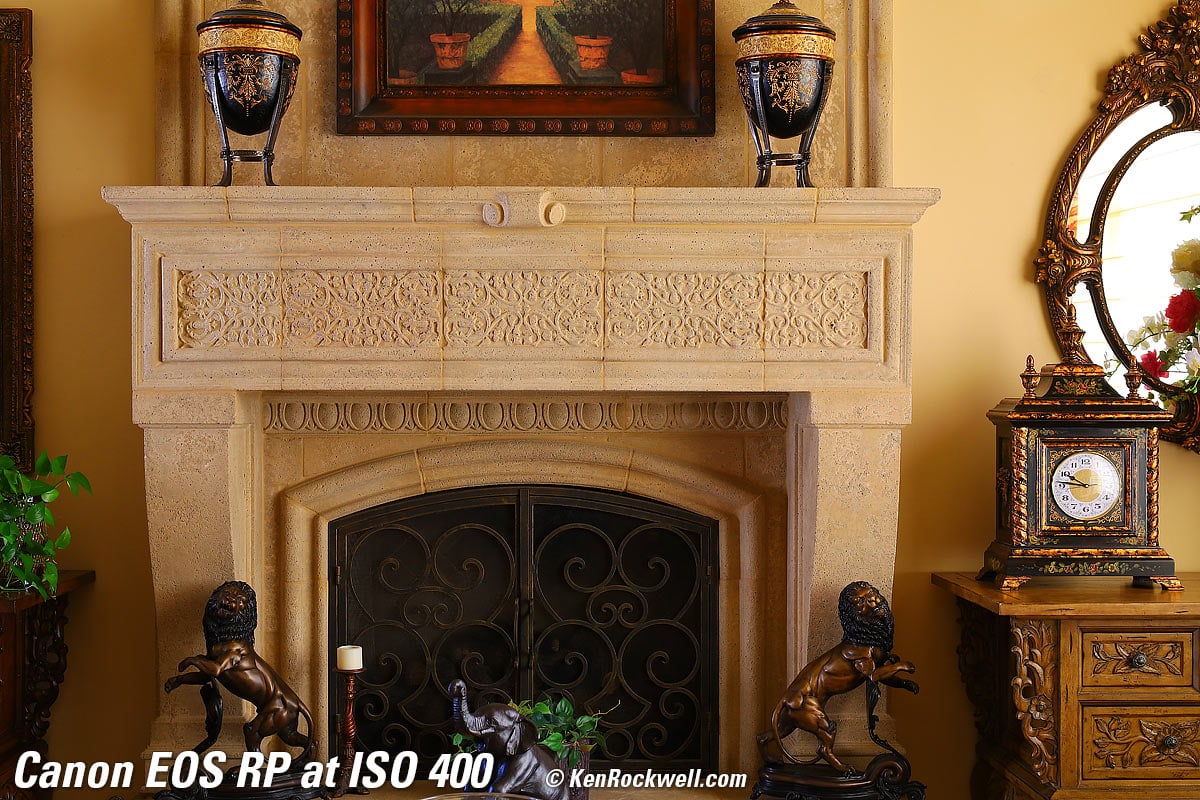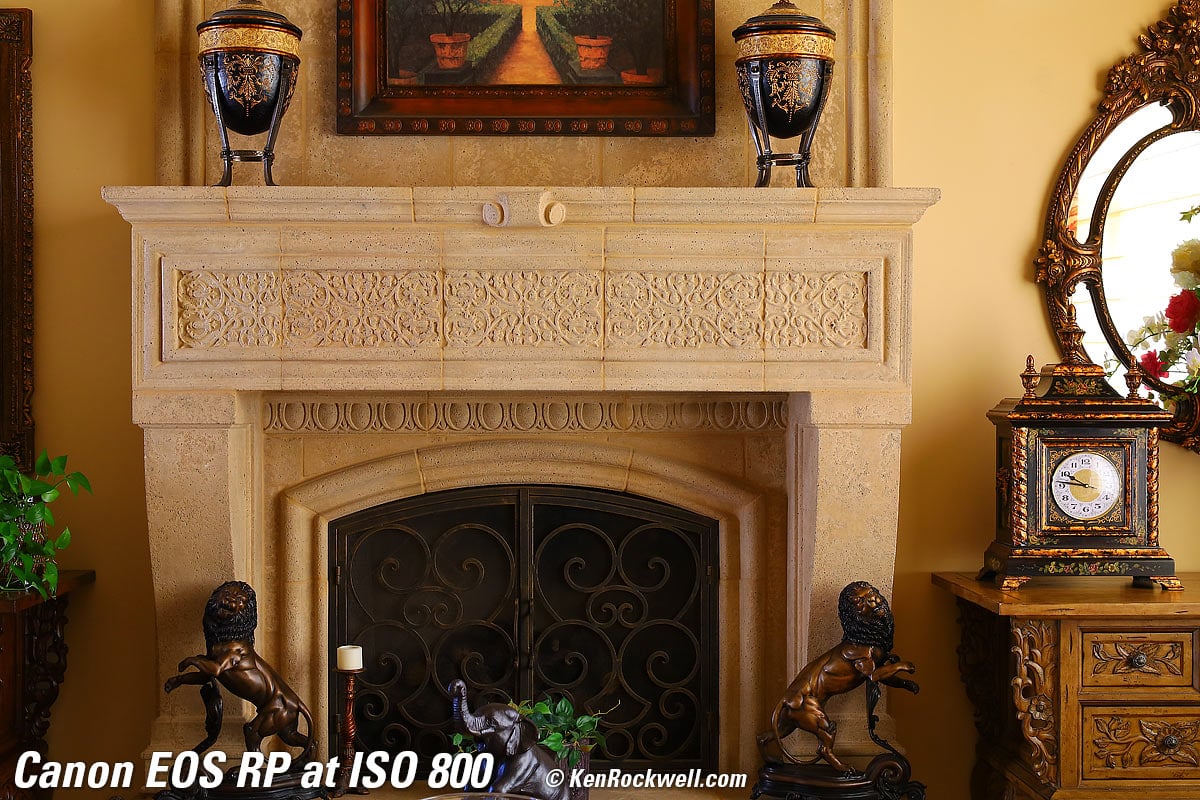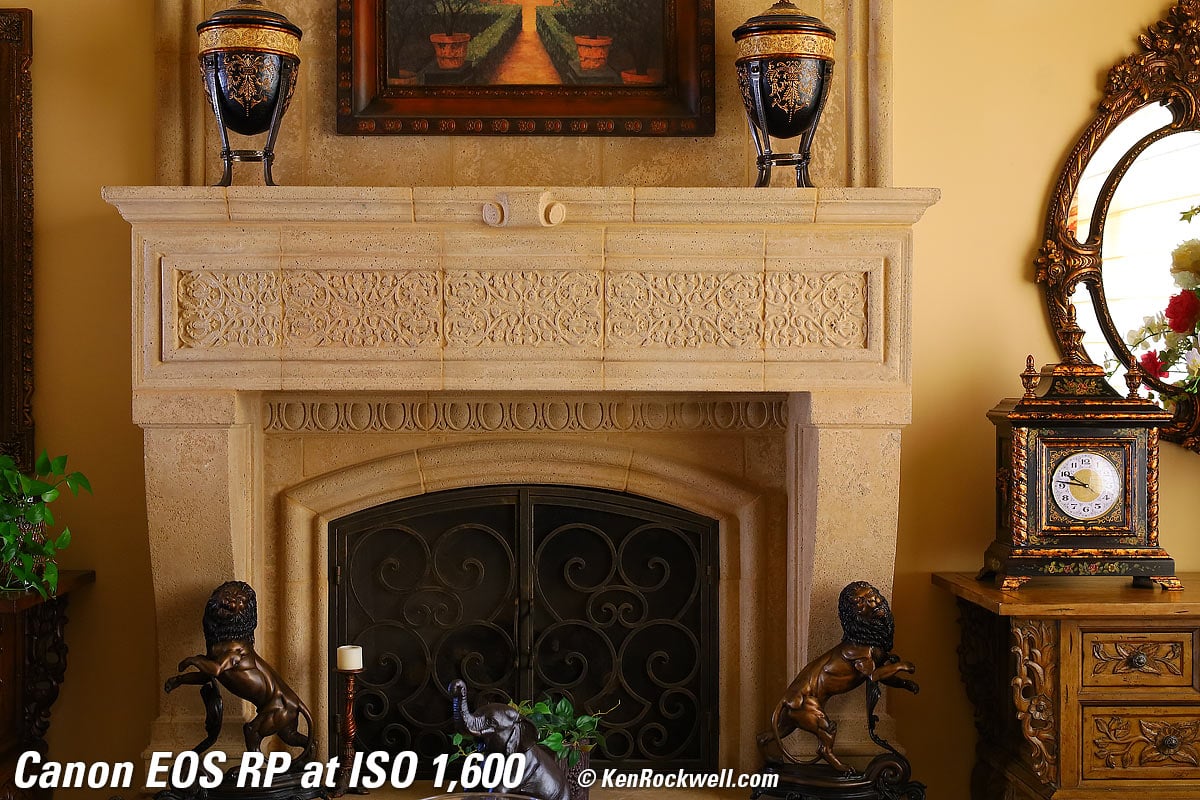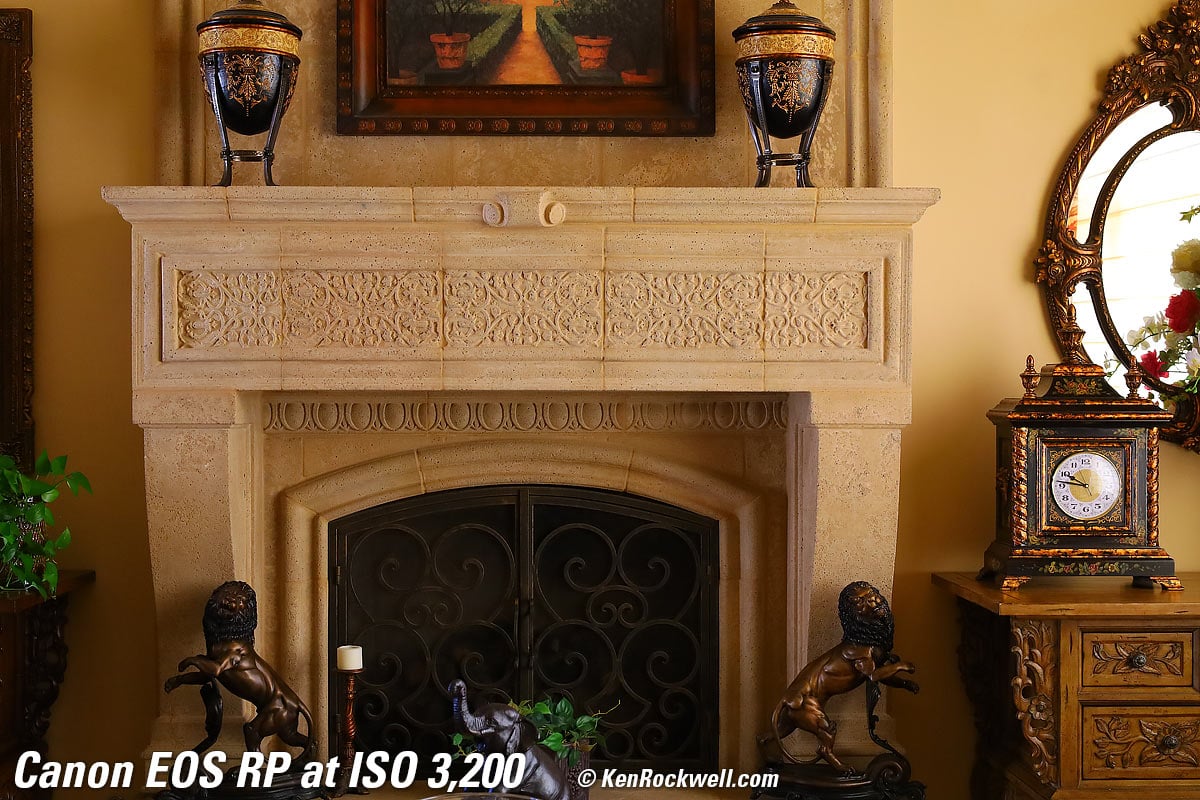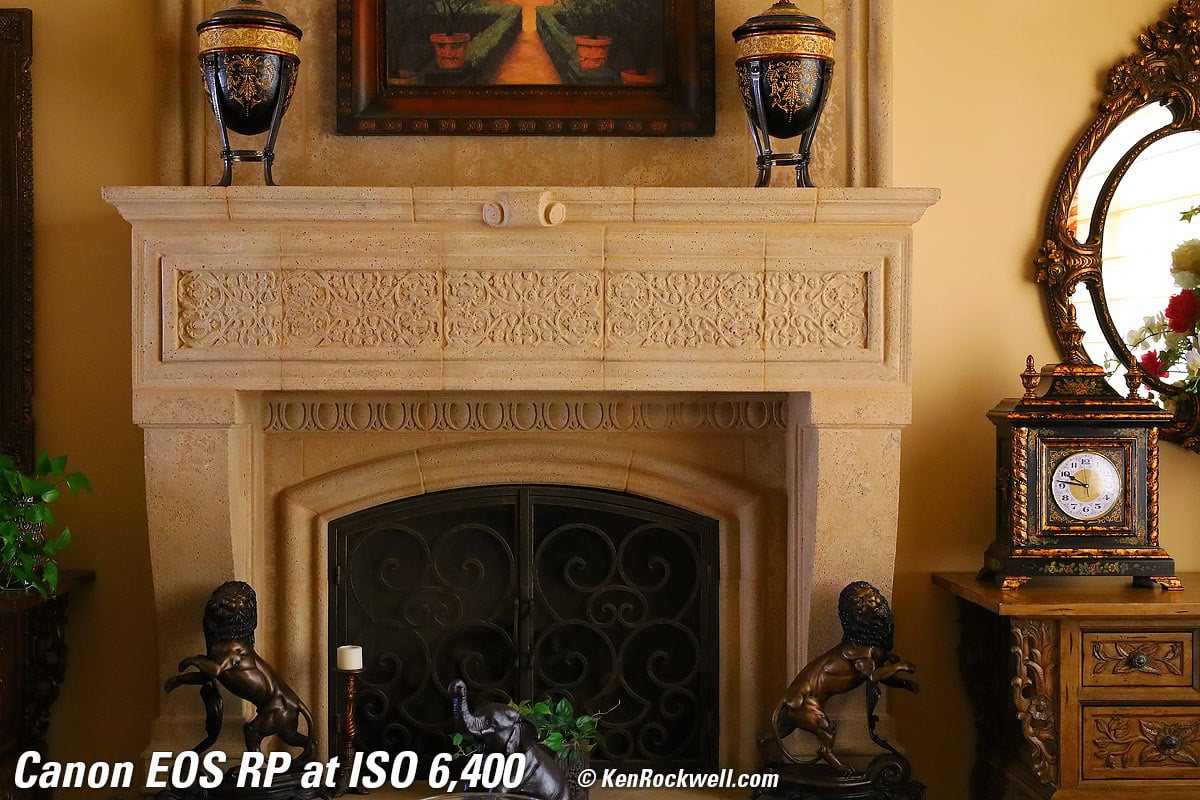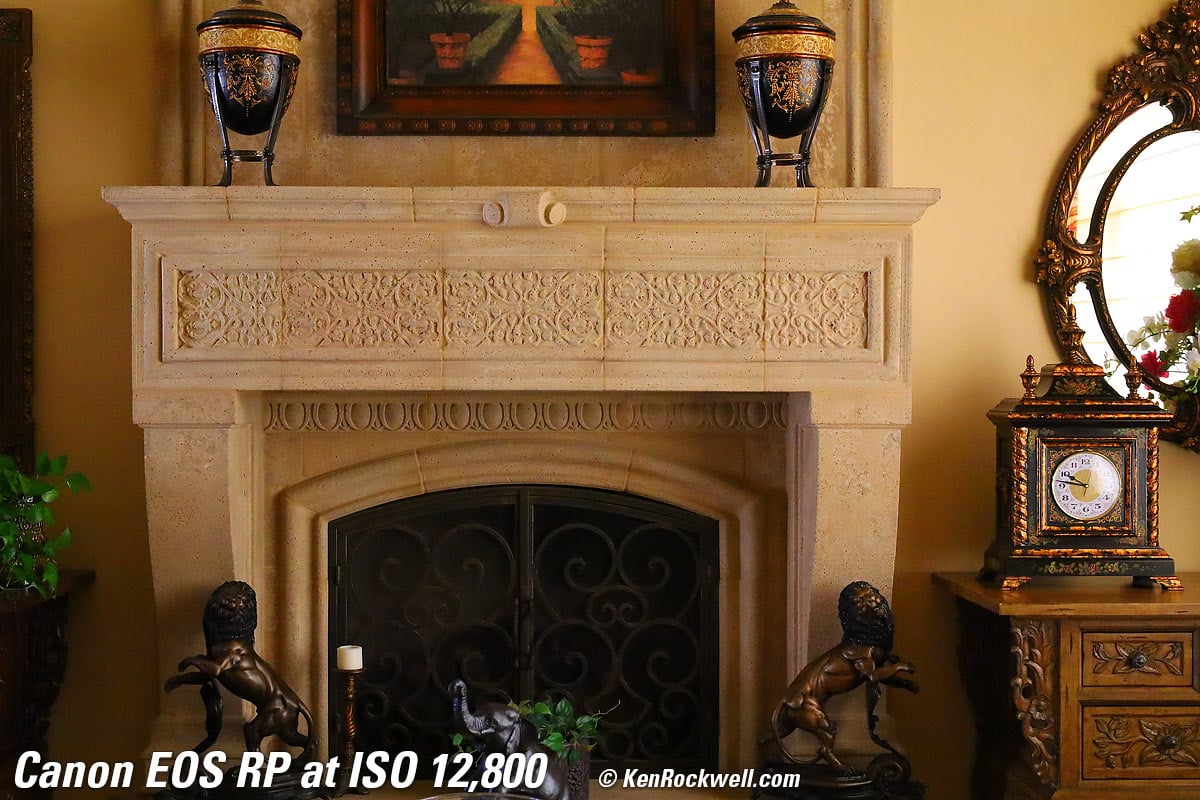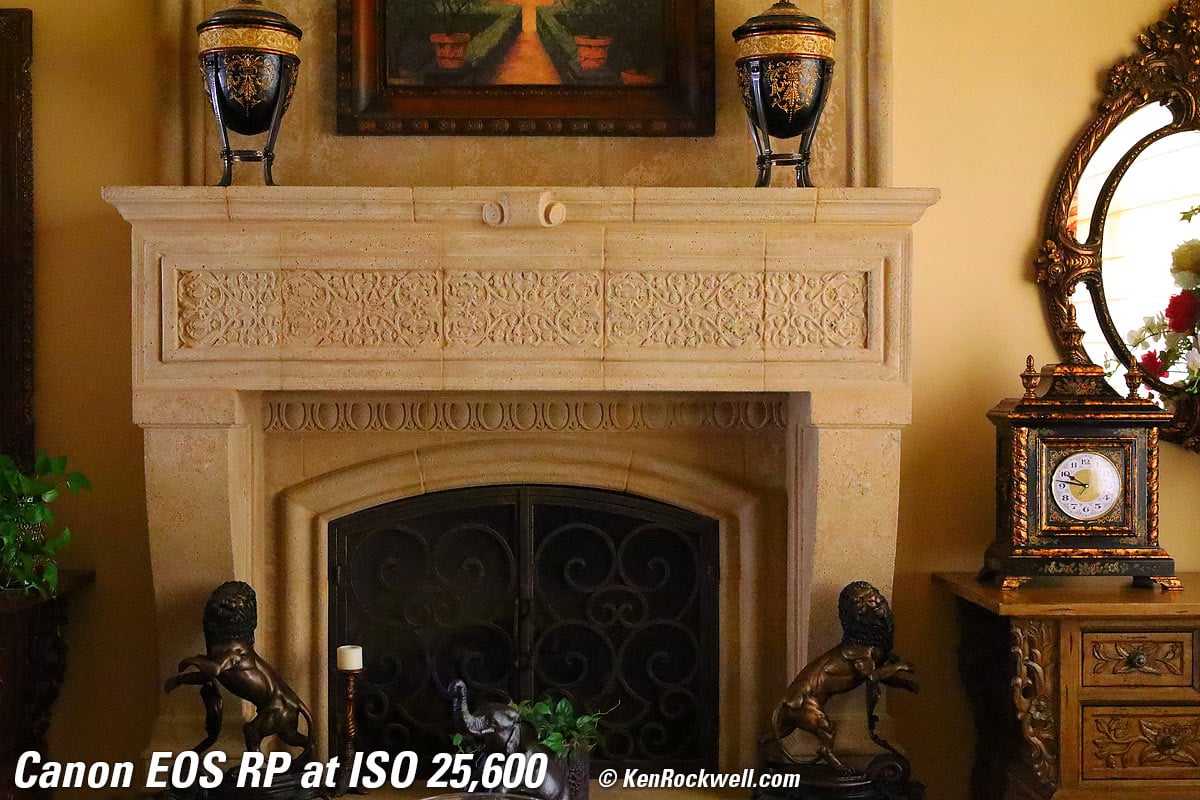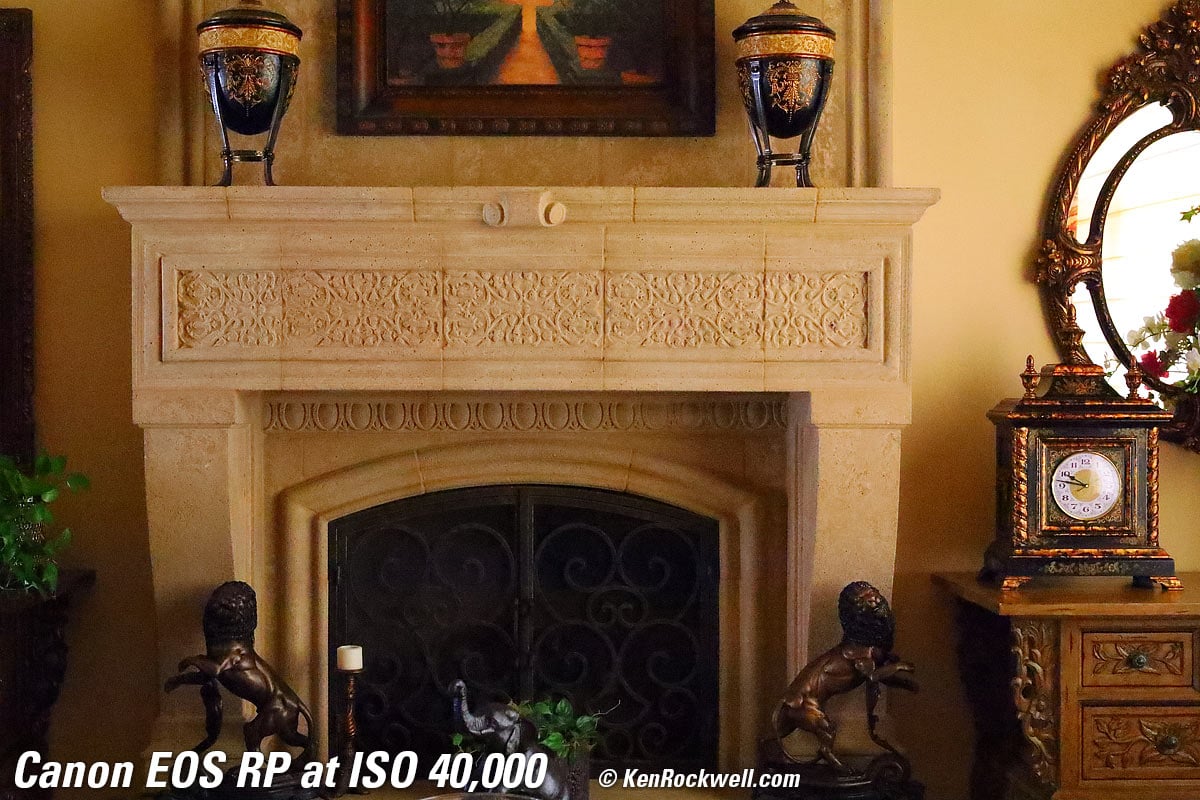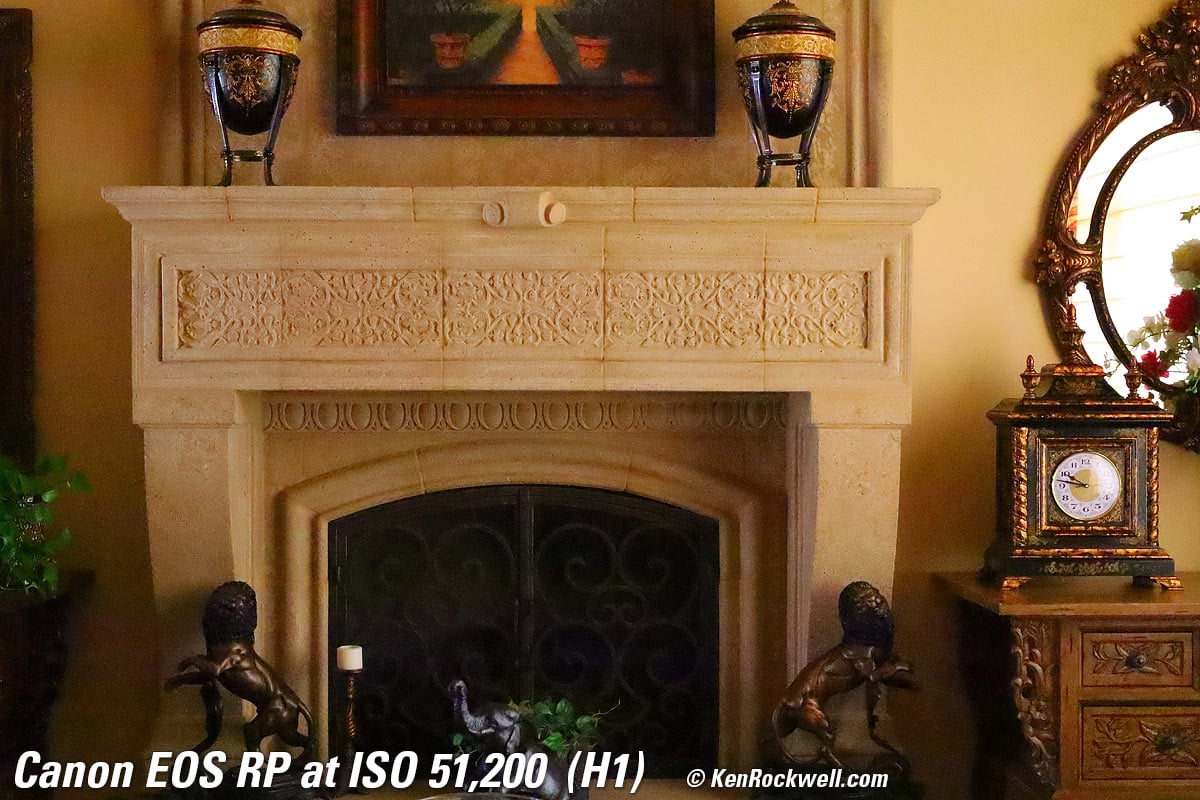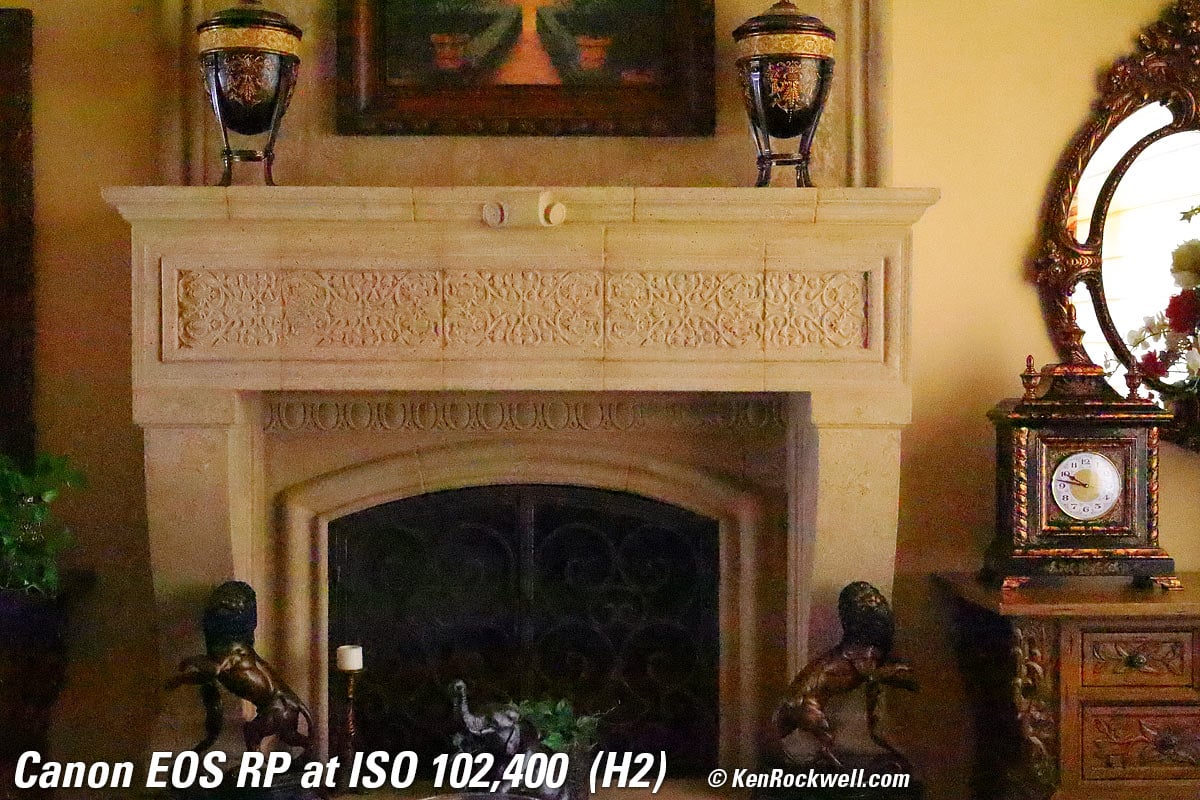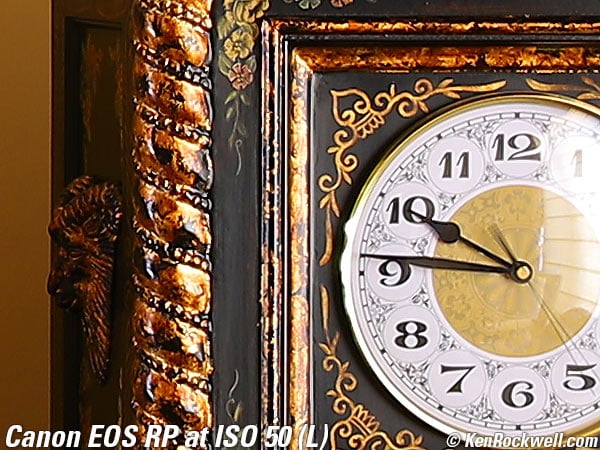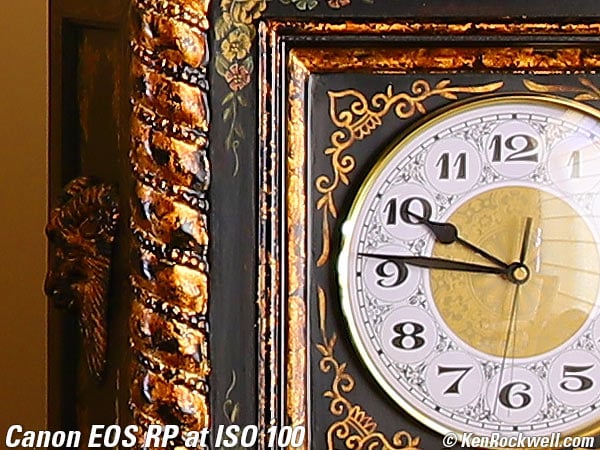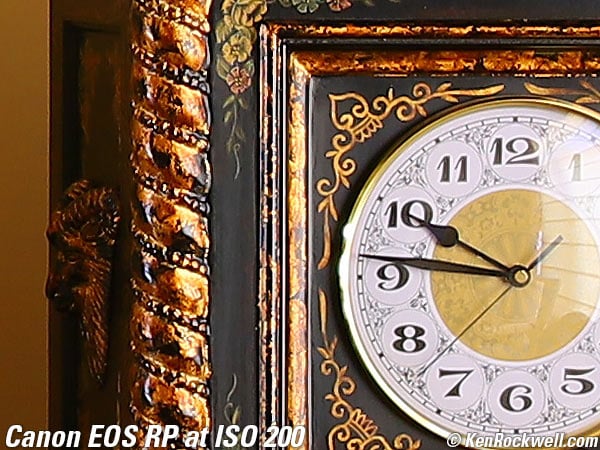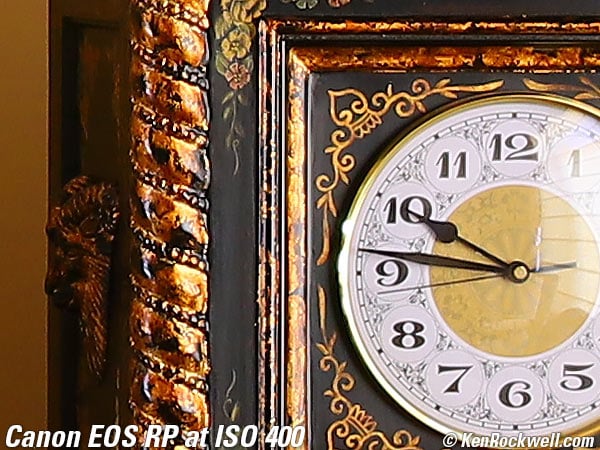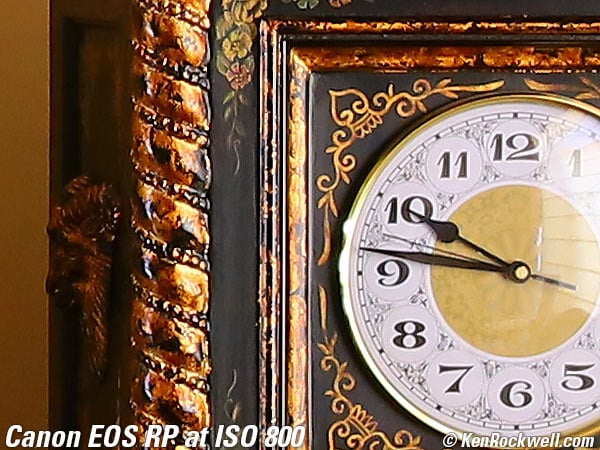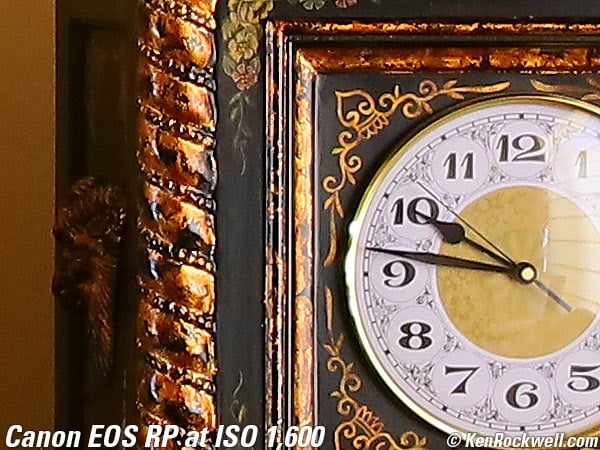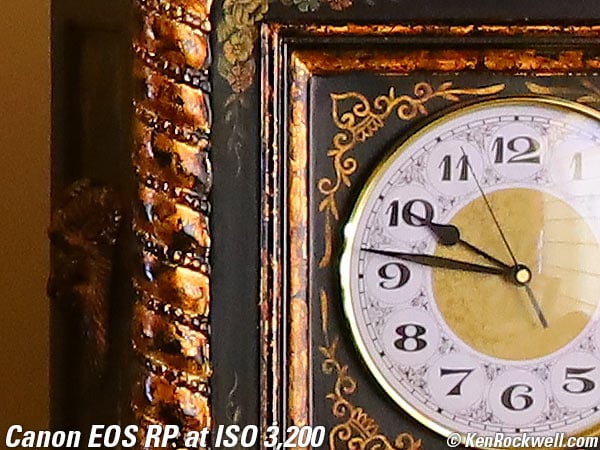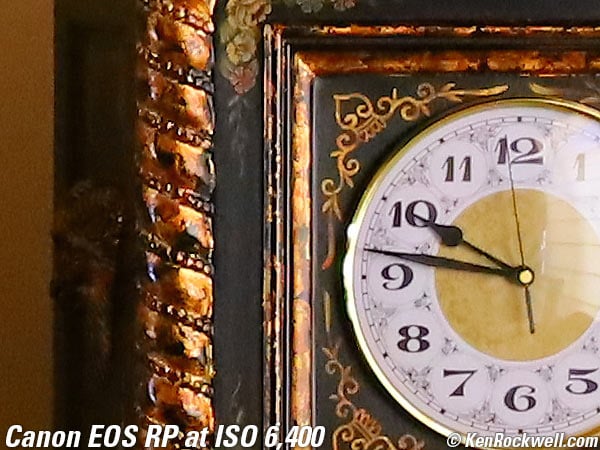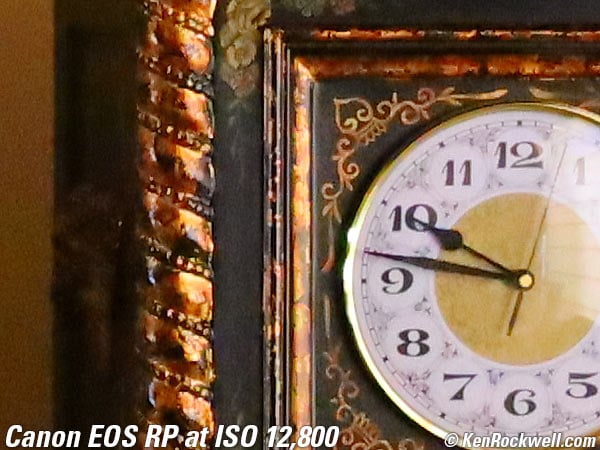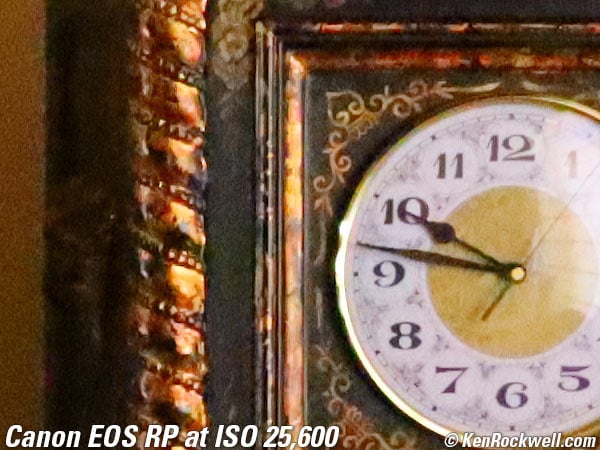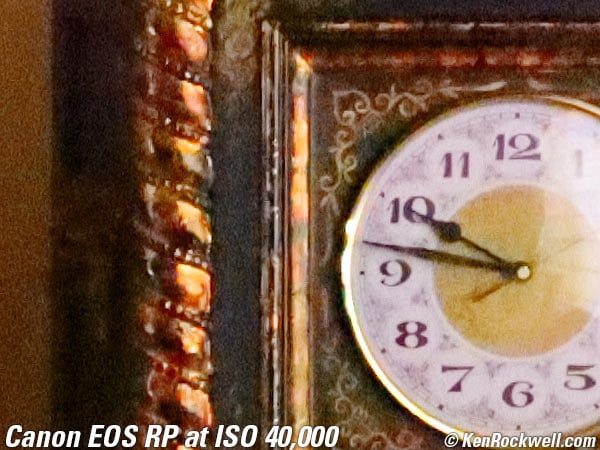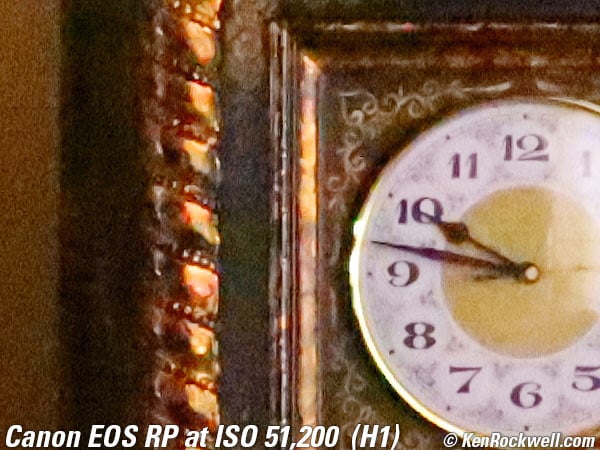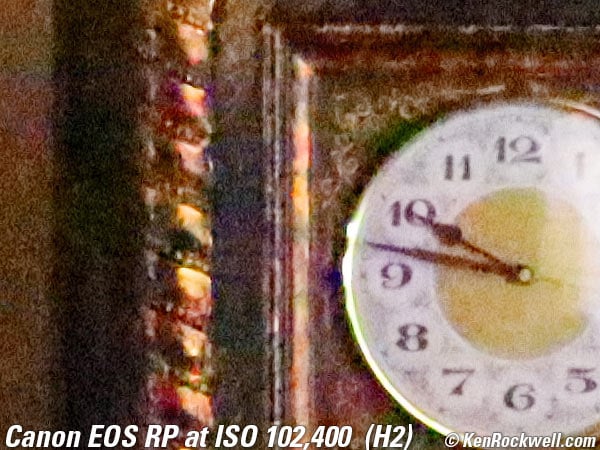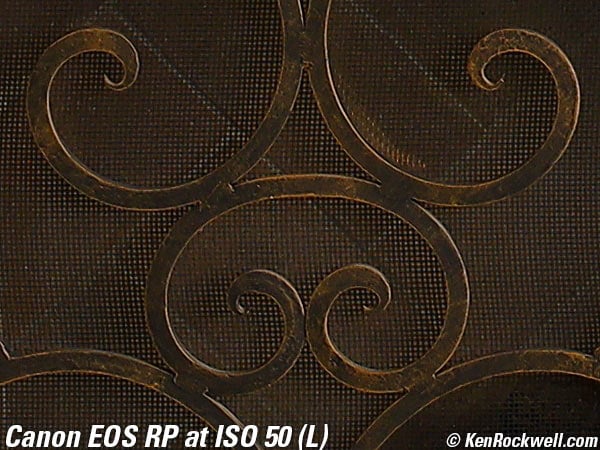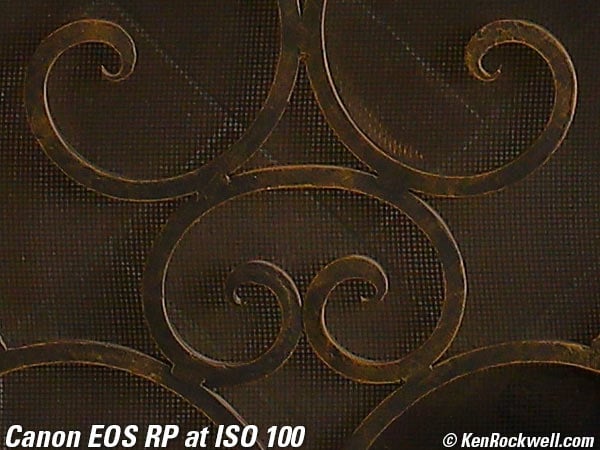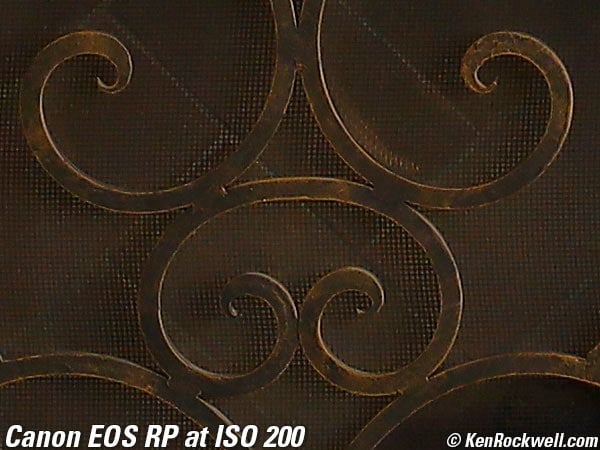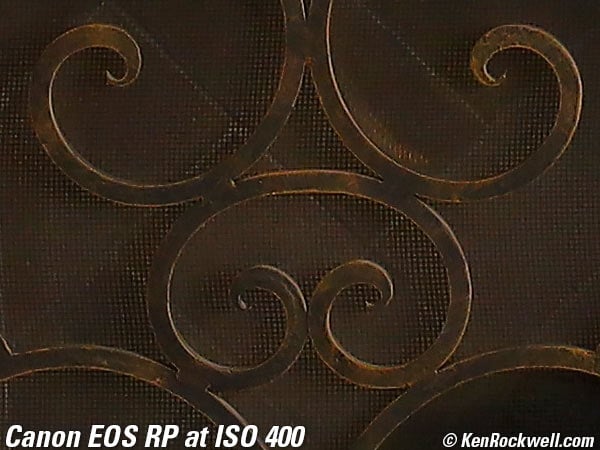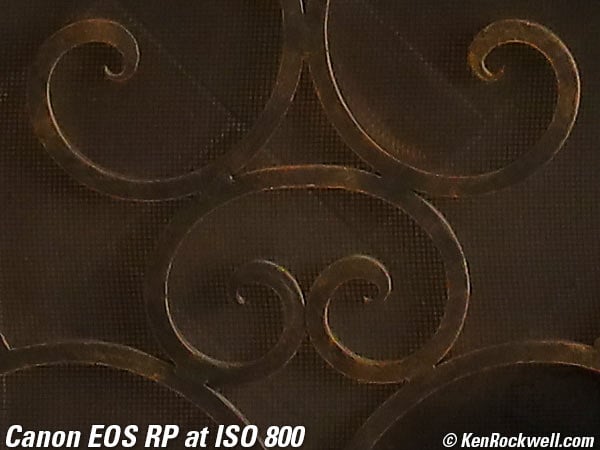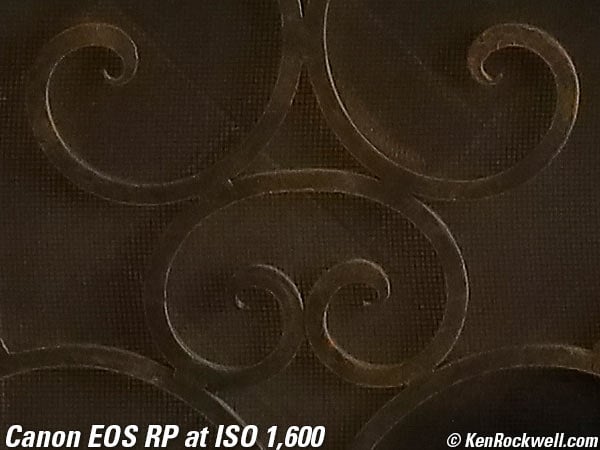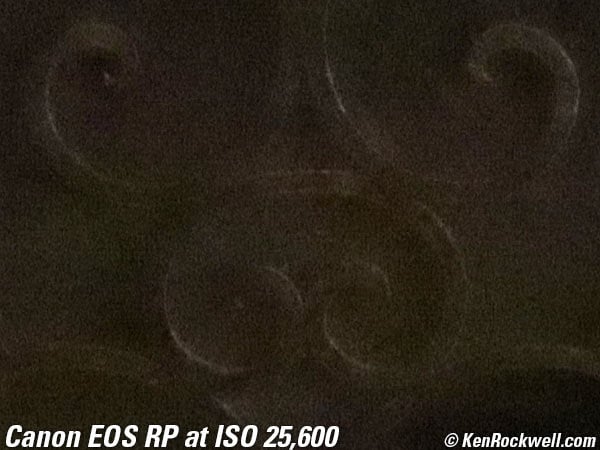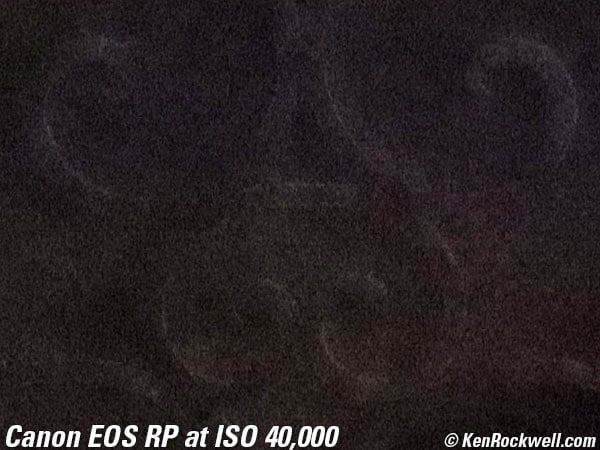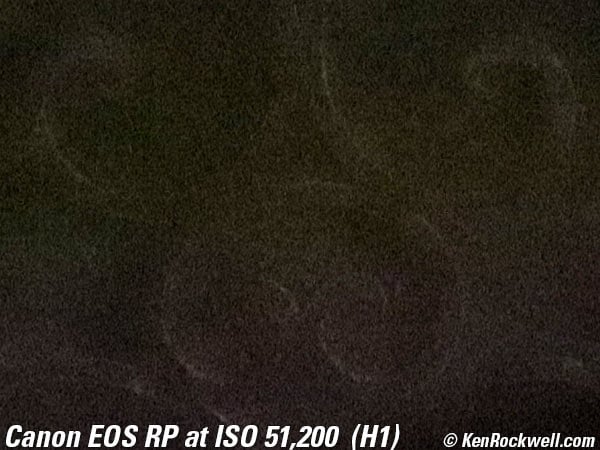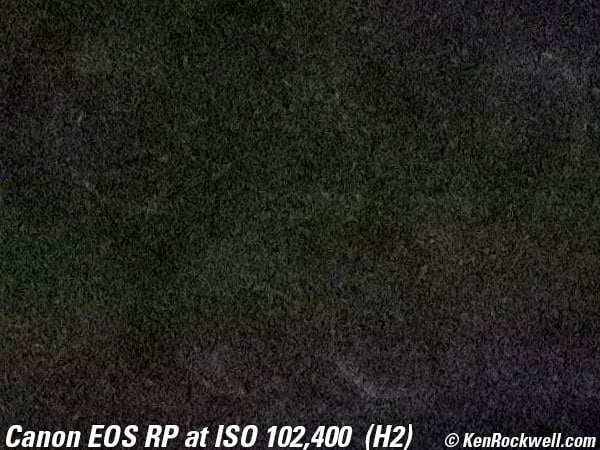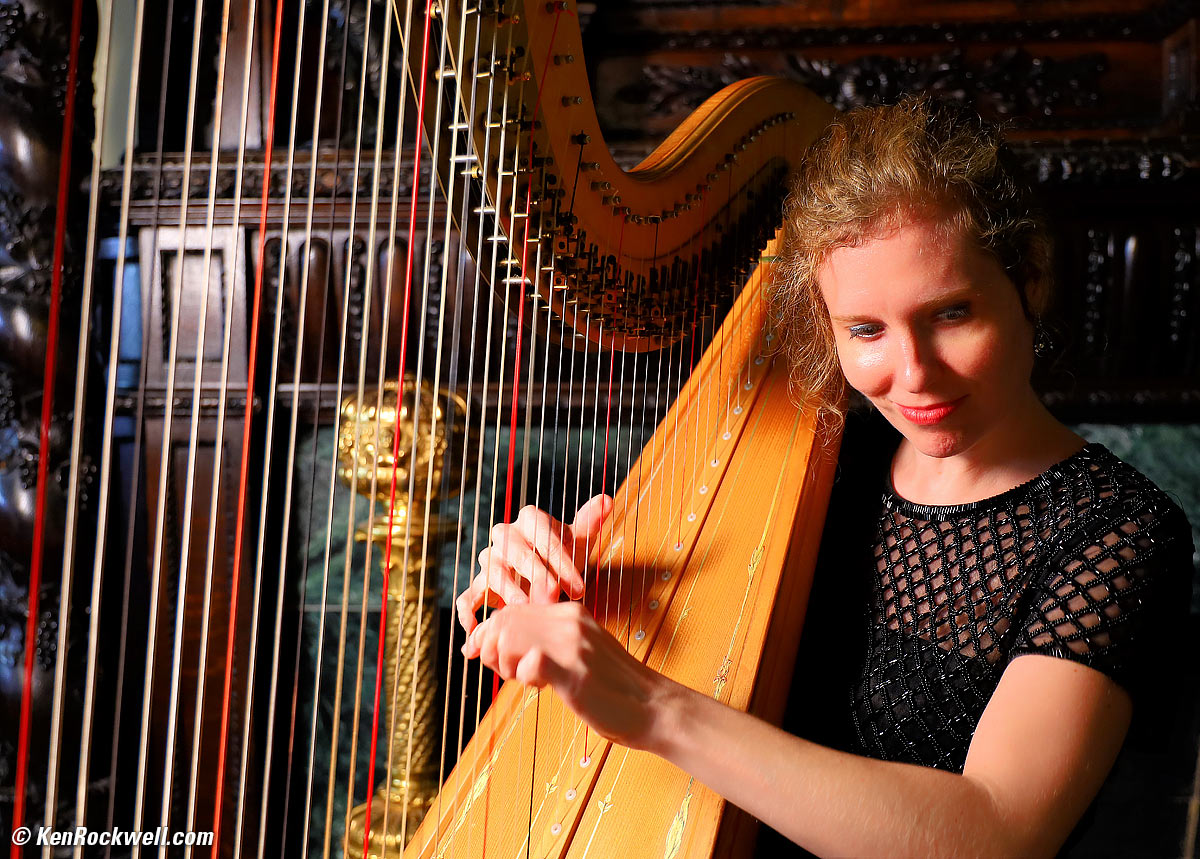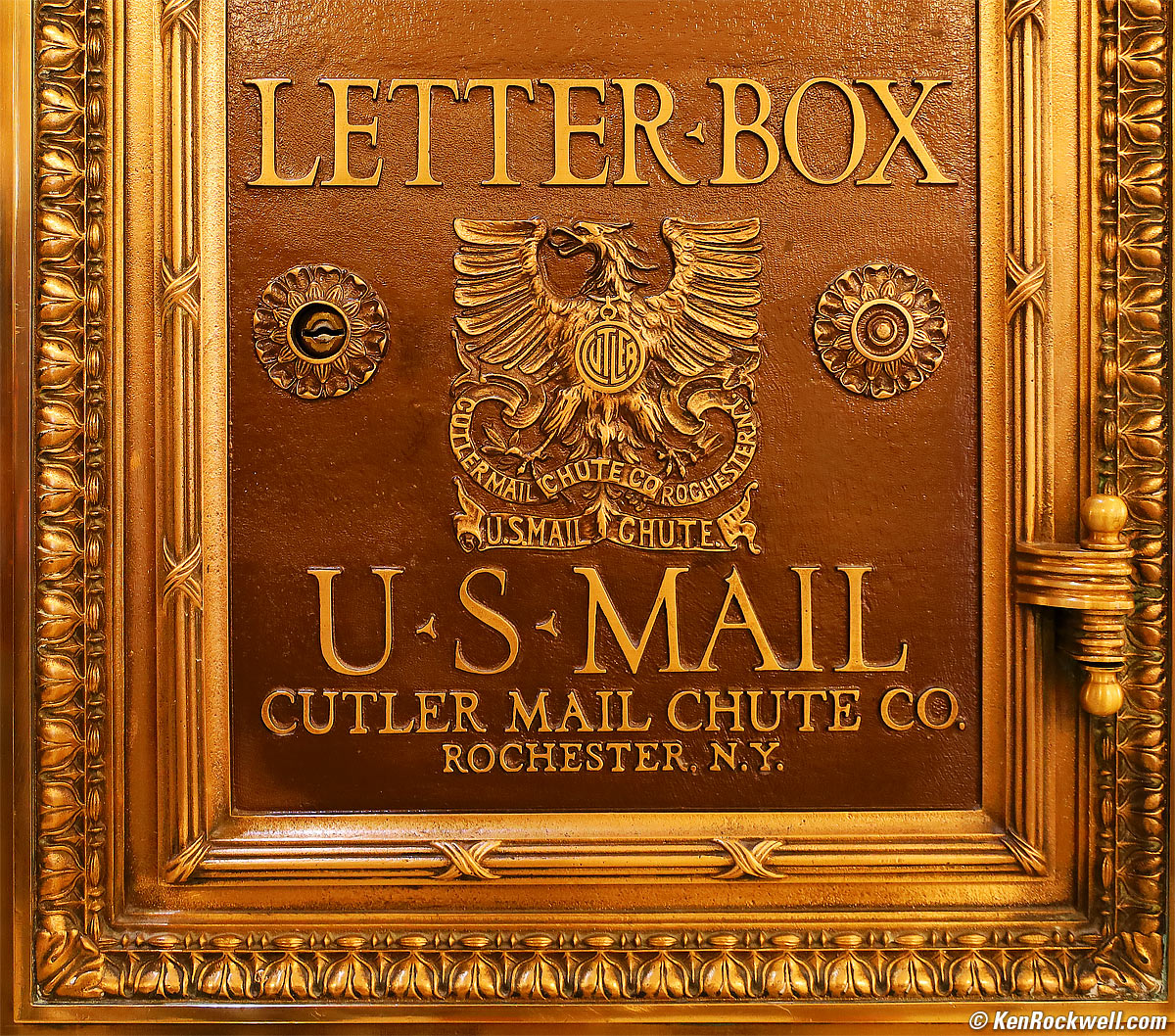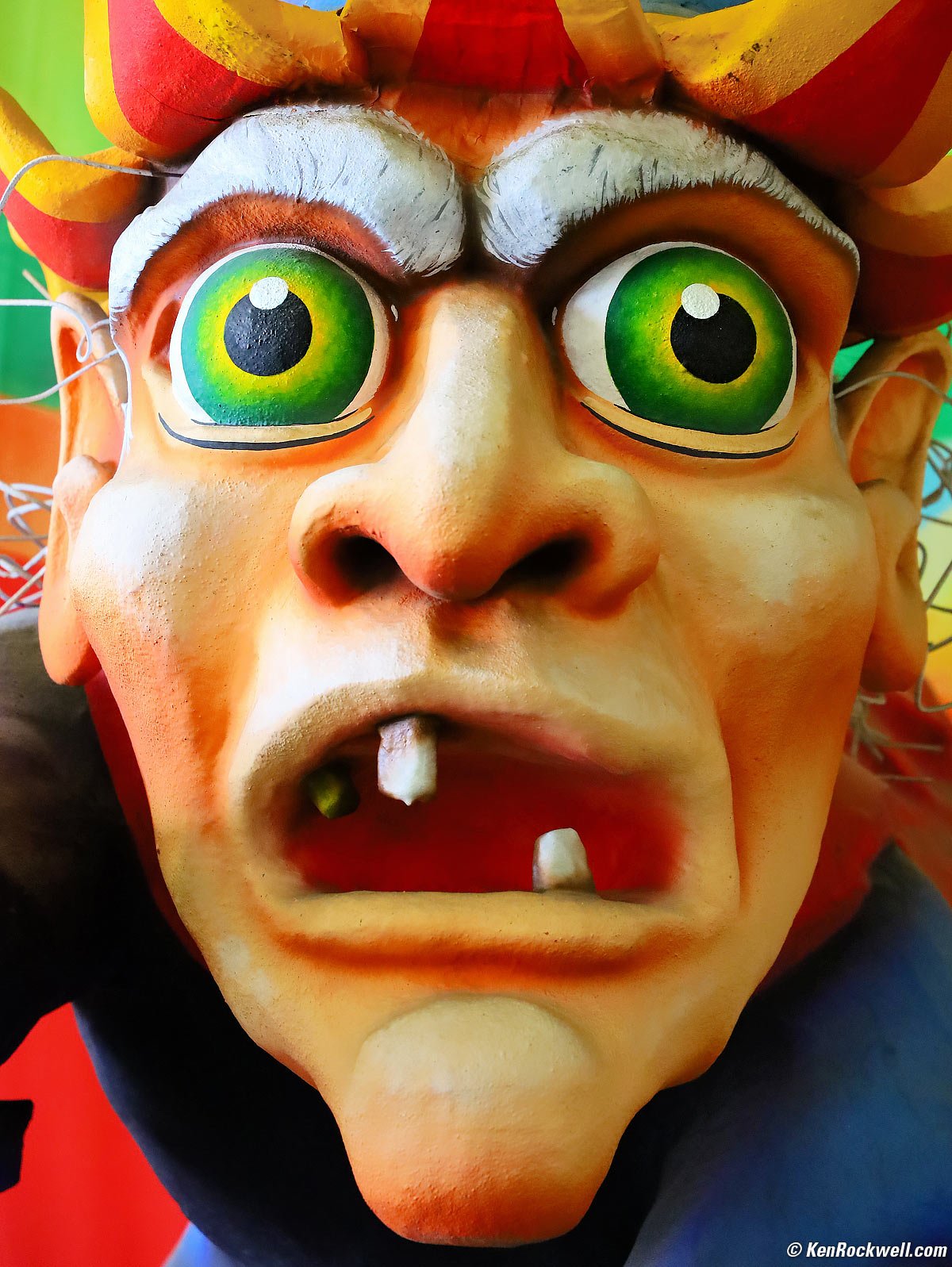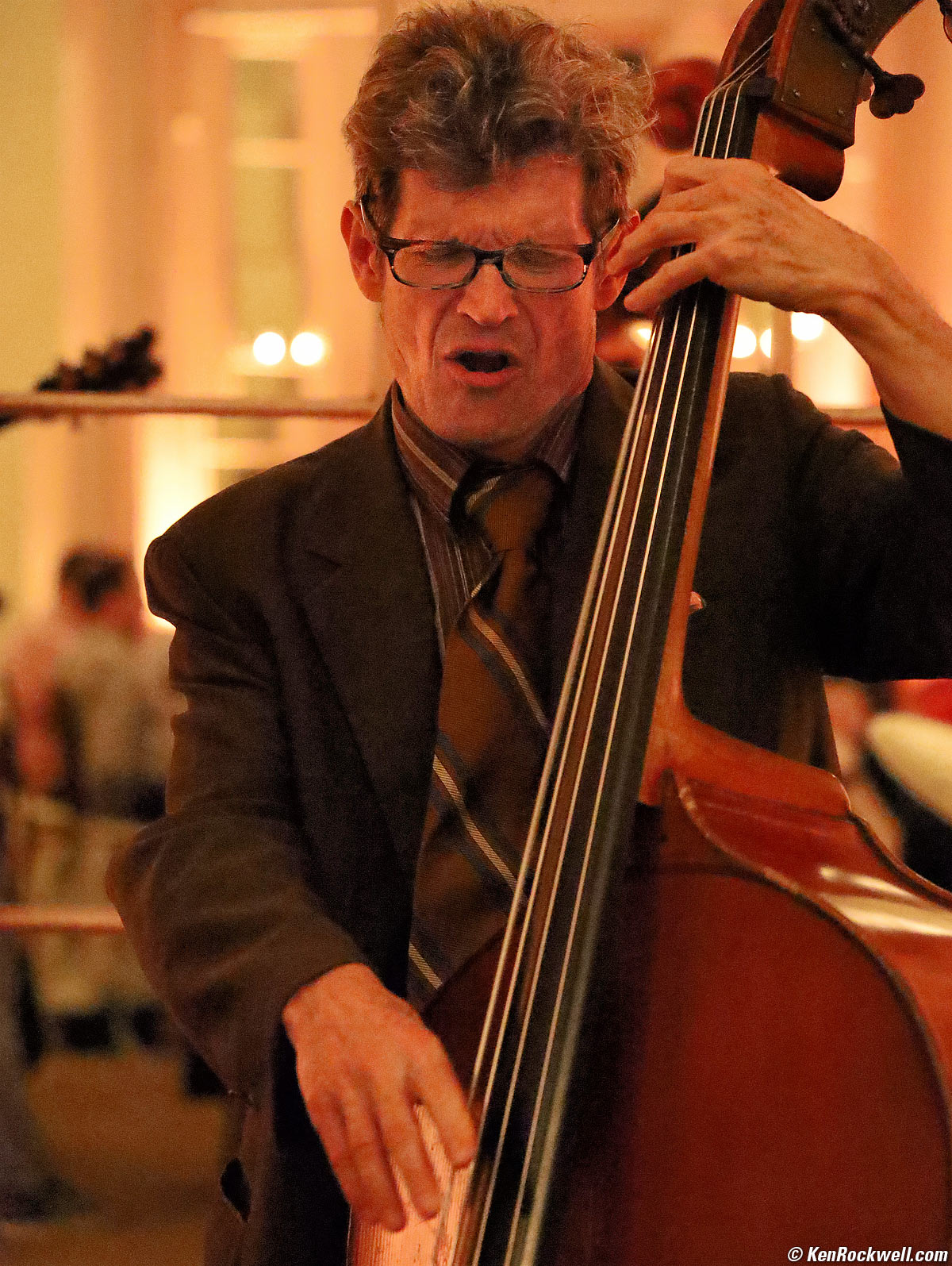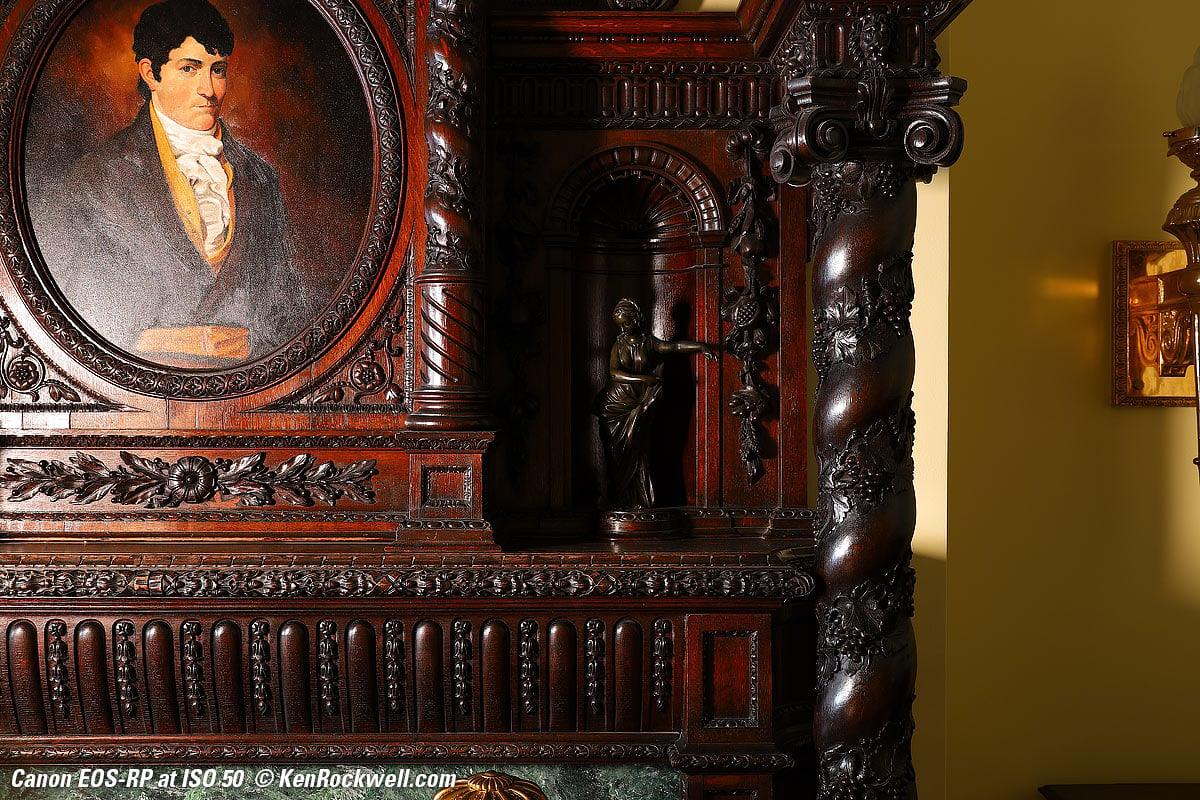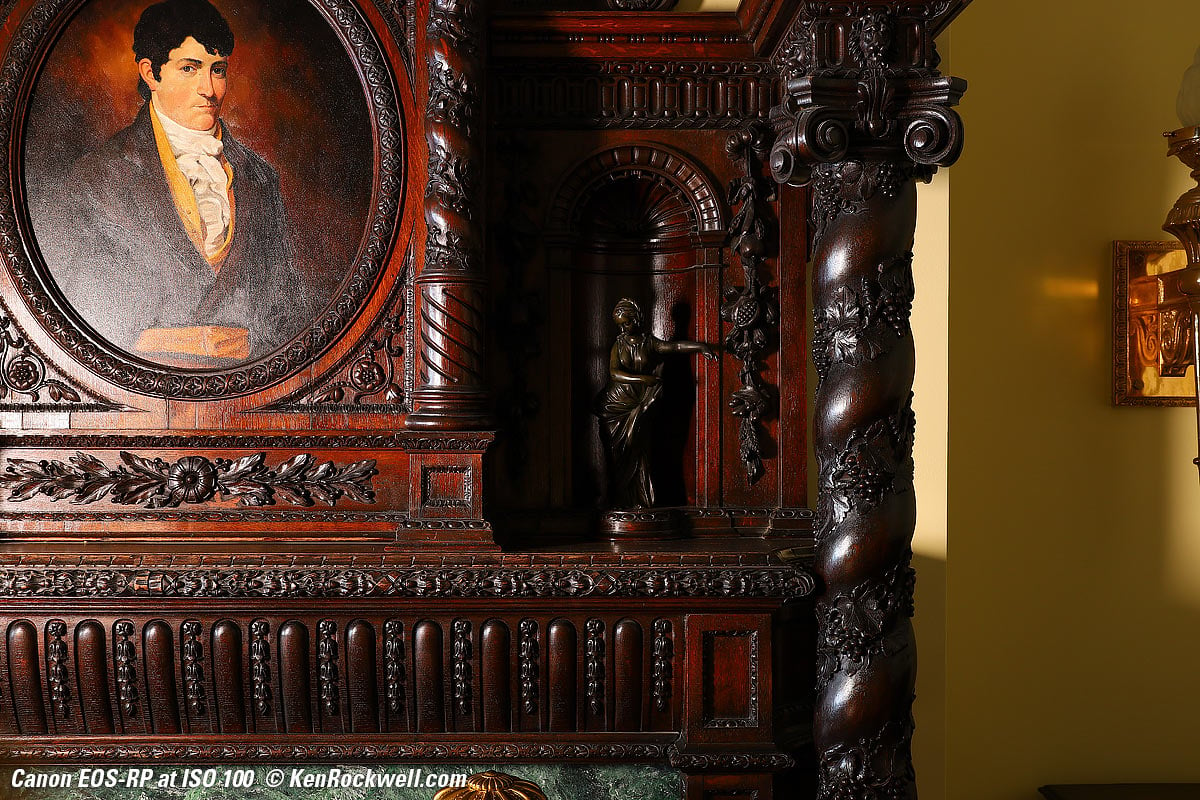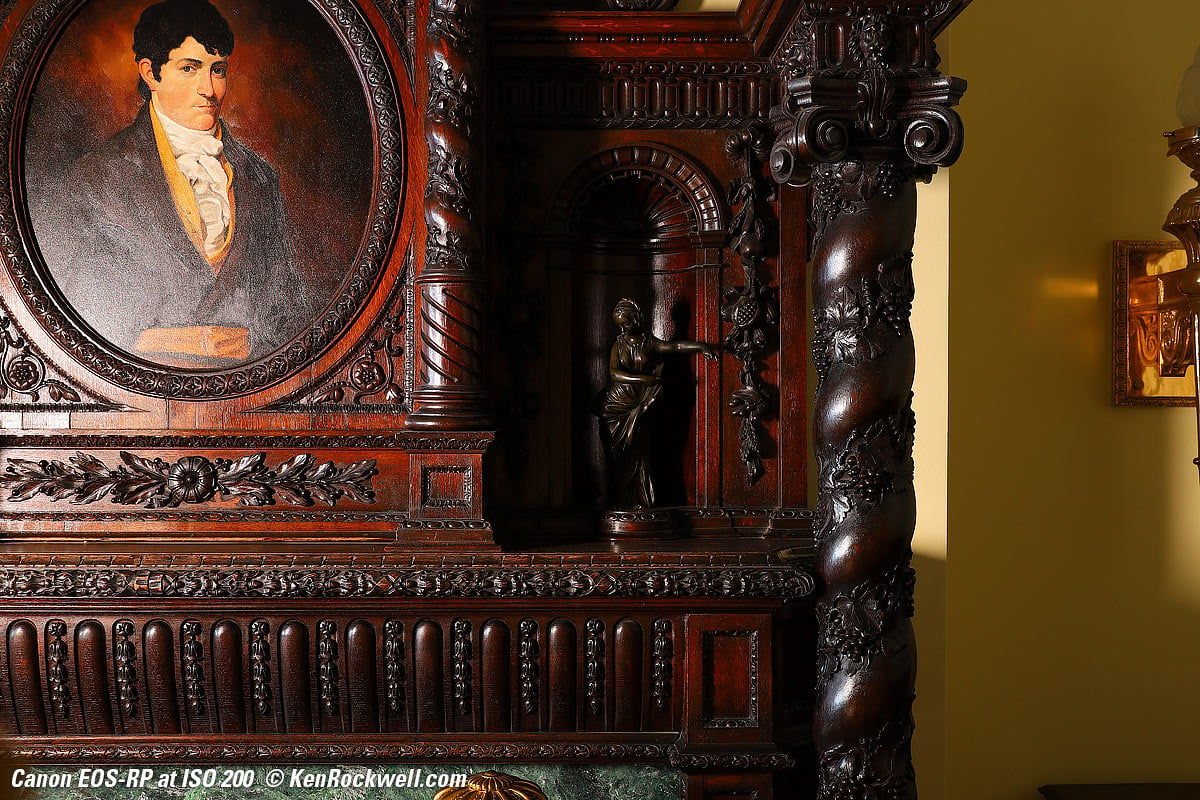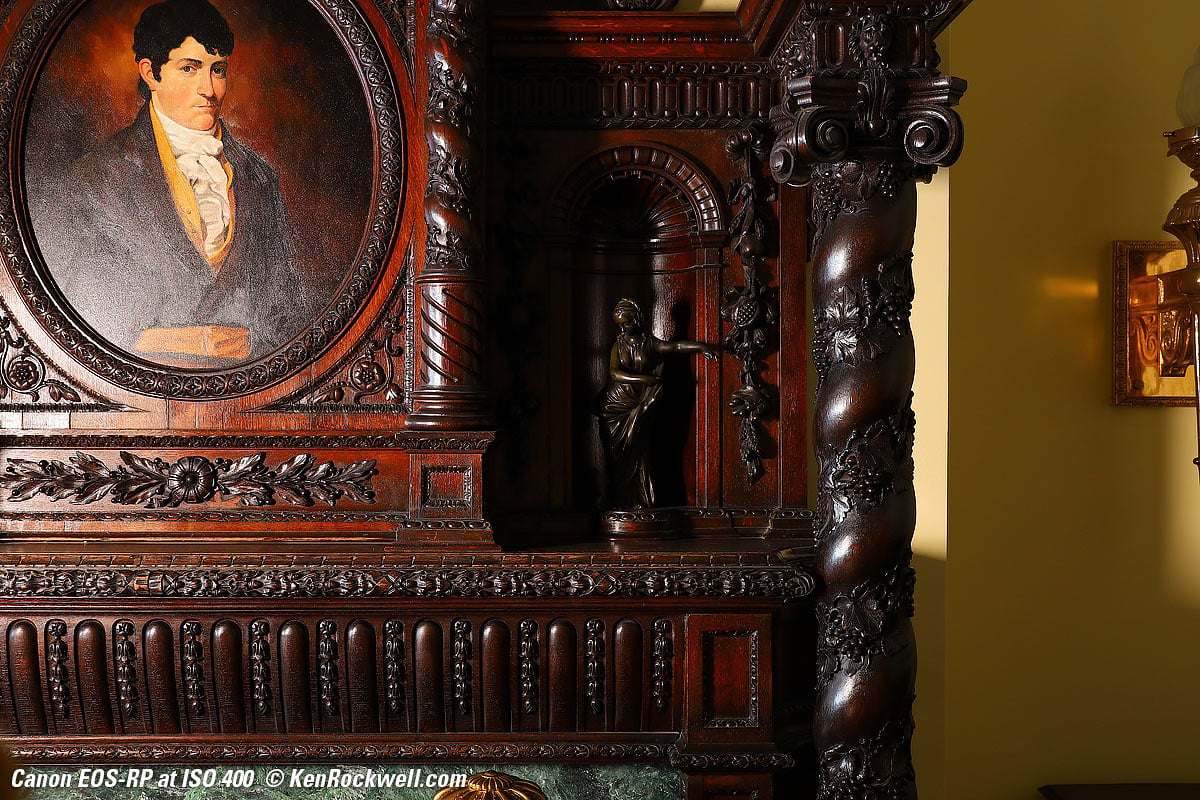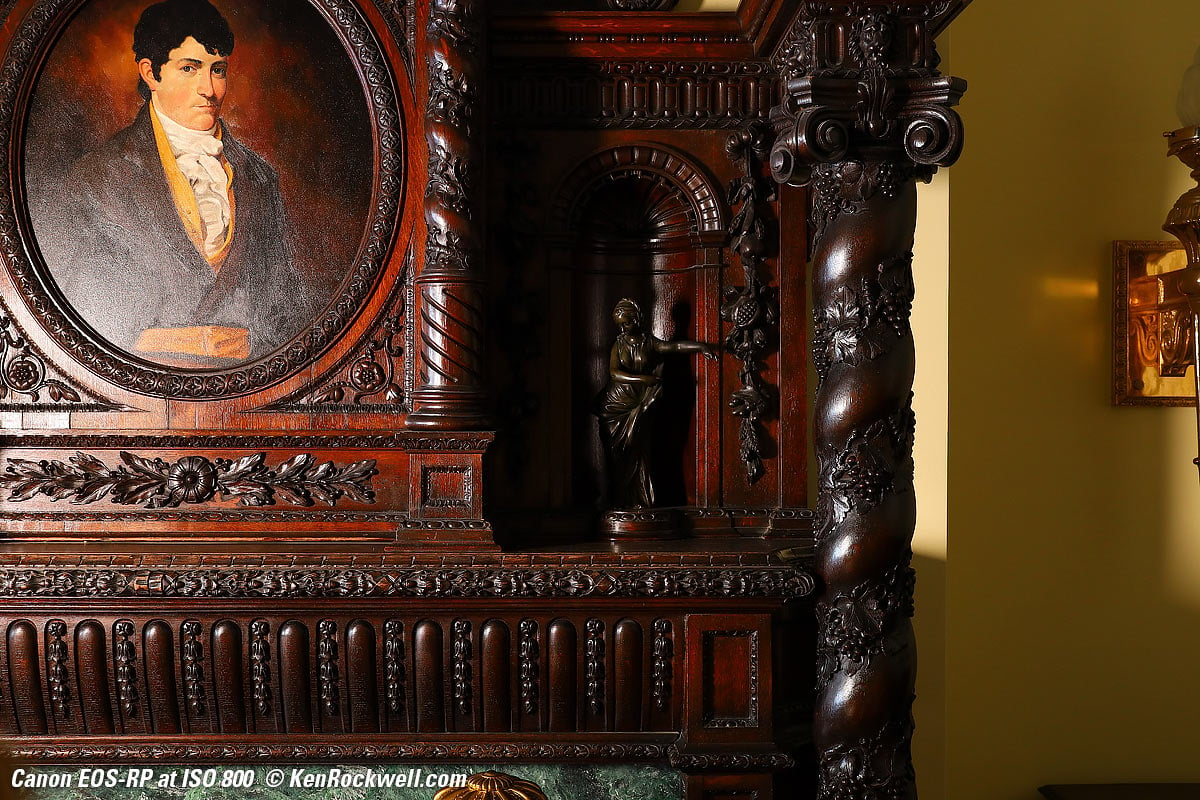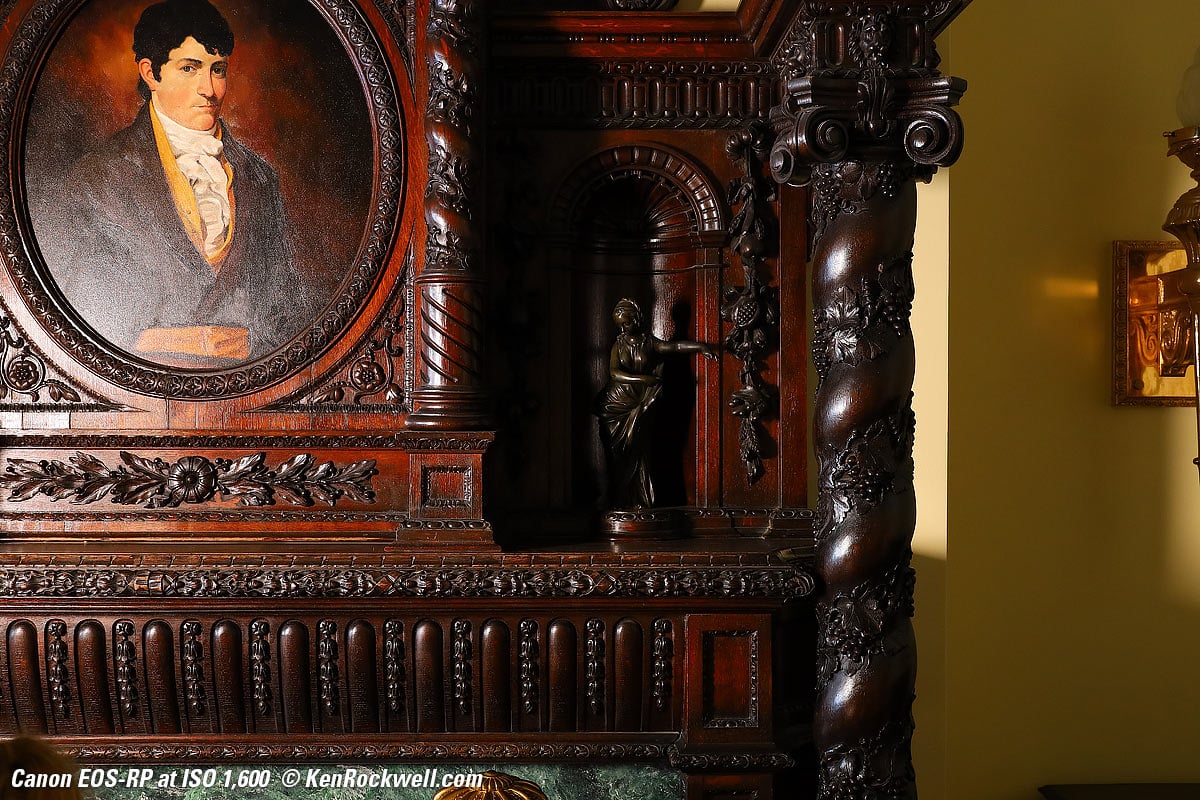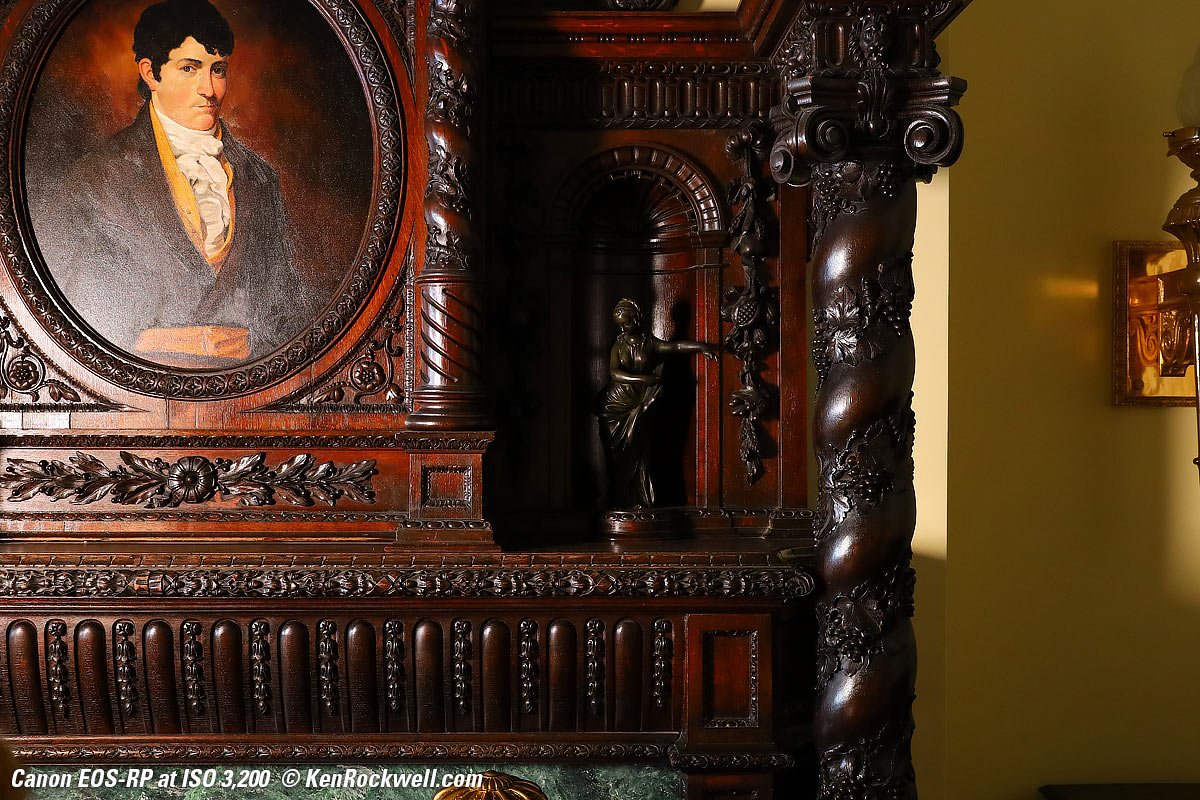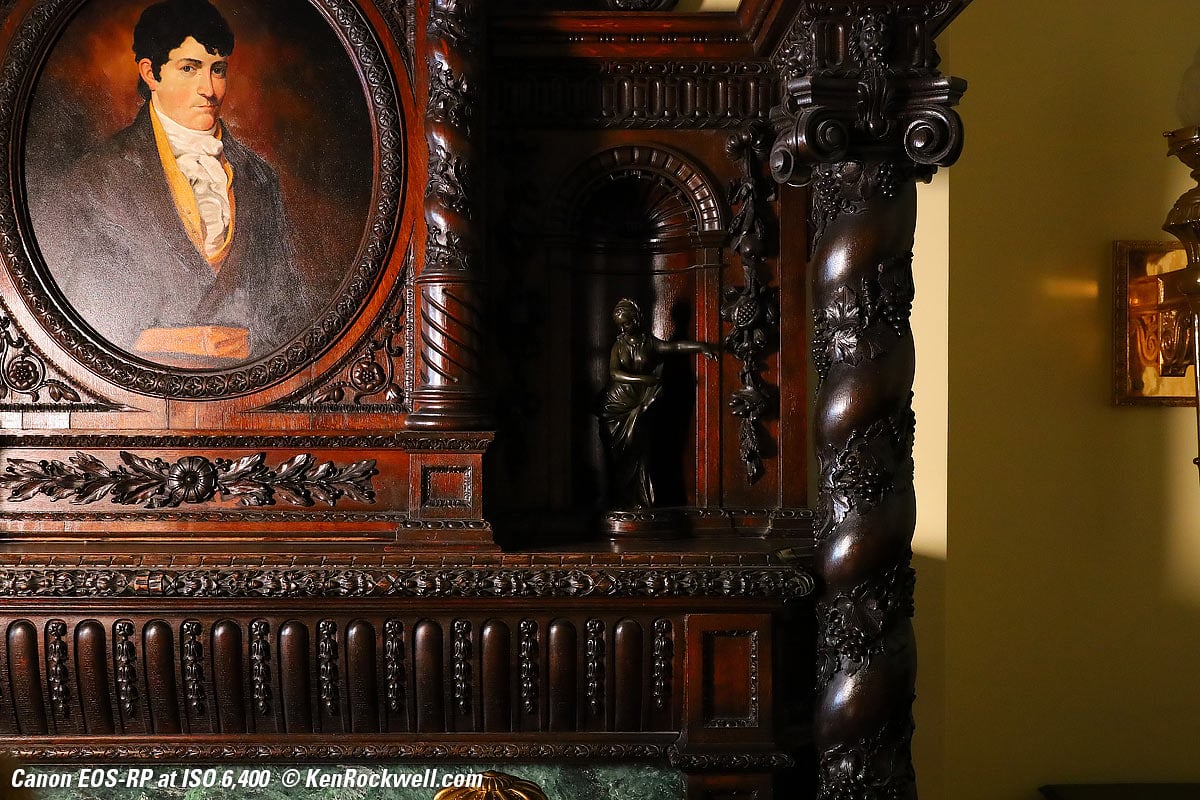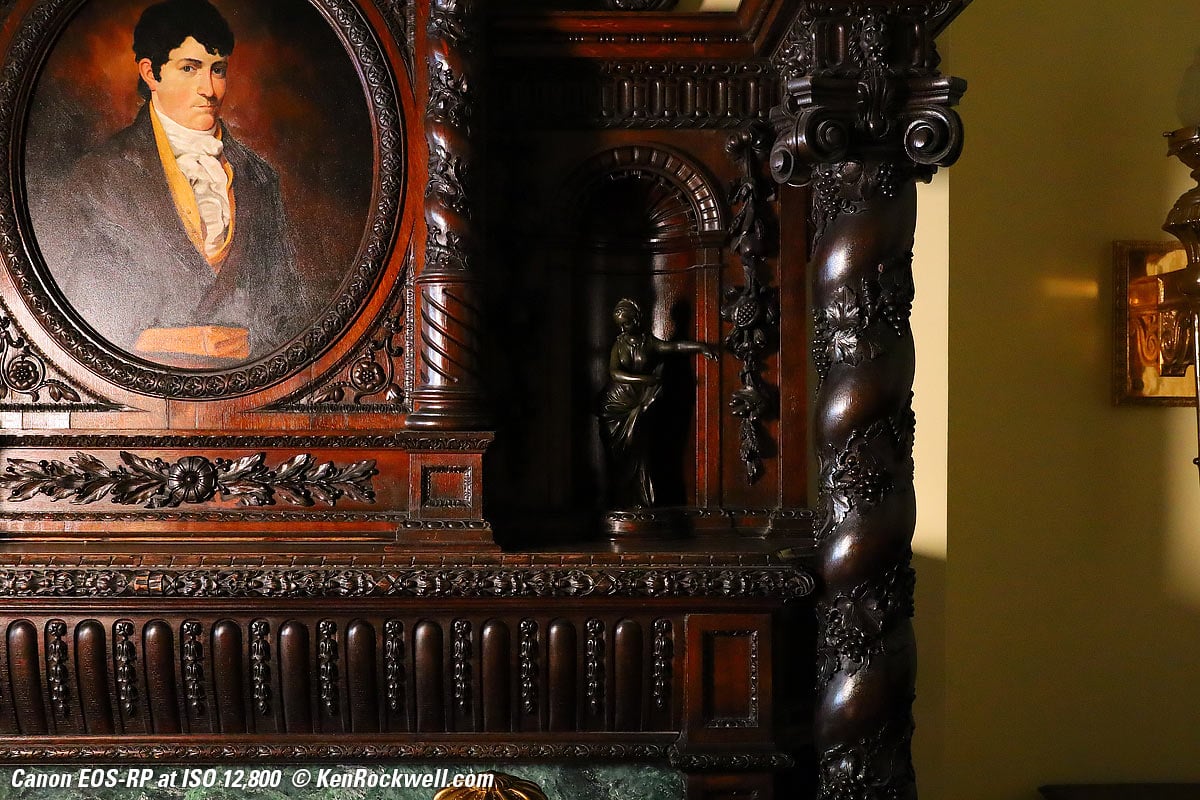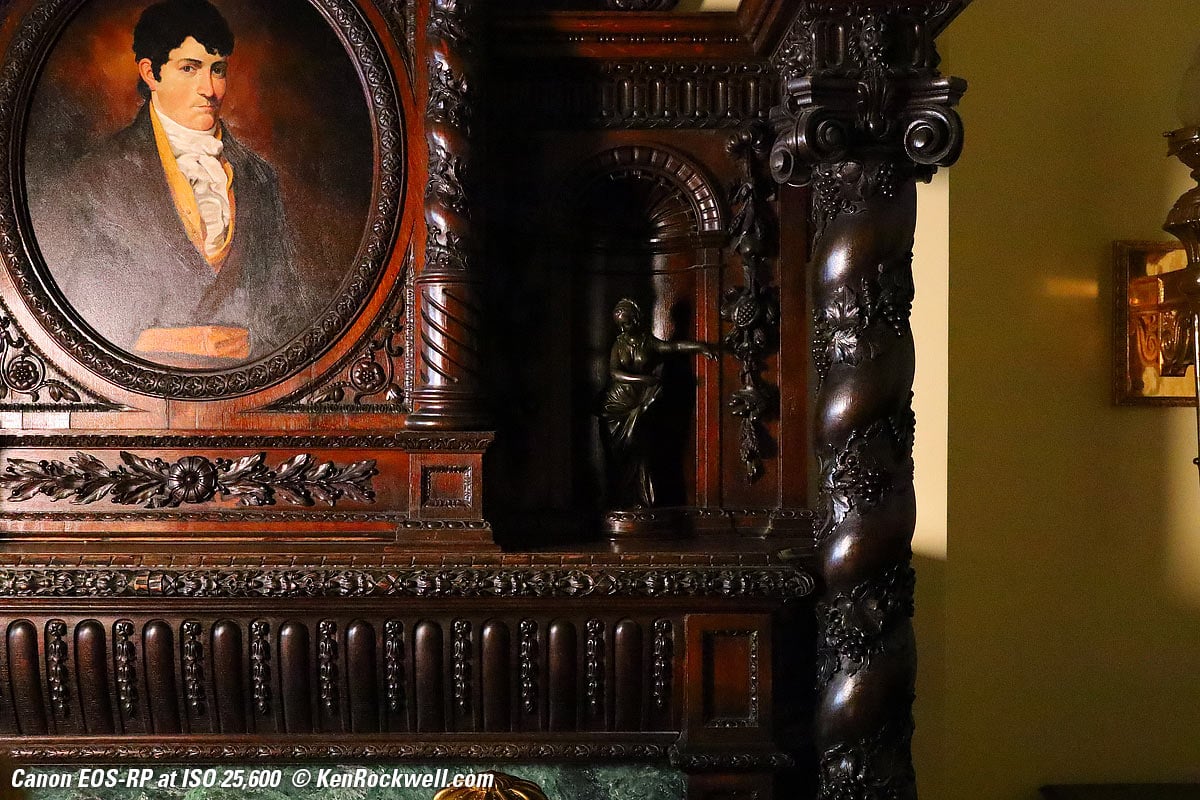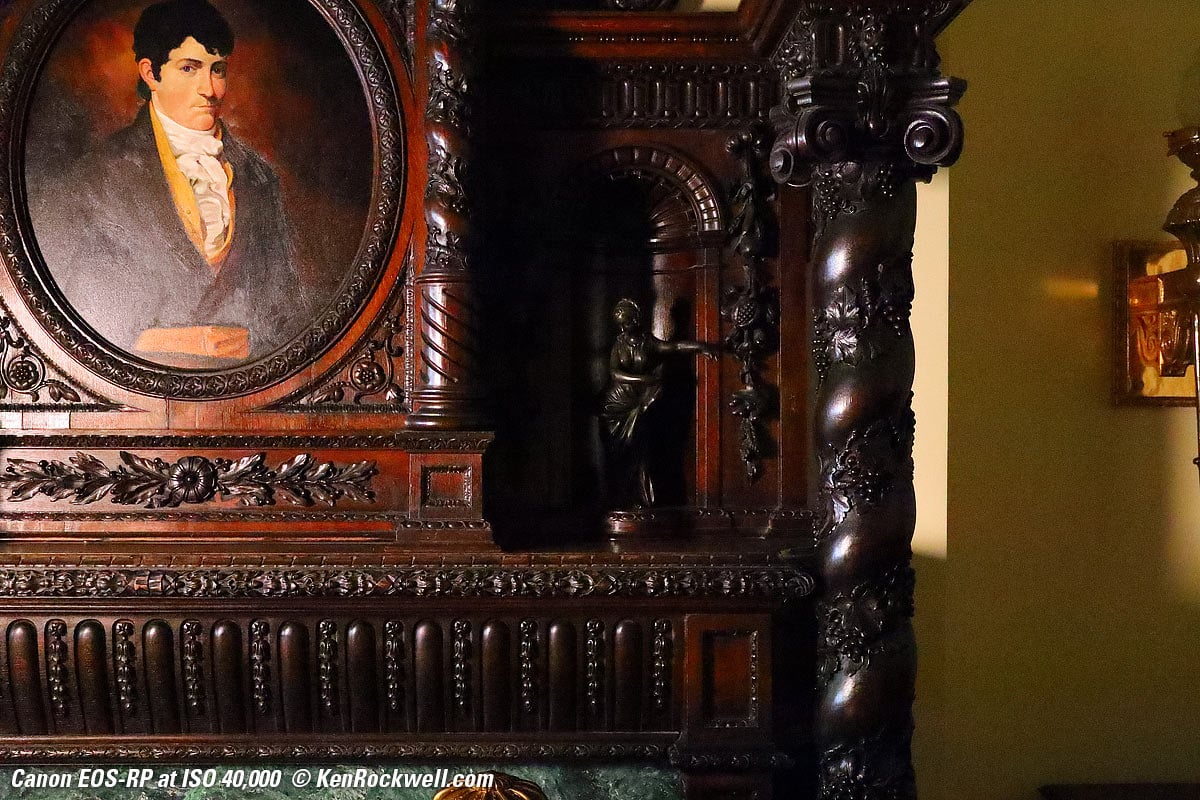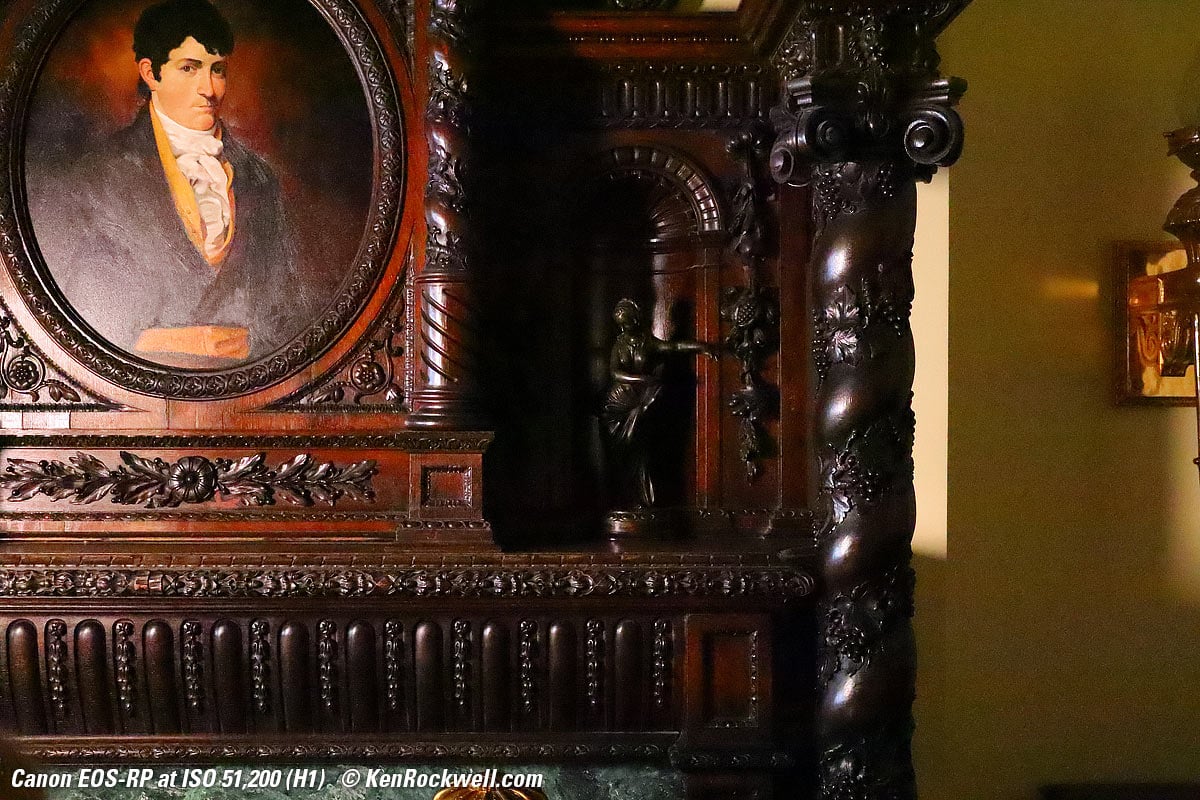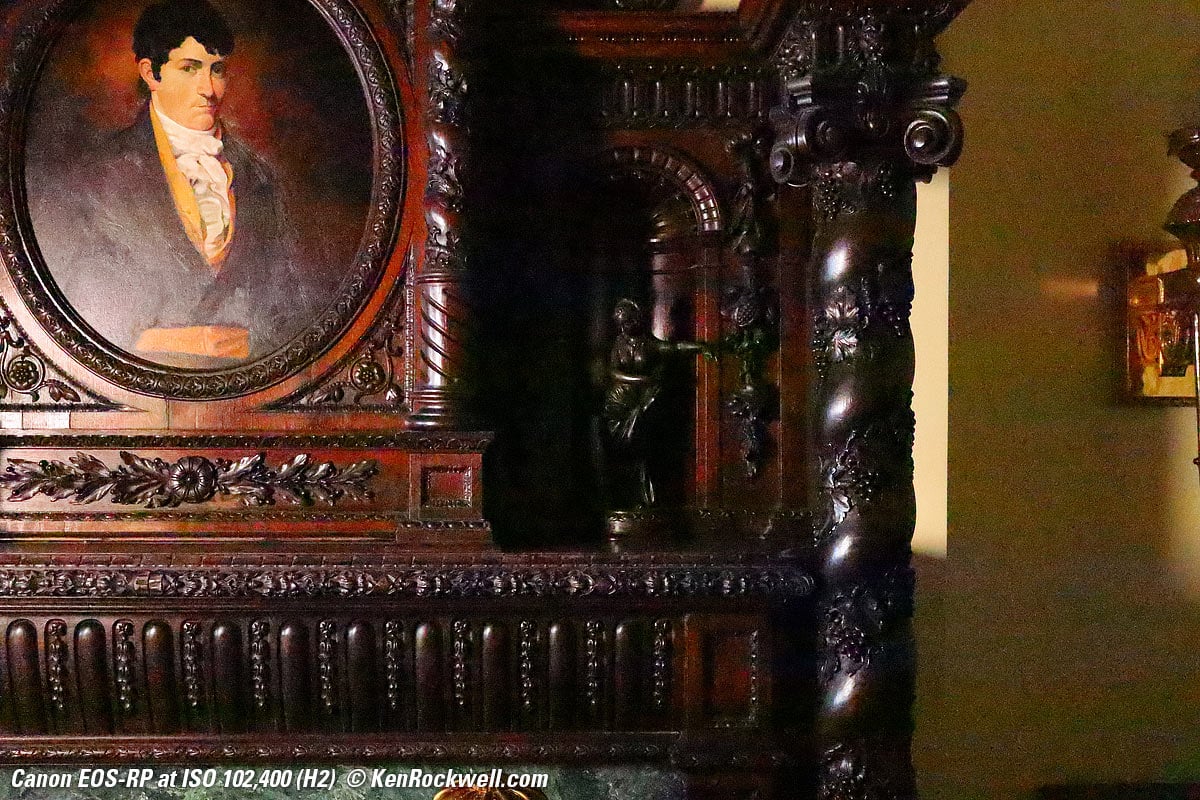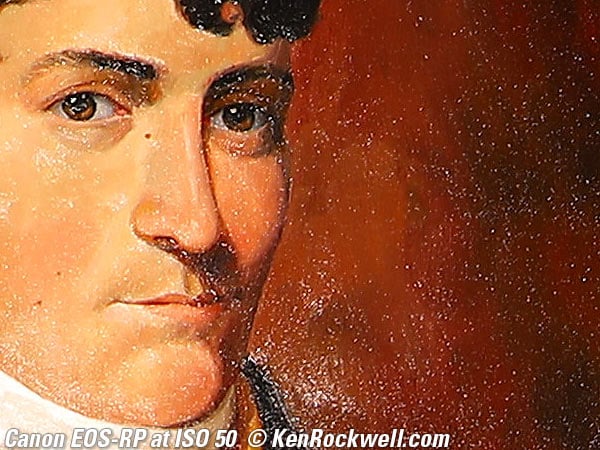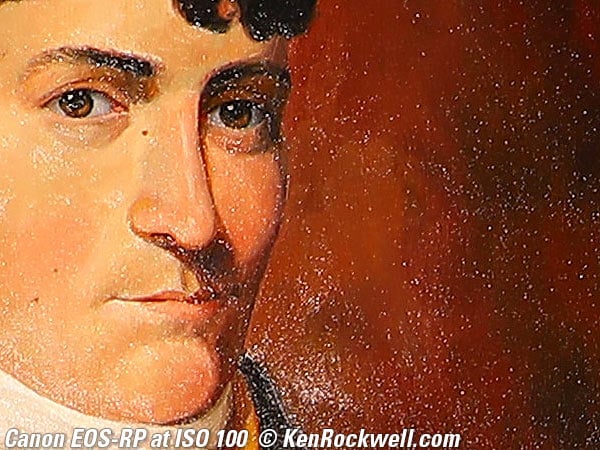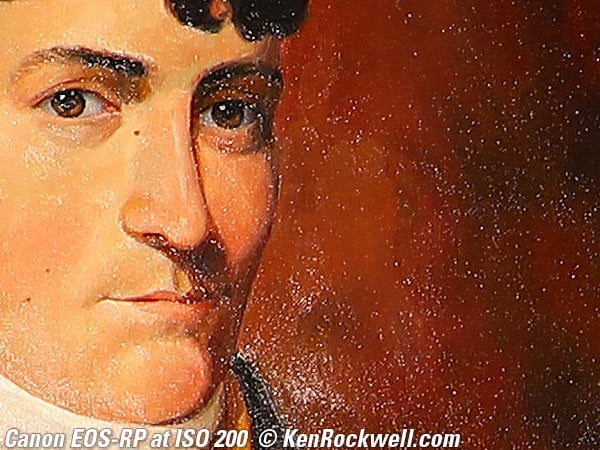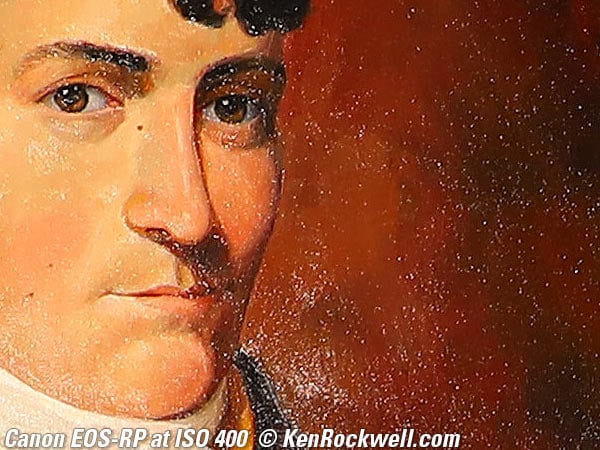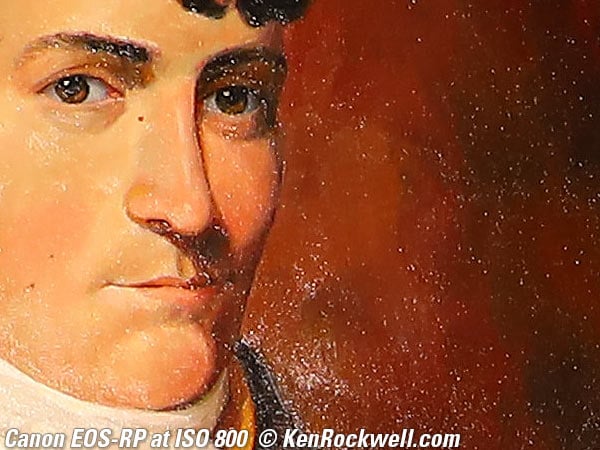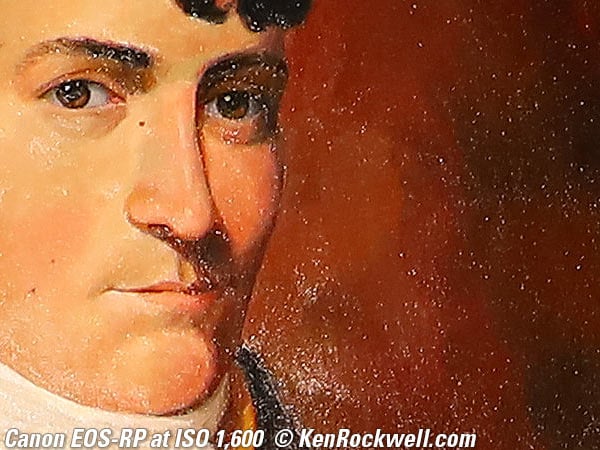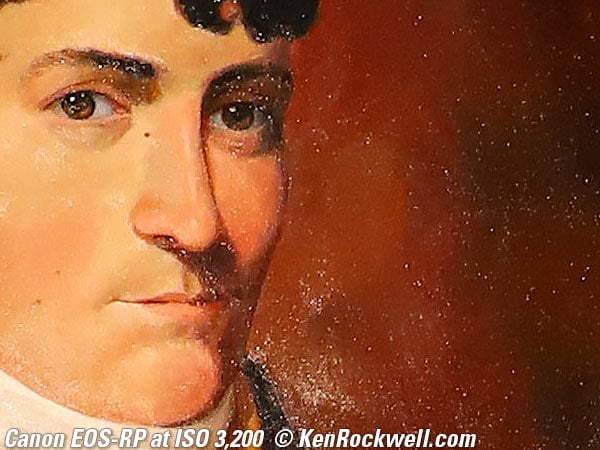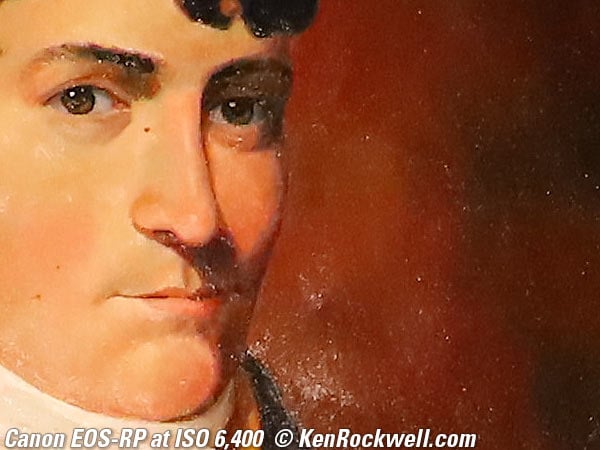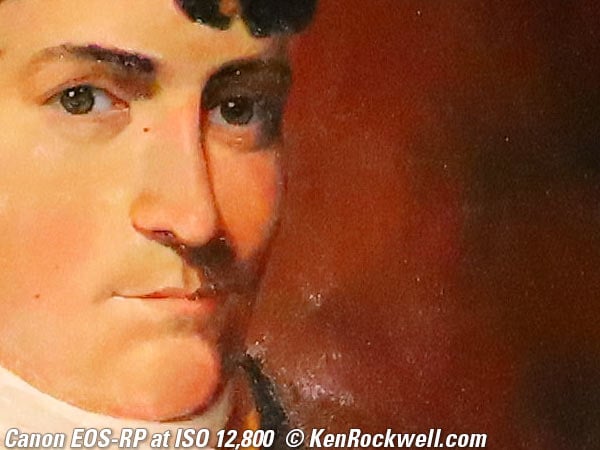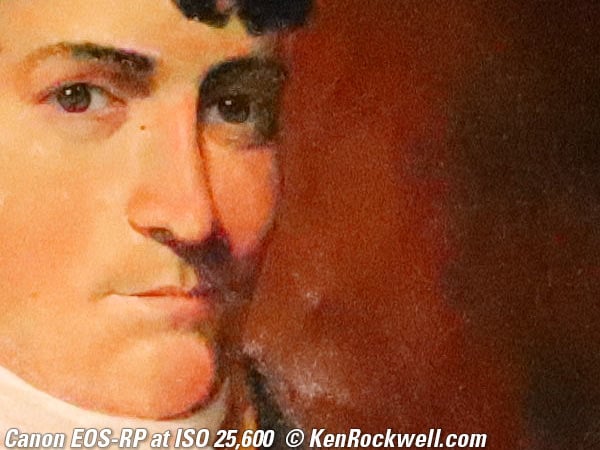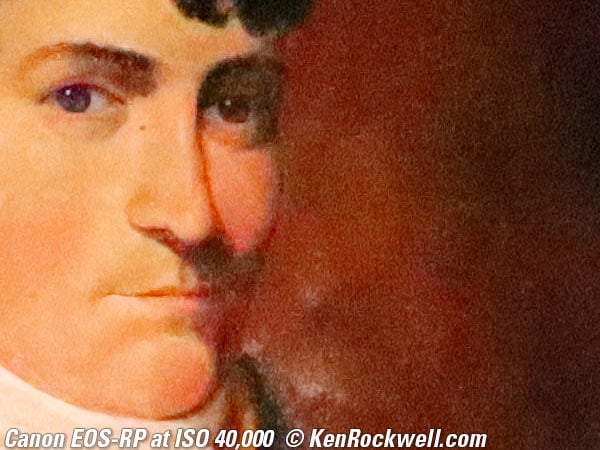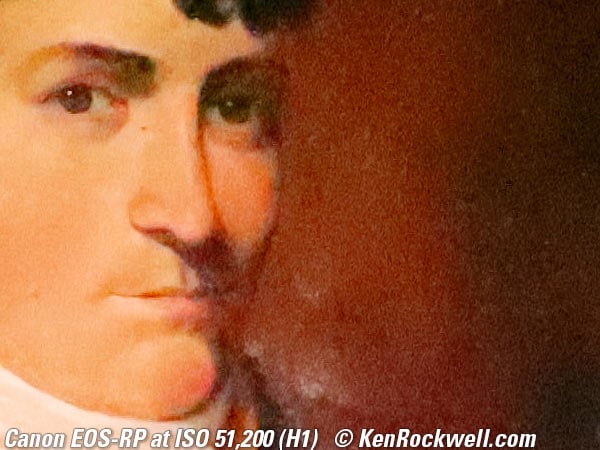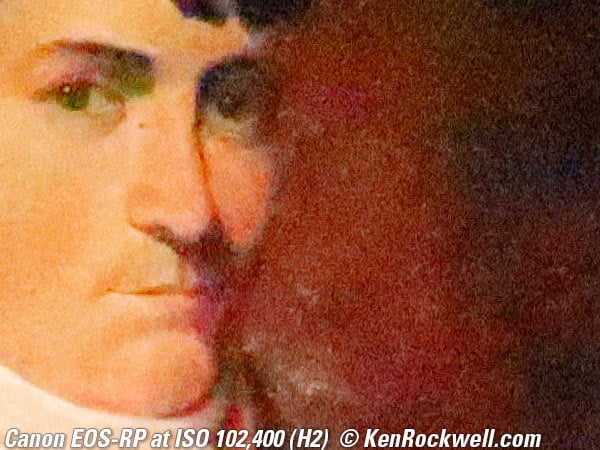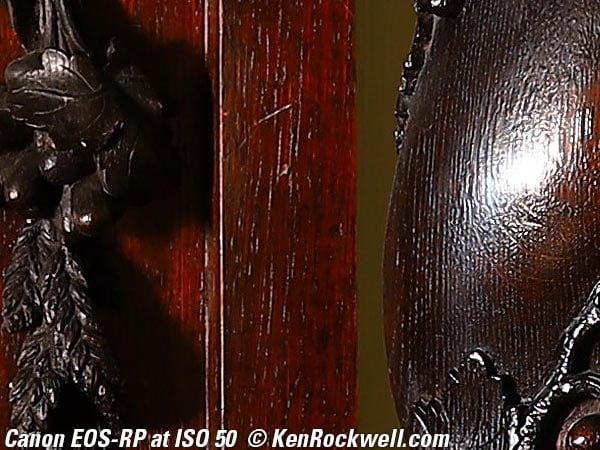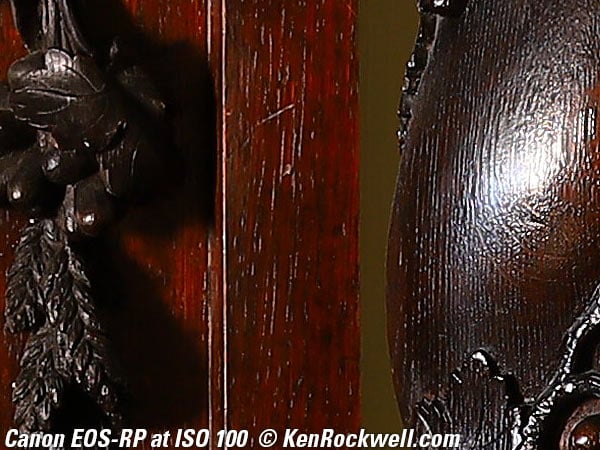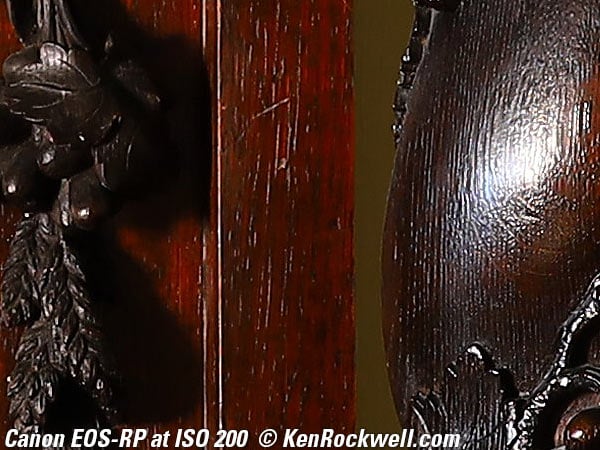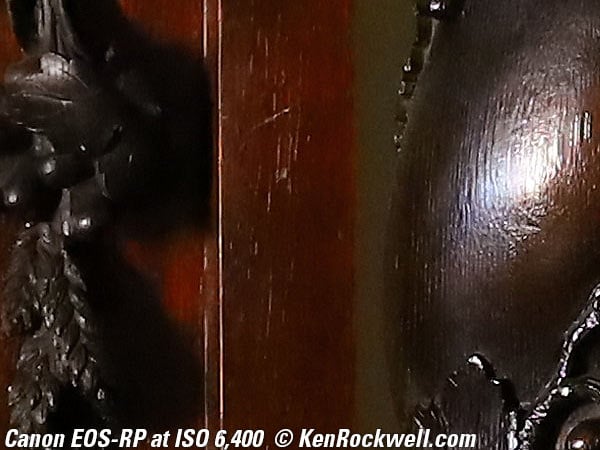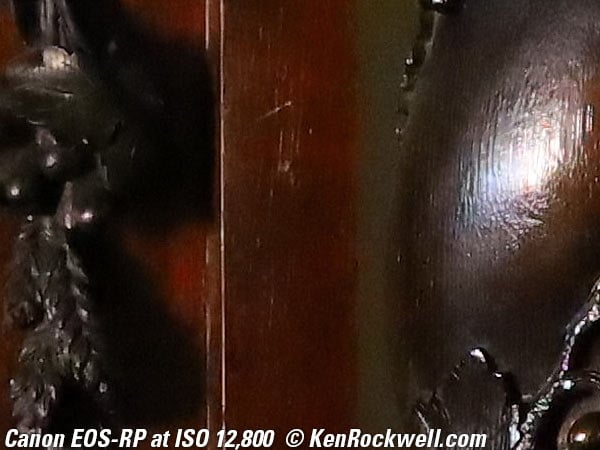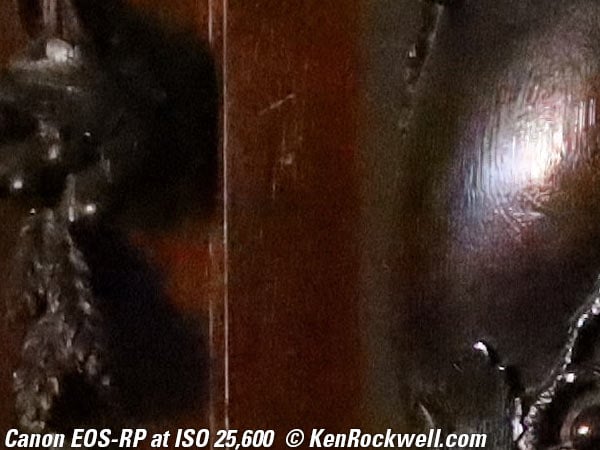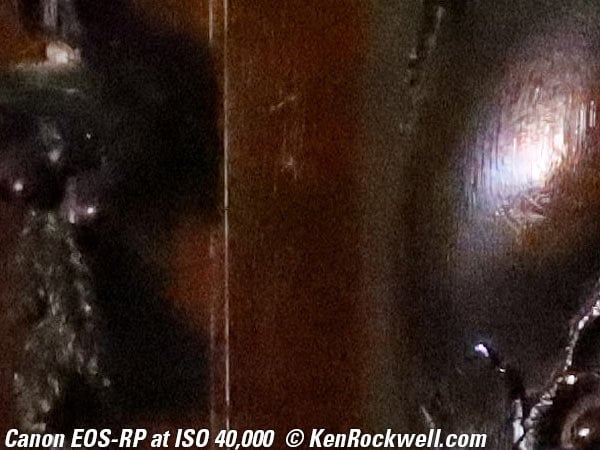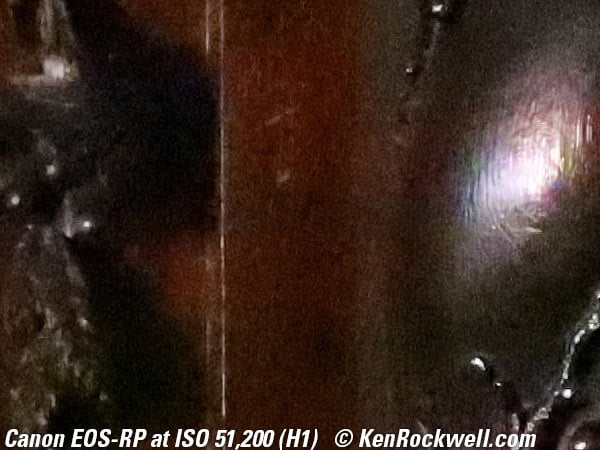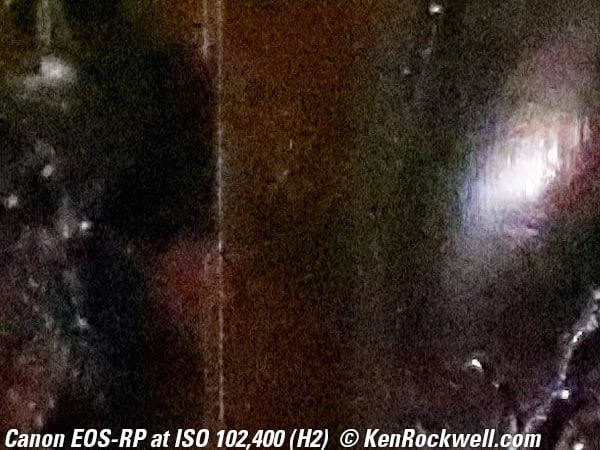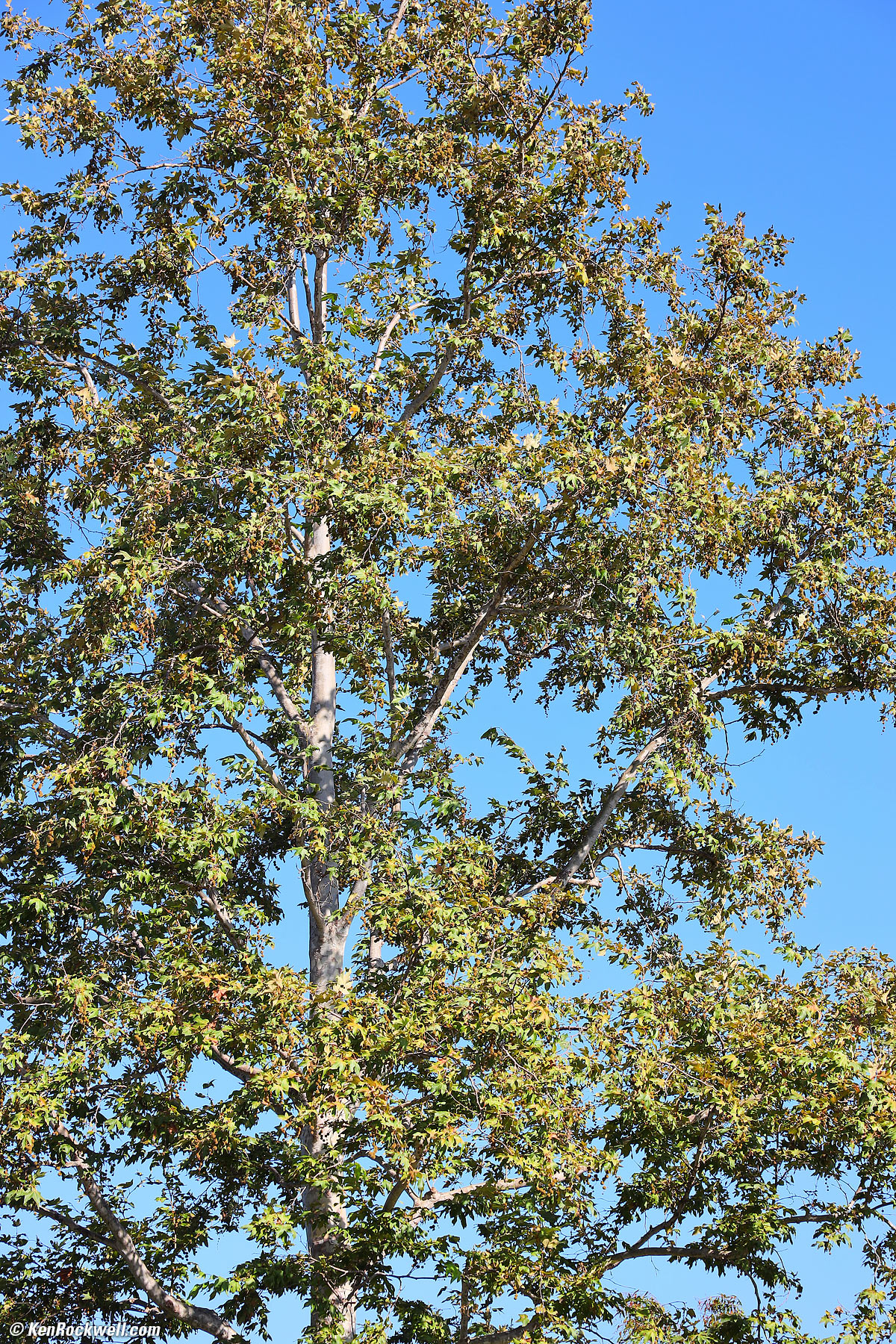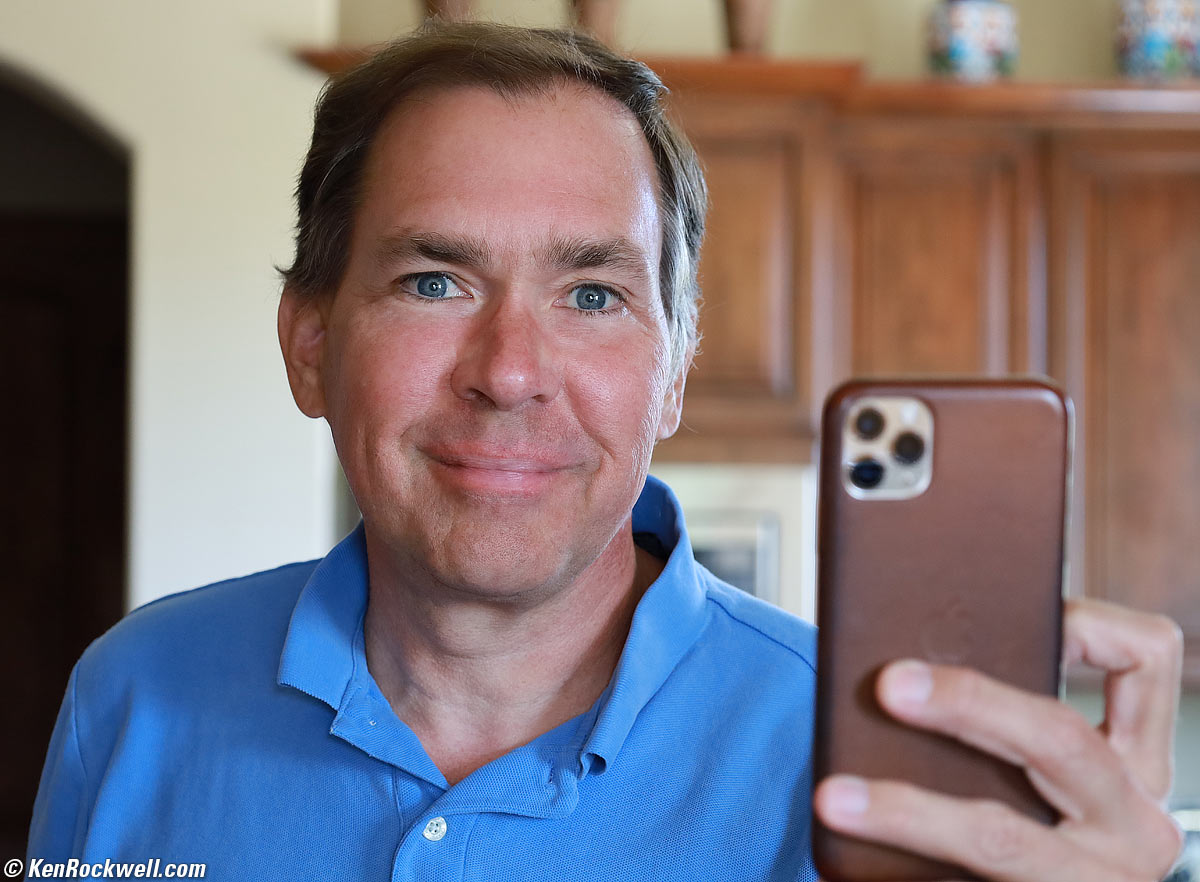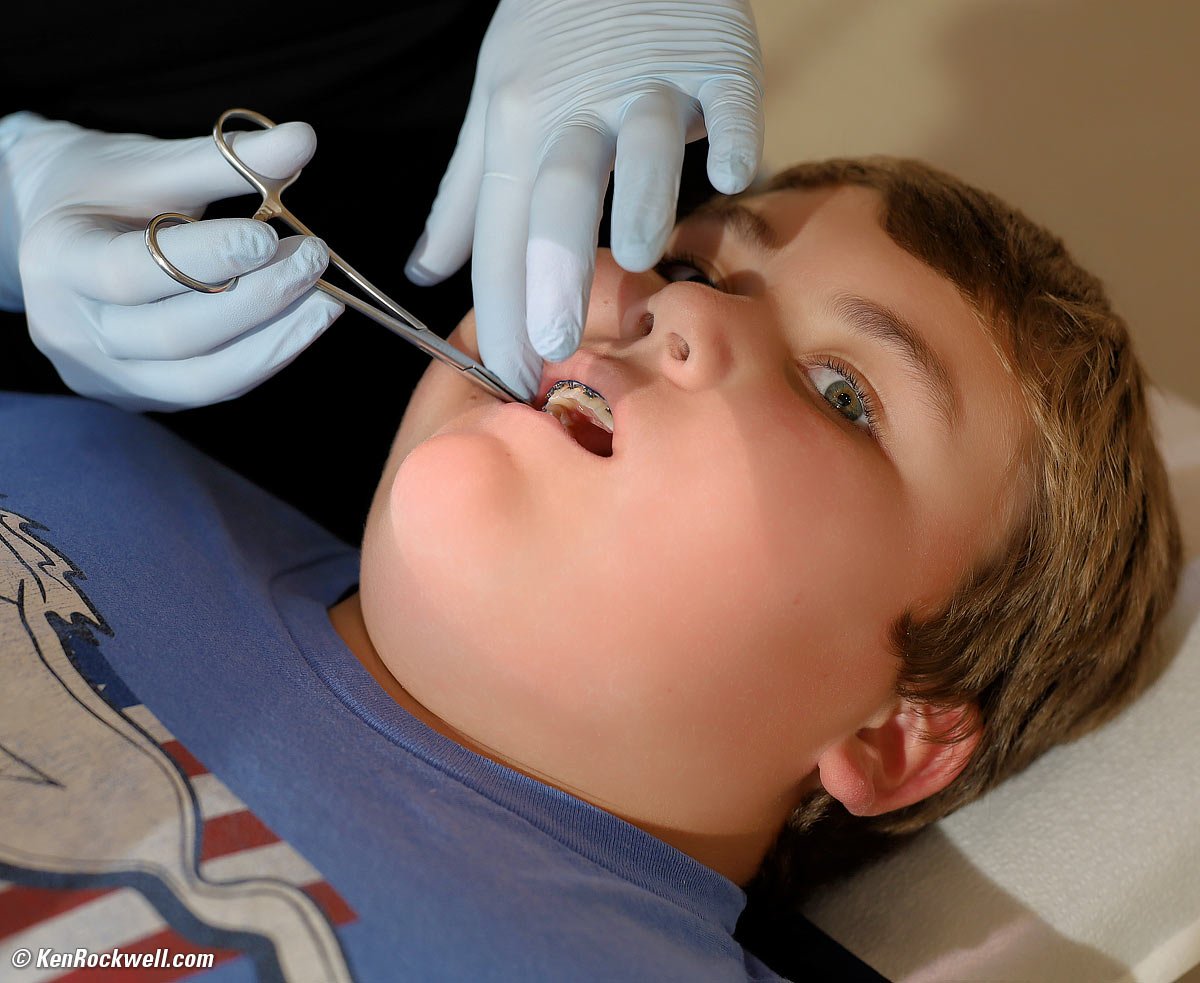Canon EOS RP
26 MP Full-Frame
Silent, 5 FPS
World's 2nd Best Low-Cost Full-Frame Mirrorless Camera
NEW VERSION: Canon EOS R8
Sample Images Intro Lens Compatibility
Adapters Specs Accessories Performance
Compared User's Guide Recommendations More
R3 R5 R5C R6 II R6 R R8 RP R7 R10 R50 R100
Bodies Compared RF Lenses EF Lenses Flash
Canon EOS RP (one SD card slot, 17.0 oz./481g with battery and SD card, $999 new or about $625 used) with Canon EF 50mm f/1.0 L on EF Adapter with Control Ring. bigger.
EOS RP body: $999 at Adorama, at Amazon, at B&H and at Crutchfield, or about $625 used at eBay if you know How to Win at eBay.
EOS RP & RF 24-105mm STM: $1,299 at Adorama, at Amazon and at B&H.
EOS RP & RF 24-240mm: $1,815 at Amazon.
EG-G1 grip: $79 in black, in red and in blue.
This all-content, junk-free website's biggest source of support is when you use those or any of these links to approved sources when you get anything, regardless of the country in which you live. Thanks for helping me help you! Ken.
January 2024 Better Pictures Canon Reviews Mirrorless RF Lenses EF Lenses Flash All Reviews
NEW: Canon EOS R vs EOS R8 vs RP
Nikon vs Canon vs Sony Full Frame Mirrorless Compared
Canon EOS RP. bigger.
Canon EOS RP (rear LCD flipped over). bigger.
Canon EOS RP (rear LCD flipped over). bigger.
Canon EOS RP (rear LCD flipped over). bigger.
Canon EOS RP with Canon RF 24-105mm f/4L IS. bigger.
Sample Images
Top Sample Images Intro Lens Compatibility
Adapters Specs Accessories Performance
Compared User's Guide Recommendations More
I created all of the product images above and throughout this review with a second Canon EOS RP, a slew of Canon wireless flashes controlled by another Canon flash on the camera, an EF Lens Mount Adapter and a Canon EF 180mm f/3.5L Macro lens.
Ryan on Winter Break, 18 February 2019. Canon EOS RP, Canon RF 35mm f/1.8 Macro IS STM, Canon 580EX II flash, f/6.3 at 1/180 at ISO 100, Perfectly Clear. bigger or full-resolution or camera-original © JPG file.
Final Resting Place of Louis Hymel, New Orleans, Louisiana, February, 2019. Canon EOS RP, Canon RF 24-105mm f/4L IS at 24mm, 1/400 at f/10 at Auto ISO 100, Perfectly Clear. bigger, full-resolution or camera-original © file.
Cross and Clouds, New Orleans, Louisiana, February, 2019. Canon EOS RP, Canon RF 24-105mm f/4L IS at 39mm, 1/400 at f/10 at Auto ISO 100, Perfectly Clear. bigger or full-resolution.
Cross and the Sky, New Orleans, Louisiana, February, 2019. Canon EOS RP, Canon RF 24-105mm f/4L IS at 105mm, 1/640 at f/9 at Auto ISO 100, Perfectly Clear. bigger.
Perforated Metal Bench, New Orleans, Louisiana, February, 2019. Canon EOS RP, Canon RF 24-105mm f/4L IS at 58mm, 1/25 hand-held at f/10 at Auto ISO 100, Perfectly Clear. bigger.
Crazy Craw, New Orleans, Louisiana, February, 2019. Canon EOS RP, Canon RF 24-105mm f/4L IS at 77mm, 1/100 at f/4.5 at Auto ISO 1,600, Perfectly Clear. bigger, full-resolution or camera-original © file.
Satan, New Orleans, Louisiana, February, 2019. Canon EOS RP, Canon RF 24-105mm f/4L IS at 56mm, 1/60 at f/4.5 at Auto ISO 800, Perfectly Clear. bigger or camera-original © file.
Crazy Monkey, New Orleans, Louisiana, February, 2019. Canon EOS RP, Canon RF 24-105mm f/4L IS at 33mm, hand-held at 1/8 at f/11 at Auto ISO 1,600, Perfectly Clear. bigger, full-resolution or camera-original © file.
Crazy Chandeliers, New Orleans, Louisiana, February, 2019. Canon EOS RP, Canon RF 24-105mm f/4L IS at 24mm, hand-held at 1/8 at f/4.5 at Auto ISO 800, Perfectly Clear. bigger.
Ocre Walls, New Orleans, Louisiana, February, 2019. Canon EOS RP, Canon RF 24-105mm f/4L IS at 24mm, hand-held at 1/8 at f/4.5 at Auto ISO 1,250, Perfectly Clear. bigger or full-resolution.
Le Pavillion Hotel, New Orleans, Louisiana, February, 2019. Canon EOS RP, Canon RF 24-105mm f/4L IS at 24mm, hand-held at 1/8 at f/4.5 at Auto ISO 250, Perfectly Clear. bigger or full-resolution
1,080p Movie File with Stereo Sound
Harpist, New Orleans, Louisiana, February, 2019. Canon EOS RP, Canon RF 24-105mm f/4L IS. click to play camera-original 1080p MP4 file (350MB). WARNING: this is the full-bandwidth unprocessed file right out of the camera. It's a huge file that may take a long time to download and play. This 90-second file has as much data as watching 20 minutes of regular online video like Netflix!
Yes it shoots 4K, but you wouldn't want to download the file to see it. This is recorded with the built-in stereo microphone and people talking in the background.
Introduction
Top Sample Images Intro Lens Compatibility
Adapters Specs Accessories Performance
Compared User's Guide Recommendations More
|
I buy only from these approved sources. I can't vouch for ads below. |
The Canon EOS RP is revolutionary because it's the world's least expensive full-frame mirrorless camera by a huge margin, and it's also the newest and the best regardless of price for what we shoot on mirrorless.
It is the World's Best Mirrorless camera because it's even better than the older world-beating EOS R that costs more. The EOS RP handles faster and better than any other mirrorless camera, and weighs much less. The Sony A9 excels if you need high speed, but that's not why we use mirrorless. If you need a pro sports camera, the Canon 1DX Mk II remains the top choice of full-time sports pros. Mirrorless is for travel and light weight and ultra-high image quality, and for all these things the EOS RP excels.
2018's Canon EOS-R, a thousand dollars more expensive, had been my favorite, while this EOS RP upgrades the EOS R's weird rear touch bar, combined mode selector/rear dial into separate mode dials and rear dials, making mode selection now instantaneous in the EOS RP.
This new EOS RP is also the world's lightest modern full-frame mirrorless camera; only the very first primitive Sony A7 of 2013 weighs a few grams less. Isn't this why we shoot mirrorless cameras in the first place? This little gem weighs but 17 oz. (485g), the same as the world's first tiny screw-mount LEICAs, while every other full-frame mirrorless weighs about 24 oz. (660g), the same as a much heavier LEICA M camera.
Canon EOS RP compared to the small 6D Mk II. bigger.
The EOS RP weighs but two-thirds of other modern full-frame mirrorless cameras!
Otherwise it's mostly identical to the Canon EOS-R, minus size, weight and leaving an extra $1,000 in your pocket. The EOS RP doesn't have quite the frame rates of the EOS-R, but neither is fast enough for sports, so I'd save the $1,000 and go for this EOS RP whose ergonomics I prefer because of the dedicated mode dial. Otherwise the Canon EOS R and EOS RP feel and shoot the same.
Some great things about the EOS RP as well as the EOS-R are that they both show how your pictures will come out before you take them.
DSLRs let you view through the lens, but you can't see the actual pictures until you play them back — like film, just faster. The EOS RP has an electronic viewfinder that shows exactly how the picture looks, including all Picture Style (color, contrast, etc.) settings, distortion corrections, white balance, highlights and shadows and exposure all LIVE as you look through the finder.
It's a major revolution in photography that will replace DSLRs just as automobiles replaced horses. It will take some years until everyone takes this new kind of camera for granted, but just as digital replaced film, these new mirrorless cameras are replacing DSLRs. We only needed film-era SLR mirrors and ground glass until image sensors became fast enough to read-out in real time.
EOS RP body: $999 at Adorama, at Amazon, at B&H and at Crutchfield, or about $625 used at eBay if you know How to Win at eBay.
EOS RP & RF 24-105mm STM: $1,299 at Adorama, at Amazon and at B&H.
EOS RP & RF 24-240mm: $1,815 at Amazon.
EG-G1 grip: $79 in black, in red and in blue.
In-Finder Focus Magnifier, Menus & Zoomed Playback
You can do everything in the finder and never need the rear LCD.
Especially in direct sunlight, you can always see the big, beautiful finder image so much better than the little rear LCD.
Full-Frame Autofocus
Better than any full-frame DSLR, it can autofocus anywhere in the frame for regular viewfinder shooting.
The EOS RP has 4,779 AF positions and a big touch pad (the rear LCD) so we can move our selected AF sensor precisely anywhere we want it, all while keeping our eye on the finder.
The EOS RP is rated to LV -5 for autofocus, which means that it can focus in almost total darkness. Of course it gets slower, but I kid you not, it sees better in dim light than I do. Its finder, even with my f/4 24-105mm, becomes much brighter and more detailed than the scene itself — while my DSLR finder is always darker than the actual scene.
Extraordinary Performance with Teleconverters
The EOS R works fantastically with teleconverters and the EF Lens Adapters, with fast, full-frame autofocus with my 100‑400L IS II and even when used with both my 1.4x and 2x converters at the same time! That's a 280‑1,120mm f/12.6‑16 equivalent, easily hand-holdable! The EOS RP should work as well. While I haven't tried this with the ROS RP, and see no reason why it would perform any less extraordinarily.
This is because the AF sensors are on the image sensor, not buried deep inside a DSLR, so they see what the sensor sees and just work. With a DSLR, only the center AF sensor works at all with the 2x converter, and there is no AF when using both converters at the same time with the 100-400.
The Most Accurate Autofocus
The EOS RP's on-sensor AF detectors are immune to mechanical misalignment that plagues DSLRs. (DSLR AF detectors are in the base of the camera, coupled with a multiple mirror system.)
The EOS RP doesn't need AF microadjustments because its direct on-sensor system doesn't have any errors.
Better Lenses for Better Pictures
I've tested the new RF 24-105mm f/4L IS and RF 50mm f/1.2 L, and as promised they outperform the best DSLR lenses. Of course you need to be a virtuoso to be able to see the difference, but if you are, these are the sharpest and least distorting lenses ever.
Lens makers usually blow fluff about new lenses, but with the EOS RP's new lens mount that gives lens designers more leeway to design awesome lenses, it really shows.
Works Flawlessly with every EF and every EF-S lens with a $99 lens adapter:
Control Ring Mount Adapter EF-EOS R.
Image Stabilization, autofocus and everything work fast and sure with all the EF lenses we already own.
These adapters have only air inside them; they have no effect on angle-of-view, focal length or optical performance.
Not only do old lenses work, all of them introduced since about 1990 also have a Digital Lens Optimizer with all sorts of distortion and other corrections that no 35mm SLR and many DSLRs lacked!
New since EOS R
See also Canon EOS R vs EOS RP.
 Faster start-up time, now rated 820ms (down from 900mS in the EOS R).
Faster start-up time, now rated 820ms (down from 900mS in the EOS R).
 New focus-bracketing-stacking-compositing mode works with Canon's free Digital Photo Professional software to make infinite depth-of-field easy. This is extremely helpful for macro product shots or anything else that holds still and needs limitless of depth-of-field.
New focus-bracketing-stacking-compositing mode works with Canon's free Digital Photo Professional software to make infinite depth-of-field easy. This is extremely helpful for macro product shots or anything else that holds still and needs limitless of depth-of-field.
 Dedicated mode dial with C1, C2 and C3 positions and a second dedicated rear control dial. Gone is the silly combined mode button and dial fiasco of the EOS-R. The EOS RP loses the EOS R's weird rear touch-bar and top LCD to make room for this.
Dedicated mode dial with C1, C2 and C3 positions and a second dedicated rear control dial. Gone is the silly combined mode button and dial fiasco of the EOS-R. The EOS RP loses the EOS R's weird rear touch-bar and top LCD to make room for this.
 A first in a long time for Canon, Auto ISO works well with flash. For the past decade Canon always used to set ISO to ISO 400 in Auto ISO if you used flash.
A first in a long time for Canon, Auto ISO works well with flash. For the past decade Canon always used to set ISO to ISO 400 in Auto ISO if you used flash.
 Silent electronic shutter mode is limited because it's locked-in as a preset Scene (SCN) mode. The regular shutter is very quiet, but in truly silent mode you can't set continuous advance or set any image or exposure parameters.
Silent electronic shutter mode is limited because it's locked-in as a preset Scene (SCN) mode. The regular shutter is very quiet, but in truly silent mode you can't set continuous advance or set any image or exposure parameters.
 Wake-up speeds seems a little faster than the EOS R, but it could be my imagination.
Wake-up speeds seems a little faster than the EOS R, but it could be my imagination.
 LOCK lever for the command dials replaces the LOCK button on the EOS R.
LOCK lever for the command dials replaces the LOCK button on the EOS R.
 Smaller battery to save size and weight, but has less battery life per charge than the EOS R.
Smaller battery to save size and weight, but has less battery life per charge than the EOS R.
 Can't limit the range of selectable shutter and aperture values as we can on the EOS R. So?
Can't limit the range of selectable shutter and aperture values as we can on the EOS R. So?
 New EG-E1 grips add just enough height for your pinky. They come in three colors:
New EG-E1 grips add just enough height for your pinky. They come in three colors:
EOS RP and EG-E1 grip in red, black and blue. bigger.
Good
Finder & Rear LCD
 Brilliantly sharp finder shows exactly how the pictures will turn out, before you take them.
Brilliantly sharp finder shows exactly how the pictures will turn out, before you take them.
 New finder also plays-back, zooms and shows menus.
New finder also plays-back, zooms and shows menus.
 Finder even shows live automatic distortion correction! What you're seeing is exactly what you'll get in your finished images.
Finder even shows live automatic distortion correction! What you're seeing is exactly what you'll get in your finished images.
 EVF/LCD automatic eye control works perfectly; the display you want is always on when you want it on.
EVF/LCD automatic eye control works perfectly; the display you want is always on when you want it on.
 Data displays can rotate for vertical shots.
Data displays can rotate for vertical shots.
 Live in-finder RGB histograms let you precisely judge exposure before you press the shutter. This is especially helpful with white areas and boldly saturated colors with the crazy +4 saturation settings I use. Neither Sony nor Nikon nor Fuji can do this except in playback — when it's too late.
Live in-finder RGB histograms let you precisely judge exposure before you press the shutter. This is especially helpful with white areas and boldly saturated colors with the crazy +4 saturation settings I use. Neither Sony nor Nikon nor Fuji can do this except in playback — when it's too late.
 Focus distance optionally displayed (needs a native RF lens; adapted lenses won't do this).
Focus distance optionally displayed (needs a native RF lens; adapted lenses won't do this).
 Flipping touch screen can show the same or different things as the finder. I usually leave my rear LCD set as the Q screen.
Flipping touch screen can show the same or different things as the finder. I usually leave my rear LCD set as the Q screen.
Autofocus
 Excellent AF covers and tracks around the entire frame. Now we can autofocus all the way out to the corners!
Excellent AF covers and tracks around the entire frame. Now we can autofocus all the way out to the corners!
 Right side of the touch screen replaces the thumb nubbin for selecting AF areas while looking though the finder. The screen allows far faster and more precise selection than the nubbin ever could.
Right side of the touch screen replaces the thumb nubbin for selecting AF areas while looking though the finder. The screen allows far faster and more precise selection than the nubbin ever could.
 4,779 AF points means we can always get one exactly where we need it.
4,779 AF points means we can always get one exactly where we need it.
 No AF Fine Tune needed because on-sensor AF detectors don't have any of the mechanical alignment problems of DSLRs, whose sensors are coupled with mirrors to detectors in the bottom of a DSLR. EOS RP autofocus is always dead-on, even with adapted EF lenses, if you use it properly.
No AF Fine Tune needed because on-sensor AF detectors don't have any of the mechanical alignment problems of DSLRs, whose sensors are coupled with mirrors to detectors in the bottom of a DSLR. EOS RP autofocus is always dead-on, even with adapted EF lenses, if you use it properly.
Lenses & Compatibility
 Works brilliantly with 100% of all EF and EF-S lenses on an adapter.
Works brilliantly with 100% of all EF and EF-S lenses on an adapter.
 EF lens autofocus on the adapter seems faster than on my EOS DSLRs, now covers the entire frame and nails accurate focus better than any of my DSLRs. EF lens exposure accuracy is also improved over what it was on DSLRs.
EF lens autofocus on the adapter seems faster than on my EOS DSLRs, now covers the entire frame and nails accurate focus better than any of my DSLRs. EF lens exposure accuracy is also improved over what it was on DSLRs.
 Automatically corrects for falloff & distortion and has a digital lens optimizer to correct diffraction, coma and more.
Automatically corrects for falloff & distortion and has a digital lens optimizer to correct diffraction, coma and more.
 Automatic corrections even work for most old EF lenses introduced since about 1992 when used on an adapter.
Automatic corrections even work for most old EF lenses introduced since about 1992 when used on an adapter.
Power & Batteries
 Same tiny battery as many digital Rebels.
Same tiny battery as many digital Rebels.
 Power saving display and ECO modes really do extend battery life and don't seem to have any effect on performance, bravo!
Power saving display and ECO modes really do extend battery life and don't seem to have any effect on performance, bravo!
Shutter
 It's easy to program the EOS RP to make precisely timed exposures of any length up to 100 hours, without needing any remote release cord!
It's easy to program the EOS RP to make precisely timed exposures of any length up to 100 hours, without needing any remote release cord!
 Silent electronic shutter.
Silent electronic shutter.
 Even the regular mechanical shutter is pretty quiet.
Even the regular mechanical shutter is pretty quiet.
Mechanics
 Elegant dull titanium finish on outsides of lens mounts.
Elegant dull titanium finish on outsides of lens mounts.
 New, more effective dirt gaskets designed as an integral part of the lenses and lens mount.
New, more effective dirt gaskets designed as an integral part of the lenses and lens mount.
 Made in Japan.
Made in Japan.
Ergonomics
 New Fv exposure mode.
New Fv exposure mode.
 Dedicated MODE dial with three programmable instant-recall presets (C1, C2 and C3).
Dedicated MODE dial with three programmable instant-recall presets (C1, C2 and C3).
 Feels great in hand with a comfortable curved design, not all straight edges like Sony.
Feels great in hand with a comfortable curved design, not all straight edges like Sony.
 Easy-to-locate buttons by feel. Not only are the buttons themselves easy to feel, the curved design puts each button in a unique location so we know where they are without having to grope around as we do on Sony.
Easy-to-locate buttons by feel. Not only are the buttons themselves easy to feel, the curved design puts each button in a unique location so we know where they are without having to grope around as we do on Sony.
 Superior color-coded menu system, best in the industry, makes it easy to remember where to find things. We don't have to look everywhere as we do with Sony.
Superior color-coded menu system, best in the industry, makes it easy to remember where to find things. We don't have to look everywhere as we do with Sony.
Video
 Live 4K HDMI output.
Live 4K HDMI output.
 Built-in stereo mic and 3.5mm stereo mic & headphone jacks.
Built-in stereo mic and 3.5mm stereo mic & headphone jacks.
 Can shoot to card up to 480MB/s.
Can shoot to card up to 480MB/s.
 1/8-stop exposure increments for video shooting.
1/8-stop exposure increments for video shooting.
And more...
 Standard i-TTL II flash system works with all our EX series flash.
Standard i-TTL II flash system works with all our EX series flash.
 Wi-Fi.
Wi-Fi.
 Bluetooth LE.
Bluetooth LE.
 Takes standard SD, SDHC or SDXC cards.
Takes standard SD, SDHC or SDXC cards.
 App or wired remote-control.
App or wired remote-control.
 Electronic in-camera stabilization, but only for video.
Electronic in-camera stabilization, but only for video.
 100% USA-based high-quality technical support at (800) OK-CANON.
100% USA-based high-quality technical support at (800) OK-CANON.
Bad
 Nothing, especially for half the price or less than most other full-frame mirrorless cameras!
Nothing, especially for half the price or less than most other full-frame mirrorless cameras!
Missing
 No second card slot.
No second card slot.
 No rear touch bar (I turn it off on my EOS R, good riddance).
No rear touch bar (I turn it off on my EOS R, good riddance).
 No battery percentage indicator; just a basic battery icon.
No battery percentage indicator; just a basic battery icon.
 No secondary shutter; sensor remains exposed with power off just like every camera from Sony, Nikon and Fuji.
No secondary shutter; sensor remains exposed with power off just like every camera from Sony, Nikon and Fuji.
 No thumb nubbin. While the touch screen is a huge improvement for selecting AF zones (especially during viewfinder shooting), the touch screen doesn't work during viewfinder playback or viewfinder menu selection as I'd like (it always works when the LCD is lit, just not always when you're looking in the finder).
No thumb nubbin. While the touch screen is a huge improvement for selecting AF zones (especially during viewfinder shooting), the touch screen doesn't work during viewfinder playback or viewfinder menu selection as I'd like (it always works when the LCD is lit, just not always when you're looking in the finder).
 No sensor-shift stabilization, same as every Canon DSLR. IBIS was for other brands that haven't mastered optical IS as Canon has. IBIS works poorly with very wide or very long lenses; in-lens optical IS works far better for these.
No sensor-shift stabilization, same as every Canon DSLR. IBIS was for other brands that haven't mastered optical IS as Canon has. IBIS works poorly with very wide or very long lenses; in-lens optical IS works far better for these.
 No auto brightness control for rear LCD, but set it to its maximum manually and it's bright enough to use in direct sunlight.
No auto brightness control for rear LCD, but set it to its maximum manually and it's bright enough to use in direct sunlight.
 No auto brightness control for electronic finder; you have to bump it up manually outdoors and knock it down manually at night for the best results.
No auto brightness control for electronic finder; you have to bump it up manually outdoors and knock it down manually at night for the best results.
 No ability to save and recall camera settings to and from a card.
No ability to save and recall camera settings to and from a card.
 There's a level, but oddly it goes away if Face Detection is on. See my User's Guide for how I set my EOS RP to allow fast selection of AF area modes. Alternately, I use C1 for photos of things (level and no face detect) and C2 for people photos (face detect and no level).
There's a level, but oddly it goes away if Face Detection is on. See my User's Guide for how I set my EOS RP to allow fast selection of AF area modes. Alternately, I use C1 for photos of things (level and no face detect) and C2 for people photos (face detect and no level).
 File names always start "IMG_" as in IMG_1234.JPG. There's no ability to set a custom file prefix to get file names like "KENR1234.JPG."
File names always start "IMG_" as in IMG_1234.JPG. There's no ability to set a custom file prefix to get file names like "KENR1234.JPG."
 We can set the finder to magnify the selected AF point automatically anytime the manual focus ring is turned (even while in autofocus), but oddly no mirrorless camera has any way to make this automatic magnification stop so we can see to compose and shoot after manual focus override. It unmagnifies if we remove our finger from the shutter, but AF takes over again if we press the shutter to shoot. Of course instant manual focus override works perfectly if you don't also ask it to magnify automatically or if you magnify manually (see my User's Guide).
We can set the finder to magnify the selected AF point automatically anytime the manual focus ring is turned (even while in autofocus), but oddly no mirrorless camera has any way to make this automatic magnification stop so we can see to compose and shoot after manual focus override. It unmagnifies if we remove our finger from the shutter, but AF takes over again if we press the shutter to shoot. Of course instant manual focus override works perfectly if you don't also ask it to magnify automatically or if you magnify manually (see my User's Guide).
 SERVO and ONE-SHOT AF modes, but no AI FOCUS mode as in some other cameras which automatically selects between the other two modes.
SERVO and ONE-SHOT AF modes, but no AI FOCUS mode as in some other cameras which automatically selects between the other two modes.
 No localized histograms; when you zoom playback the histogram goes away.
No localized histograms; when you zoom playback the histogram goes away.
 No GPS; use the Canon GP-E2 or the free app to tag images with GPS data.
No GPS; use the Canon GP-E2 or the free app to tag images with GPS data.
 No built-in flash.
No built-in flash.
 No NFC.
No NFC.
Canon EOS RP and RF 24-105mm f/4L IS. bigger.
Lens Compatibility
Top Sample Images Intro Lens Compatibility
Adapters Specs Accessories Performance
Compared User's Guide Recommendations More
EOS RP body: $999 at Adorama, at Amazon, at B&H and at Crutchfield, or about $625 used at eBay if you know How to Win at eBay.
EOS RP & RF 24-105mm STM: $1,299 at Adorama, at Amazon and at B&H.
EOS RP & RF 24-240mm: $1,815 at Amazon.
EG-G1 grip: $79 in black, in red and in blue.
Canon EOS RP. bigger.
This uses the new (2018) Canon RF lens mount, also called the EOS R mount.
It has a 20.00mm flange focal distance and 54.00mm inside diameter.
EF and EF-S Mount Adapters
Top Sample Images Intro Lens Compatibility
Adapters Specs Accessories Performance
Compared User's Guide Recommendations More
EOS RP body: $999 at Adorama, at Amazon, at B&H and at Crutchfield, or about $625 used at eBay if you know How to Win at eBay.
EOS RP & RF 24-105mm STM: $1,299 at Adorama, at Amazon and at B&H.
EOS RP & RF 24-240mm: $1,815 at Amazon.
EG-G1 grip: $79 in black, in red and in blue.
See EF mount adapters for all the details on the four different adapters.
Use any of the EF mount adapters and all Canon EF and EF-S lenses made since 1987 work flawlessly, with 100% performance with all features on all lenses.
There is nothing but air inside each adapter; there is no change in optical performance, bokeh, depth-of-field, angle-of-view or anything.
Not only does every feature of every EF lens work great with the adapters; new additional features that work with lenses introduced since about 1990 are a Digital Lens Optimizer, distortion and other lens corrections.
EOS-M Lens Compatibility
There can be no adapter to use EOS-M lenses on the EOS RP because the EOS-M has a shorter 18.00mm flange focal distance (FFD) than the 20.00mm FFD of the EOS RP.
In English, the EOS RP's lens mount pokes out too much for EOS-M lenses to be able to adapt. EOS-M lenses are APS-C anyway, so don't worry about it; they can't cover the full-frame EOS RP's sensor.
Just use an EOS-M camera for EOS-M lenses.
FD Lens Compatibility
The Chinese make dedicated FD to RF adapters that take advantage of the EOS RP's short 20mm flange-focal-distance. Alternately you use any of the the new EF adapters with a classic FD - to - EOS adapter for FD lenses, but they use internal optics that degrade optical performance.
With any of these set MENU > C.Fn III > page 7 > Release shutter w/o lens > 1. Enable. This is OFF (2. Disable) by default and the camera won't shoot unless you enable this.
I tried this $20 Chinese FD to EOS adapter:
$20 Chinese FD to EOS adapter, with internal optics. bigger.
And as expected performance wasn't great at fast apertures like f/1.2 due to the adapter's dinky optics; at f/1.2 you get a soft-focus effect. Stopped down it worked OK, but if you're serious about image quality, you're not using adapters and using native RF lenses.
Use a dedicated FD to RF adapter for better optical results.
As with all non-electronically coupled adapters, exposure was random, often requiring a stop or two of exposure compensation depending on the aperture. It's the same with Sony cameras; with these adapters the camera has no idea of the lens' aperture and has to guess.
Other Brands
The short 20mm flange focal distance of the EOS RP means we'll be able to adapt just about anything to it.
More great news is that there is plenty of room with the short flange focal distance for adapters to be made to adapt LEICA M and screw-mount lenses, Nikon F-mount lenses, Nikonos lenses, and yes, Canon FD and all kinds of 1930s-1960s rangefinder lenses to our EOS RPs.
With any of these set MENU > C.Fn III > page 7 > Release shutter w/o lens > 1. Enable. This is OFF (2. Disable) by default and the camera won't shoot unless you enable this.
Specifications
Top Sample Images Intro Lens Compatibility
Adapters Specs Accessories Performance
Compared User's Guide Recommendations More
EOS RP body: $999 at Adorama, at Amazon, at B&H and at Crutchfield, or about $625 used at eBay if you know How to Win at eBay.
EOS RP & RF 24-105mm STM: $1,299 at Adorama, at Amazon and at B&H.
EOS RP & RF 24-240mm: $1,815 at Amazon.
EG-G1 grip: $79 in black, in red and in blue.
Lens Mount
New Canon RF mount.
54.00 mm inner diameter × 20.00 mm flange focal distance.
Image Sensor
26 MP.
24.0 × 35.9 mm CMOS.
5.76 µm pixel pitch.
Anti-alias filter.
3:2 aspect ratio.
1.0× crop factor.
Ultrasonic cleaner.
ISO
ISO 100 ~ 40,000.
ISO 50 ~ 102,400 in expanded modes.
Video: ISO 100 ~ 25,600 in HD, ISO 100 ~ 12,800 in 4K.
Auto ISO
Adjustable for high and low limits from ISO 100 to ISO 40,000 in most exposure modes.
Image Sizes
6,240 × 4,160 pixels native JPG/RAW/C-RAW (25.96 MP MP).
Medium: 4,160 x 2,768.
Small 1: 3,120 x 2,080.
Small 2: 2,400 x 1,600.
4:3 crop
Large/RAW/C-RAW: 5,536 x 4,160.
Medium: 3,680 x 2,768.
Small 1: 2,768 x 2,080.
Small 2: 2,112 x 1,600.
1:1 Square crop
Large/RAW/C-RAW: 4,160 x 4,160.
Medium: 2,768 x 2,768.
Small 1: 2,080 x 2,080.
Small 2: 1,600 x 1,600.
APS-C (1.6x) crop
Large/RAW/C-RAW: 3,888 x 2,592
Small 2: 2,400 x 1,600.
16:9 crop
Large/RAW/C-RAW: 6,240 x 3,504.
Medium: 4,160 x 2,336.
Small 1: 3,120 x 1,752.
Small 2: 2,400 x 1,344.
Still Formats
JPG and/or 14-bit raw.
sRGB and Adobe RGB.
Shutter
1/180 sync speed.
Vertical focal plane and electronic shutters.
Fully mechanical, fully silent and first-curtain electronic with mechanical second curtain modes.
1/4,000 ~ 30 seconds and Bulb.
No secondary protective shutter as the EOS R has; this was done to save cost, size and weight. Thus the sensor is exposed when the power is off like every other brand of mirrorless camera.
Lag rated 55mm (147ms with flash).
Remote Releases
Remote control via a free app.
It also uses a single-pin remote terminal; use the RS-60E3 remote cord.
Use the RA-E3 adapter to use three-pin remote cords.
Frame Rates
To 5 FPS with locked focus, exposure and everything else.
To 4 FPS with tracking autofocus and exposure.
2.6 FPS in Continuous Low with tracking autofocus.
2.3 FPS with flash.
Buffer (Burst) Sizes
Limited only by card size and speed in most modes. Even when shooting RAW with a UHS-II card you can shoot until the card fills.
170 frames with a UHS-II card in C RAW + LARGE FINE JPG mode with a UHS-II card.
98 frames with a UHS-II card in RAW + LARGE FINE JPG mode with a UHS-II card.
With an old "standard" speed card you're only limited if you shoot RAW: 130 frames in C-RAW, 66 frames in C-RAW + LARGE FINE JPG, 50 frames in RAW and 42 frames in RAW + LARGE FINE JPG.
In other words, the EOS RP easily can record far more to the card than any rational person could use.
Video
Recorded File Formats
MP4 files containing MPEG-4 AVC/ H.264 compressed video data.
4:2:0 8-bit, Rec. 709 color space.
When Canon Log is enabled, the video signal range for internal recordings is 32 to 254, and 0 to 255 for all others. The metadata flags either file option (Canon Log/Non Canon Log) for Full range.
4K UHD bit rates average 480 Mbps using ALL-I compression, and 120Mbps with IPB.
AAC Audio (with IPB video).
Sensor Areas
HD video uses a 16:9 full-width crop from the 3:2 sensor, and downsampled.
4K (3,840 x 2,160) uses a direct-sampled 3,840 x 2,160 area in the middle of the 6,720 x 4,480 sensor to reduce processing load, improve throughput and avoid resampling artifacts.
Direct 4K HDMI Output
Uncompressed 4K UHD 4:2:2 10- or 8-bit.
Canon Log gamma.
128 to 1016/Full range, 174 to 934/Video range for devices that do not support Full range.
Rec. 709 or Rec. 2020 color spaces.
Neutral (Rec. 709 or Rec. 2020) and Cinema EOS Original (Rec. 709) color matrices.
Maximum Take Length
Half hour (29:59).
Stills While Rolling Video
I couldn't get it to do that; you'd have to pull them out later.
4K (3,840 x 2,160)
23.976 IPB.
1,920 x 1,080
59.94 IPB.
29.97 IPB or IPB light.
1,280 x 720
59.94 IPB.
29.97 IPB.
Audio
Recorded only along with video.
AAC Audio (with IPB video).
Stereo microphones built in.
Mic-in jack with plug-in power overrides built-in mic.
You can set the multifunction bar to be the manual level control. This is the Movie Record option.
Headphone jack.
Stabilization
Electronic video stabilization rated five stops improvement.
No sensor-shift.
Still image stabilization only in-lens.
Autofocus
4,779 dual-pixel AF phase-detection points, when selected manually.
Rated LV -5 to +18 with an f/1.2 lens, which is the same as -3 to +20 with an f/2.4 lens.
Face and eye tracking.
Amber LED AF assist beam.
Electronic Finder
0.39" 2,360,000 dot OLED.
100% coverage.
0.70× magnification with 50mm lens.
-4 to +1 diopters.
22 mm eyepoint.
Light Meter
384 segment (16 x 24) evaluative.
5.5% partial.
2.7% spot (oddly no AF-point linking)
Meter range LV -3 to +20.
Flash
Standard E-TTL II system.
1/180 sync speed.
FE lock.
Built-in Flash?
NONE.
External Flash
Dedicated hot shoe.
No Prontor-Compur (PC) terminal on the camera. Use a hot-shoe adapter if you need one.
LCD Monitor
Canon EOS RP. bigger.
2.95" (75 mm) diagonal.
1.64 x 2.46" (41.6 x 62.4mm) image area.
3:2 aspect ratio.
Flip screen.
1,040,000 dots.
Anti-smudge coating.
No anti-reflection coating.
No auto brightness control.
Connectors
Canon EOS RP. bigger.
2.5mm ∅ remote jack.
3.5mm stereo mic jack.
3.5mm headphone jack.
HDMI type C, NOT CEC compatible.
USB 2.0, type C connector.
WiFi
IEEE 802.11b/g/n.
2.412 ~ 2.462 GHz.
Channels 1 to 11.
NFC
No.
Bluetooth LE
Version 4.1 GFSK.
GPS
No, use the app or the Canon GP-E2.
Storage
One SD, SDHC or SDXC card on the bottom inside the battery door.
UHS-I and UHS-II compatible.
No second card slot.
Doesn't work with Eye-Fi or MMC.
Body
Canon EOS RP. bigger.
Metal inner core, frame and lens mount with plastic external parts.
Quality
Canon EOS RP. bigger.
Made in Japan.
Power & Battery
Battery
LP-E17 rechargeable Li-Ion battery included.
The LP-E17 is rated for 210 shots with the EVF, or 250 with the LCD, CIPA.
Use ECO and low frame-rate EVF modes as I do and it's rated for 250 shots with the EVF, or 270 with the LCD.
At freezing (0ºC/32ºF) it's rated for 200 to 250 shots.
7.2V, 1,040 mAh.
1.30 x 0.55 x 1.94."
33 x 14 x 49.4mm.
1.59 oz./45g.
Battery Meter
3-segment icon.
Charger
Charges via USB.
Battery Charger LC-E17. bigger.
Back, Battery Charger LC-E17.bigger.
LC-E17 folding plug 100-240V 50-60 cps charger included in USA.
In other areas you may get the LC-E17E charger with a detachable cord.
2.65 x 1.09 x 3.63."
67.3 x 27.7 x 92.2 mm.
3 oz./85g.
Rated 2 hour charge time.
AC Adapter
Optional AC Adapter AC-E6N and DC Coupler DR-E18.
Clock Battery
Internal rechargeable battery for the clock: charges in 8 hours and then runs for three months if you take out the main battery.
Size
3.35 × 5.22 × 2.76 inches HWD.
85.0 × 132.5 × 70.0 millimeters HWD.
Weight
16.960 oz. (480.8g) with battery and SD card, actual measured weight.
Rated 17.1 oz. (485g) with battery and card, 15.5 oz. (440g) stripped.
Operating Environment
0 ~ 40º C (32 ~ 104º F).
Up to 85% RH.
Included
EOS RP camera.
RF-5 body cap.
Strap.
LP-E17 rechargeable Li-Ion battery.
Cable strain relief (for tethered shooting).
IFC-100U Interface cable (USB-C both ends).
Announced
11 PM Wednesday, 13 February 2019, NYC time.
Promised for
March 2019.
Price, U. S. A. specifications top
15 January 2024
EOS RP body: $999 at Adorama, at Amazon, at B&H and at Crutchfield, or about $625 used at eBay if you know How to Win at eBay.
EOS RP & RF 24-105mm STM: $1,299 at Adorama, at Amazon and at B&H.
EOS RP & RF 24-240mm: $1,815 at Amazon.
EG-G1 grip: $79 in black, in red and in blue.
30 December 2023
EOS RP body: $899 at Adorama, at Amazon, at B&H and at Crutchfield, or about $650 used at eBay if you know How to Win at eBay.
EOS RP & RF 24-105mm STM: $1,199 at Adorama, at Amazon and at B&H.
EOS RP & RF 24-240mm: $1,810 at Amazon.
EG-G1 grip: $79 in black, in red and in blue.
02 March 2023
EOS RP body: $999 at Adorama, at Amazon, at B&H and at Crutchfield, or about $800 used at eBay if you know How to Win at eBay.
EOS RP & RF 24-105mm STM: $1,299 at Adorama, at Amazon and at B&H.
EOS RP & RF 24-240mm: $1,769 at Amazon.
EG-G1 grip: $79 in black, in red and in blue.
13 ~ 17 August 2022
EOS RP body: $999 at Adorama, at Amazon, at B&H and at Crutchfield, or about $800 used at eBay if you know How to Win at eBay.
EOS RP & RF 24-105mm STM: $1,299 at Adorama, at Amazon and at B&H.
EOS RP & RF 24-240mm: $2,199 at Amazon (it's less expensive to buy the two pieces separately)
EG-G1 grip: $79 in black, in red and in blue.
06 December 2020
EOS RP body: $999 at Adorama, at Amazon, at B&H or at Crutchfield.
EOS RP & RF 24-105mm STM: $1,299 at Adorama, at Amazon or at B&H.
EOS RP & RF 24-240mm: $1,499 at Adorama, at Amazon or at B&H.
EOS RP, obsolete EF 24-105 STM & EF Adapter: overpriced at $1,716 at Amazon.
EG-G1 grip: $79 in black, in red and in blue.
28 October 2020 ~ 13 November 2020 Sale
EOS RP body: $899 at Adorama, at Amazon, at B&H or at Crutchfield.
EOS RP & RF 24-105mm STM: $999 at Adorama, at Amazon or at B&H.
EOS RP, obsolete EF 24-105 STM & EF Adapter: overpriced at $1,999 at Amazon.
EOS RP & RF 24-105L: overpriced at $2,099 at Amazon or at B&H.
August ~ September 2020
EOS RP body: $999 at Adorama, at Amazon, at B&H or at Crutchfield.
EOS RP & RF 24-105mm STM: $1,299 at Adorama, at Amazon or at B&H.
EOS RP & RF 24-240mm: $1,499 at Adorama, at Amazon, at B&H or at Crutchfield.
EOS RP, obsolete EF 24-105 STM & EF Adapter: $1,999 at Amazon, at B&H and at Crutchfield (kit with new RF 24-105mm STM is better and less expensive).
EOS RP & RF 24-105L: $2,099 at Adorama, at Amazon, at B&H or at Crutchfield.
EG-G1 grip: $79 in black, in red and in blue.
July 2020
EOS RP body: $999 at Adorama, at Amazon, at B&H or at Crutchfield.
EOS RP & RF 24-105mm STM: $1,299 at Adorama, at Amazon or at B&H.
EOS RP & RF 24-240mm: $1,499 at Adorama, at Amazon, at B&H or at Crutchfield.
EOS RP, EF 24-105 STM & EF Adapter: $1,699 at Amazon or $1,999 at B&H and at Crutchfield (obsolete, kit with new RF 24-105mm STM is better).
EOS RP & RF 24-105L: $1,899 at Adorama, at Amazon, at B&H or at Crutchfield.
EG-G1 grip: $79 in black, in red and in blue.
May-June 2020
EOS RP body: $899 at Adorama, at Amazon, at B&H or at Crutchfield.
October 2019
EOS RP body: $999 at Adorama, at Amazon, at B&H or at Crutchfield.
EOS RP & RF 24-240mm kit: $1,499 at Adorama and at B&H.
EOS RP, EF 24-105 STM & EF Adapter kit: $1,699 at Adorama, at Amazon, at B&H or at Crutchfield.
EOS RP & RF 24-105L kit: $1,899 at Adorama, at Amazon, at B&H or at Crutchfield.
EG-G1 grip: $79 in black, in red and in blue.
February ~ July 2019
EOS RP body: $1,299 at Adorama, at Amazon, at B&H or at Crutchfield.
EOS RP, EF 24-105 STM & EF Adapter kit: $1,699 at Adorama, at Amazon, at B&H or at Crutchfield.
EOS RP & RF 24-105L kit: $2,199 at Adorama, at Amazon, at B&H or at Crutchfield.
EG-G1 grip: $79 in black, in red and in blue.
New in July 2019: EOS RP & RF 24-240mm kit: $1,999 at Adorama and at B&H.
Accessories
Top Sample Images Intro Lens Compatibility
Adapters Specs Accessories Performance
Compared User's Guide Recommendations More
EOS RP body: $999 at Adorama, at Amazon, at B&H and at Crutchfield, or about $625 used at eBay if you know How to Win at eBay.
EOS RP & RF 24-105mm STM: $1,299 at Adorama, at Amazon and at B&H.
EOS RP & RF 24-240mm: $1,815 at Amazon.
EG-G1 grip: $79 in black, in red and in blue.
Included
EOS RP camera.
RF-5 body cap.
Strap.
LP-E17 rechargeable Li-Ion battery.
Cable strain relief (for tethered shooting).
IFC-100U Interface cable (USB-C both ends).
Optional
EG-G1 pinky grips: $79 in black, in red and in blue.They have a hole in them for battery and card access:
Canon EOS RP and EG-E1 Grip. bigger.
Performance
Top Sample Images Intro Lens Compatibility
Adapters Specs Accessories Performance
Compared User's Guide Recommendations More
Overall Autofocus Manual Focus Focus Stacking
Teleconverters Auto ISO Auto WB Ergonomics
Exposure Accuracy Fv Exposure Mode Finder
Flash Fast Frame Rates High ISOs
Lens Corrections & DLO Mechanics
Menu System Remote Control App Shutter
Silent Shooting Stabilization Rear LCD
Playback Data Power & Battery Clock Accuracy
EOS RP body: $999 at Adorama, at Amazon, at B&H and at Crutchfield, or about $625 used at eBay if you know How to Win at eBay.
EOS RP & RF 24-105mm STM: $1,299 at Adorama, at Amazon and at B&H.
EOS RP & RF 24-240mm: $1,815 at Amazon.
EG-G1 grip: $79 in black, in red and in blue.
Overall performance top
The EOS RP works great, just like a DSLR but so much better.
Ground glass was so 1950s. In mirrorless we can magnify Live View and playback and set all our menus right through the viewfinder. Rear LCD loupes are done. AF Fine Tune is gone, too. With mirrorless, focus is read directly from the sensor so there is zero error, especially at large apertures.
Mirrorless isn't just for vacation anymore. It is what professional cameras will be. Yes, the bodies are smaller as there's no need for a mirror or prism when you can see the images electronically live from the sensor, but the lenses will be just as big. Silent cameras are critical in many kinds of photography. LEICAs, even the M10-P, are just too noisy when the only real silence is silence.
Canon is taking this system very seriously, with an f/2 (yes, f/2.0) zoom and a 50mm f/1.2.
I've been shooting for over fifty years. I can tell what's a significant game-changer and what's just the usual baloney from marketing departments. Mirrorless is the future and you're looking right at it.
New DSLRs will still come out and still be sold in the coming years, just as new 35mm rangefinder cameras were still bought and sold through the 1960s, but SLRs and DSLRs have ruled the world since the 1970s and now it's mirrorless' decade as of the 2020s.
We'll will still have new DSLRs sold for several years to people who still want to milk what life they can out of their old systems while Canon and Nikon develop complete mirrorless lens lines, but in ten years, DSLRs will have gone the way of film.
Autofocus performance top
Autofocus is fast, super accurate and covers the entire full frame. Face Detection and eye detection easily finds and tracks people.
The right side of the touch screen replaces the thumb nubbin for selecting AF areas while looking though the finder. The screen allows far faster and more precise selection than the nubbin ever did. See my User's Guide for how to set this up.
It works as fast as my DSLRs, and unlike any DSLR, it autofocuses anywhere in the frame!!! There is no full-frame DSLR that can autofocus on the top, sides, bottom and corners for regular shooting, while my EOS RP does it easily.
It tracks all over the entire frame extremely well, and shows me what's going on better than my DSLRs.
One omission, at least as of firmware 1.0.0 (February 2019) is that Auto AF Area Select and Face Detect only work together, and that the level and Face detect don't work together — so you have to turn off Face Detect to get the level display, and turn on Face Detect to get Auto AF Area Select mode. See my User's Guide for how I set my EOS RP to allow fast selection of these.
There is no need for AF Fine Tuning; this was to compensate for AF errors in DSLRs that simply don't exist when the AF sensors are part of the image sensor itself.
Manual Focus performance top
Compared to DSLR shooting, it's so much better to have in-finder magnification to see what I'm doing when focusing.
This alone may help people get much sharper macro shots. I know it helps me; now I can make one shot and I've got it, while with DSLR viewfinder shooting I'd have to make a focus-bracketed series and select one to get the results I need at very close distances and large apertures.
Bravo!
Focus Bracketing, Stacking and Compositing performance top
A new "Focus Bracketing" mode is unique to the EOS RP. It's a menu option (MENU > CAMERA 5 > Focus bracketing > Enable) which makes an automated series of shots with the focus bracketed throughout the entire depth of the subject.
You then put these images on your Mac or PC and open Canon's free Digital Photo Professional software, which will analyze them and create a single output file in which everything is in focus. I have the directions in my Canon EOS RP User's Guide.
It really works, and it's simple and fast enough to be useful. Even in the EOS RP's regular shutter mode this feature runs silently. I don't bother with raw because it's too much work for no benefit, but this is easy and works great.
Canon only claims it works with some newer STM lenses, but I got fantastic results with my old USM Canon EF 180mm f/3.5L Macro which came out back in 1996.
While it takes more time and a tripod compared to traditional shooting, some of its advantages are that it allows us to shoot at the lens' optimum aperture (usually about f/8) so we have no problems with diffraction and get limitless depth of field. Finally this renders obsolete my ground-breaking work back in the 1980s to calculate the optimum aperture when you need to stop down more for depth of field but don't want to stop down too far to limit the effects of diffraction. Hallelujah! Pros used to have to use expensive TS-E lenses or view cameras to swing and tilt lenses to alter the plane of optimum focus. This is easier and better.
This stacking, or "Depth Compositing," also eliminates spherochromatism (colored fringes on out-of-focus areas) because nothing is out of focus!
It works over any range of distances. It even works through mirrors where you can see the mirror and then what's in it.
The only disadvantage over a single shot is that there's more shooting and there is post-processing, and that if you use strobes in your studio that that you'll probably do better with continuous lighting, as I used in these shots. I don't know that I'd want my strobes popping off dozens of times for every shot, and they would slow me down having to wait for them to recycle after each shot. I don't know that I could program a delay in the EOS RP in any case.
Here are two samples:
French Horn
One of many focus-bracketed shots made at f/8
French Horn. Canon EOS RP, Canon EF 180mm f/3.5L Macro, f/8 at 1/2 second at ISO 100. bigger or full-resolution.
This is one of many shots made at f/8. Here are two 600 x 600 pixel crops from this image:
While f/8 is super-sharp, it's only sharp at one place on the middle valve and that's it.
Traditional single shot made at f/32
No one shoots serious macro at f/8 because nothing will be in focus as you see in the shot above. Most macro is shot at f/32 to hope to get more in focus, but as you see here the mouthpiece is still soft:
French Horn. Canon EOS RP, Canon EF 180mm f/3.5L Macro, f/32 for 5 seconds at ISO 100. bigger or full-resolution.
While the mouthpiece is now much sharper, it's still not sharp enough and diffraction at f/32 has dulled the one valve that is in focus:
Stacked and Composited Image
Taking about twenty focus-bracketed images and compositing them in Canon's free Digital Photo Professional software gives us this miraculous image where everything is ultrasharp. You really need to look at the full-resolution. image to appreciate how insanely and ungodly sharp it is:
French Horn. Series of about 20 focus-bracketed shots made with Canon EOS RP, Canon EF 180mm f/3.5L Macro, 1/2 at f/8 at ISO 100 for each of them, processed (composited) in Canon's free Digital Photo Professional software. bigger or full-resolution.
Holy cow! Not only is the mouthpiece ultrasharp, the valve is also much sharper than the version shot at f/32 where I shoot most of my macro work. Everything is sharper than I've ever gotten because I can shoot at a much sharper aperture and still get the depth-of-field I need.
Fireplace Mantel
One of many focus-bracketed shots made at f/4:
Fireplace Mantel. Canon EOS RP, Canon RF 24-105mm f/4L IS at 43mm at f/4 at 1 second at ISO 100 . bigger or full-resolution.
Stacked and Composited Image
Even though this series is shot at f/4, the much shorter focal length means that I have much more depth-of-field and that I only needed ten focus-bracketed images to cover this even deeper depth-of-field for this shot composited in Canon's free Digital Photo Professional software:
Fireplace Mantel. Series of about ten focus-bracketed shots made with Canon EOS RP, Canon RF 24-105mm f/4L IS at 43mm at f/4 at 1 second at ISO 100 for each of them, processed (composited) in Canon's Digital Photo Professional software. bigger or full-resolution.
Even at screen size here you ought to be able to see that everything is ultrasharp compared to the traditional shot.
AF with Teleconverters performance top
I haven't tried it yet, however mirrorless cameras like the EOS R I have tried with teleconverters work much faster and better with teleconverters than DSLRs ever did.
Auto ISO performance top
Auto ISO offers all the usual advanced selection of minimum and maximum ISO, and allows the selection of either fixed full-stop minimum shutter speeds, or Auto selection of minimum shutter speeds based on focal length. The auto-selected minimum shutter speeds can also be shifted three steps higher or lower than their default.
Avoid the new Fv exposure mode if you want to program the slowest shutter speed. In Fv it ignores your preset slowest shutter speed; use any of the other exposure modes instead.
A first in a long time for Canon, Auto ISO works well with flash. For the past decade Canon always used to set ISO to ISO 400 in Auto ISO if you used flash.
More in my Canon EOS RP User's Guide.
Auto White Balance performance top
Like most better cameras today, Auto White Balance works great, even under weird mixed lighting.
Mirrorless cameras tend to be better than DSLRs because they're always looking at the live image direct from the sensor which gives the camera time to figure it out before you take the picture.
Ergonomics performance top
It handles just like every Canon DSLR, whahooo!
The EOS RP feels great in hand with a mature, comfortable curved industrial design. The EOS RP has everything exactly as it should be to feel best.
It's easy-to-locate buttons by feel on the EOS RP. Not only are the buttons themselves easy to feel, the curved design puts each button in a unique location so we know where they are — each one feels different.
The EOS RP has a superior color-coded menu system, best in the industry, so it's easy to remember where things are. We don't have to look everywhere as we do with Sony.
The rear controller is only a 4-way, not an 8-way controller.
While the touch screen is much better than the thumb nubbin it replaces for selecting AF areas while you're looking through the finder, it doesn't work for menus or playback, which is too bad.
The MENU button is on the left; I prefer it on the right so I can set everything while shooting with only one hand.
0.82s rated start-up time, little to no shutter lag (55ms).
Exposure Accuracy performance top
Exposure is excellent, aided by the fact that instead of having to guess at exposure with a separate metering system as a DSLR does, the EOS RP is already seeing the exposure directly through the sensor as you're framing — and you are seeing the actual exposure through the finder before you shoot.
New Fv Exposure Mode performance top
In addition to the usual P, Tv, Av, M and Bulb modes, Fv is the first new exposure mode invented since the 1980s. It's called the Flexible Priority mode, since you get to select what you're setting and what the camera is setting.
The Fv exposure mode works like Program, but lets us adjust any or all of Aperture, Shutter Speed, Exposure Compensation and ISO as we like while the other options continue to update automatically.
Turn the rear dial and watch the orange dial icon to see what will be set when you turn the front dial. To return everything back to AUTO, press the right button on the four-way rear controller.
While traditional Program mode resets to defaults as soon as the meter shut off, anything you shift in Fv mode stays that way until you reset it back to full auto simply by tapping the right side of the four-way rear controller.
Even if you change Exposure Compensation by some other method like the lens' control ring, a right tap on the rear controller sets everything back to AUTO.
I like the new Fv mode because it's sticky and doesn't reset by itself, and when I'm done with it, it's one simple right click to get back to the default AUTO settings. If you love it, great, and if not, just don't use it. This is a total win-win; it's a new feature added without taking anything away.
More at User's Guide.
Finder performance top
General
The EOS RP finder is live, bright, sharp and colorful even under direct sunlight, and you also can magnify, set menus and see playback in vivid detail in any light.
The finder's frame (update) rate is fast enough that I can't see any delay. It looks jumpier in the lower-frame-rate power-saving mode I prefer (MENU > WRENCH page 4 > Viewfinder Performance > Lower FPS), and still works great.
The eye-controlled LCD/EVF auto selection is excellent; the LCD and finder switch on and off magically so the one you want is always lit (you also can change this in the menus).
It has very little if any optical distortion. The image looks like a rectangle with straight sides, not a slightly bulged-out 1960s TV screen.
Many finders have a lot of barrel or pincushion distortion, but not the EOS RP.
What You See is What You Get
It even shows live automatic distortion correction to ensure precise framing!
What you're seeing is what you'll get in your finished images; it shows the effects of exposure, dynamic range, contrast, color rendition, saturation, white balance, picture control and everything so what you're seeing is what you're getting.
If highlights are getting blown out or auto white balance isn't cutting it, we see this before we press the shutter. I often set my white balance creatively, like to SHADE in the sunset shot above, and I can see exactly what I'm going to get as I shoot — no need to play back and miss something live.
If you want to know your exposure more precisely as you're shooting, there's live RGB histograms to let you know before you press the shutter. This is especially helpful with white areas and boldly saturated colors with the crazy +4 saturation settings I use, like this:
I set my colors to insane, and I can see exactly what I'm getting as I'm composing. I never have to stop and play back to second-guess. I can see exactly how colors, highlights, shadows, mid-tones and everything look as I'm setting up my shot.
Hitting the PLAY button to see what you're getting after you've shot is so film era. The EOS RP lets us see, correct and optimize what we're doing it while we're doing it. Having to stop and look at your developed film or a digital playback means you're living in the past (pun intended) and missing what's going on around you and missing great shots. With the EOS RP I'm always live and getting the shots the old-timers are missing while looking at their LCDs for yesterday's news.
Real Depth-of-Field Previews
DSLRs have crummy depth-of-field previews. To most people, all these buttons do is make the finder get dark, so people never use the depth-of-field preview. Even for people who do, the finders get so dark as the lens stops down to its taking aperture that you can't see much.
The EOS RP's finder doesn't darken with depth-of-field preview. It stays just as bright so for the first time in Canon full-frame we can see what we're really going to get. Finally we have a camera we can use to select the best aperture for how we really want our pictures to look before we press the shutter.
The EOS RP shows exactly how the picture will look at very large apertures like f/1.4, while DSLR viewfinders have never shown how shallow the depth-of-field actually will be at apertures larger than about f/2.5.
Few people know that modern DSLR "bright" screens can't show the full amount of a lens' defocus at apertures wider than about f/2.5. If you use your preview button on a DSLR, you can't see the actual depth of field at apertures wider than f/2.5 on modern laser-cut matte screens (we haven't used actual ground glass since the 1970s), but today with my EOS RP, my f/1.2 and f/1.0 lenses show exactly how little is in focus in my finder.
If you think I'm kidding, take your f/1.8 or faster lens and try your preview button on your DSLR, and you won't see any change until you stop down to f/2.8 or smaller.
Yes, on a DSLR, all lenses faster than f/2.5 don't look any brighter or have any less depth of field in the finder than an f/2.5 lens does, while on the EOS RP for the first time we can see exactly how little is in focus with a fast lens.
Night Vision
You might not know that human vision becomes monochrome in very dim light (we don't see colors outdoors under moonlight), while our film and digital pictures do show full color when exposed well. The EOS RP finder shows the colors our pictures will show, while DSLR finders show the gray image our eyes see in very dim light.
Outdoors at night my finder is so bright and the EOS RP so sensitive it works a little like night vision, showing me more detail through my finder than I can see with my unadapted naked eyes!
Vertical Rotation
The finder even rotates the data when held vertically! Set this at MENU > WRENCH page 4 > Shooting info. disp. > VF vertical display > ON and you get:
Actual view through Canon EOS R Electronic viewfinder. (It's much sharper in actual use than in this special photograph, and the EOS RP is similar.)
I've turned on almost every display option here; just press the INFO button a couple of times to get a clear window with which to compose if you prefer.
Level
It has a 2-axis color level:
Actual view through Canon EOS R Electronic viewfinder. (It's much sharper in actual use than in this special photograph, and not distorted like this either. The EOS RP is similar.)
I've turned on almost every option here; press the INFO button a couple of times to get a clear finder window through which to compose if you prefer.
HINT: The level will not appear if you have Face Detection selected. You have to use any AF mode other than Face Detect if you want the level to work. Fair enough, I use the C1 preset on my mode dial for photos of places and things and use the level, and set C2 for photos of people where I use Face Detect and don't use the level. More at my EOS RP User's Guide.
Zoom Playback and Focus
Another big reason I love my EOS RP is that I can see all my menus and playback in the finder, especially without needing glasses or a loupe to see a tiny rear LCD in direct sunlight, and that I can magnify the finder during shooting or playback to see explicit details under any condition.
I even can set my EOS RP to magnify my active AF area automatically if I turn the manual focus ring!
Long Exposures
The electronic finder shows you your images for exposures up to and including 0.8 seconds.
The finder goes black during the exposure for exposures of 1 second and longer.
Cool Factor
Looking at your LCD while other people can see you means you still aren't ready to shoot, or that you don't know what you're doing, or that you lack the skill and confidence to have gotten the right shot in the first place.
It's OK to get everything adjusted before you arrive on set, but if you lack the talent and experience to get the shot right and have to look at your screen to dial it in, I'm not hiring you to learn while on my job. I'll hire a pro next time.
This is another way the EOS RP rules: you can do all this while looking through the finder, looking like you're shooting while in fact you're still trying to set up your camera or look at your results.
I suggest you tape an ACROS 100 or Velvia box-end over the back of the flippy LCD so people think you're shooting film! The only time I use my LCD is to show someone else what I shot, or if I'm working at a weird angle. Because my EOS RP LCD flips 180,º I tape a box end over the back side and just flip it back to the LCD if I need it. Use a 120 or 220 box-end to confuse the hipsters.
Flash performance top
Ryan on Winter Break, 18 February 2019. Canon EOS RP, Canon RF 35mm f/1.8 Macro IS STM, Canon 580EX II flash, f/6.3 at 1/180 at ISO 100, Perfectly Clear. bigger or full-resolution or camera-original © JPG file.
As you can see, fill flash works great. No problems here; I shot this all on automatic and the EOS RP did all the work.
The EOS RP uses the same flash system and flash units as Canon's DSLRs and even 35mm EOS SLRs, so no news is good news: all your existing flash gear works great on the EOS RP.
Fast Frame Rates performance top
While I'm most likely dumping my 5DS/R as soon as I can since I use it for nature, landscape, portrait and other things that sort of hold still, I'm keeping my A9 and 1DX Mk II for sports and action.
Expect about 3 FPS maximum with tracking autofocus and exposure, which is ideal for photos of kids and general activities, but certainly not a pro sports camera. Give it a break; it's a $999 camera that costs less than the 6D II. It is by no means is a 1DX III replacement — yet.
High ISO Performance performance top
High ISOs look great because their colors, highlights and shadows all look the same at every ISO. Of course the image from this and every digital camera gets noisier, softer and rattier at higher ISOs, but the key is that you can use any ISO you need and get the same picture.
It uses the 6D Mk II sensor, so see also 6D Mk II High ISO Performance.
Here are complete images. Click any for the camera-oriignal 26 MP, 12 MB LARGE FINE © JPG files:
Click any for the camera-oriignal 26 MP, 12 MB LARGE FINE © JPG files.
600 × 450 Pixel Crops (10.4× magnifications) High ISOs performance top
What we see at the crazy-high magnifications below is that fine details go away as the ISO increases. This happens with all cameras and is an artifact of the noise reduction working harder as the ISO increases.
In the EPS RP, the most detail is at ISO 50 (L), especially in the shadows, and becomes softer at every higher ISO. This is normal and how noise reduction works in every camera.
ISO 50 is a "pull" ISO, and thus has more highlight contrast. This usually increases perceived highlight detail, and can lead to clipped highlights if you have too much subject contrast, as in the case of the window reflection in the glass of the clock face.
By ISO 6,400 most of the detailed scrollwork between the clock numbers is gone.
By ISO 25,600 the minute marks are mostly gone.
By ISO 40,000 all the detail is gone from the clock face, leaving only the numbers.
If these 600 × 450 pixel crops are about 3" (7.5cm) wide on your screen, then the complete image printed at this same high magnification would be about 21 × 31" (1.7 × 2.6 feet or 50 × 80 cm).
If these 600 × 450 pixel crops are about 6" (15cm) wide on your screen, then the complete image printed at this same extreme magnification would be about 42 × 62" (3.5 × 5.2 feet or 1.05 × 1.6 meters).
If these 600 × 450 pixel crops are about 12" (30cm) wide on your screen, then the complete image printed at this same insane magnification would be about 83 × 125" (6.9 × 10.4 feet or 2.1 × 3.2 meters).
Click any for the camera-original © JPG files:
Click any for the camera-oriignal 26 MP, 12 MB LARGE FINE © JPG files.
Dark-Area 600 × 450 Pixel Crops (10.4× magnifications) High ISOs performance top
Here are crops showing the dark grillwork.
Note how the most detail in the fine screen is at ISO 50 (L).
The bricks behind the grill go away by ISO 3,200.
At ISO 102,400 (H2) you can't even see the iron bars!
Again, this is normal for all digital cameras.
If these 600 × 450 pixel crops are about 3" (7.5cm) wide on your screen, then the complete image printed at this same high magnification would be about 21 × 31" (1.7 × 2.6 feet or 50 × 80 cm).
If these 600 × 450 pixel crops are about 6" (15cm) wide on your screen, then the complete image printed at this same extreme magnification would be about 42 × 62" (3.5 × 5.2 feet or 1.05 × 1.6 meters).
If these 600 × 450 pixel crops are about 12" (30cm) wide on your screen, then the complete image printed at this same insane magnification would be about 83 × 125" (6.9 × 10.4 feet or 2.1 × 3.2 meters).
Click any for the camera-original © JPG files:
Click any for the camera-oriignal 26 MP, 12 MB LARGE FINE © JPG files.
ISO 1,250 High ISOs performance top
Harpist, New Orleans, Louisiana, February, 2019. Canon EOS RP, Canon RF 24-105mm f/4L IS at 42mm, 1/60 at f/4 at Auto ISO 1,250, Perfectly Clear. bigger.
ISO 3,200 High ISOs performance top
Golden Mail Box, New Orleans, Louisiana, February, 2019. Canon EOS RP, Canon RF 24-105mm f/4L IS at 31mm, 1/80 at f/4.5 at Auto ISO 3,200, Perfectly Clear. bigger.
ISO 5,000 High ISOs performance top
Crazy Face, New Orleans, Louisiana, February, 2019. Canon EOS RP, Canon RF 24-105mm f/4L IS at 105mm, 1/160 at f/4.5 at Auto ISO 5,000, Perfectly Clear. bigger.
ISO 40,000 High ISOs performance top
Bassist Playing in the Dark, New Orleans, Louisiana, February, 2019. Canon EOS RP, Canon RF 24-105mm f/4L IS at 105mm, 1/100 at f/4 at ISO 40,000, Perfectly Clear. bigger or camera-original © file. This was at LV 2, which means it was pretty hard to read in light this dim, much less take a picture of action.
Complete Sample Image Files High ISOs performance top
These were shot with the Canon RF 24-105mm f/4L IS at 42mm at f/8 at Auto White Balance, STANDARD Picture Style with +4 Saturation and 7/5/5 Sharpening with exposure times from 4 seconds (ISO 50 L1) to 1/500 (ISO 102,400 H2).
High ISO performance is excellent. For most normal uses at the sizes we actually use as shown below, the images look the same from ISO 50 ~ 102,400 (H2). Only at the craziest ISO 102,400 is there slight mottling noise on the blank wall on the right, but otherwise at normal image sizes use whatever ISO you need to get a sharp picture.
Click any for the camera-original © LARGE NORMAL JPG files to explore on your computer (mobile devices rarely show the full resolution files properly):
600 × 450 pixel crops from the above images High ISOs performance top
While high ISOs don't make much difference at normal picture sizes, you will see definite differences when you blow up images to high magnifications.
At the insanely high magnifications below you'll see that detail is best at ISO 50, and the image gets progressively softer at every ISO from ISO 100 and up. At ISO 50 all of the painting's subtle details are shown clearly. By ISO 3,200 the white sparkles from the paint surface are starting to go away, and are mostly gone by ISO 6,400. At ISO 12,800 the image is much softer, and starts to get noisier at ISO 25,600. The birthmarks on the face are mostly gone by ISO 40,000. By ISO 102,400 the image is mostly smudged away and hidden behind the camera's own noise — but only when seen at very high magnifications. This is normal and happens in every digital camera; notice how some areas, like the shadow above the eye on the left, take on different colors at ISO 102,400.
If these 600 × 450 pixel crops are about 3" (7.5cm) wide on your screen, then the complete image printed at this same high magnification would be about 21 × 31" (1.7 × 2.6 feet or 50 × 80 cm).
If these 600 × 450 pixel crops are about 6" (15cm) wide on your screen, then the complete image printed at this same extreme magnification would be about 42 × 62" (3.5 × 5.2 feet or 1.05 × 1.6 meters).
If these 600 × 450 pixel crops are about 12" (30cm) wide on your screen, then the complete image printed at this same insane magnification would be about 83 × 125" (6.9 × 10.4 feet or 2.1 × 3.2 meters).
Click any for the same camera-original © files to explore on your computer (mobile devices rarely show the full resolution files properly):
Different 600 × 450 pixel crops from the same images High ISOs performance top
These are crops from the lower right of the same series of images.
At the insanely high magnifications below you'll see that detail is best at ISO 50 while highlights can clip, and the image gets progressively softer at every ISO from ISO 100 and up. By ISO 6,400 the wood grain is gone. By ISO 12,800 most of the highlights in the wood grain in the center are gone, and the transition between the wood and the yellow wall behind it is nearly gone. At ISO 40,000 most of the detail in highlights on the wood on the right of these crops is gone. By ISO 102,400 most of the image is gone and replaced by noise, but again only at these ridiculously high magnifications. This is normal and happens in every digital camera.
If these 600 × 450 pixel crops are about 3" (7.5cm) wide on your screen, then the complete image printed at this same high magnification would be about 21 × 31" (1.7 × 2.6 feet or 50 × 80 cm).
If these 600 × 450 pixel crops are about 6" (15cm) wide on your screen, then the complete image printed at this same extreme magnification would be about 42 × 62" (3.5 × 5.2 feet or 1.05 × 1.6 meters).
If these 600 × 450 pixel crops are about 12" (30cm) wide on your screen, then the complete image printed at this same insane magnification would be about 83 × 125" (6.9 × 10.4 feet or 2.1 × 3.2 meters).
Click any for the same camera-original © files to explore on your computer (mobile devices rarely show the full resolution files properly):
Click any for the camera-oringal files.
Lens Corrections & Digital Lens Optimizer performance top
The EOS RP also has a Digital Lens Optimizer (DLO) that greatly improves the sharpness and performance of most lenses, especially older lenses from the 1990s and brings them up to modern standards.
The EOS RP does a fantastic job of improving the performance of older lenses that were never that sharp and had lots of distortion and lateral color fringes. For instance, my EF 14mm f/2.8 L has all these problems, and my EOS RP makes a night and day difference, breathing new life into my ability to use this lens for critical work.
The EOS RP has the usual peripheral illumination (falloff) and advanced distortion corrections.
These corrections also work with all EF lenses introduced since about 1990 on any of the adapters.
Better than older model DSLRs, all my lenses seem to be recognized with no need to load profiles into the EOS RP.
Here's a sample from my old 1990s Canon EF 28-135mm IS on an adapter, and it's ultrasharp, sharper than it ever could have been on film:
Tree. Canon EOS R, Canon EF 28-135mm IS on adapter at 100mm, 1/200 at f/8 at Auto ISO 100, Perfectly Clear. bigger, full-resolution or camera-original © file. (EOS RP does the same thing).
The DLO helps remove lenses' optical design limitations like lateral chromatic aberration and complex and asymmetric aberrations like coma, as well as counteract the detrimental effects of the laws of physics. Since it operates in the mathematical domain it can counteract some of the well-known physical effects of diffraction, the anti-alias filter and the Bayer array.
The DLO is programmed with each lens' precise optical and modulation transfer function, and subtracts the lens' aberrations from the image mathematically to return the image to closer to optical perfection, even subtracting the limitations of optical physics.
You need a Ph.D. in optics and mathematics to understand it since it's based on very advanced mathematics, just rest assured that you should leave it ON.
If you turn off the DLO option, you are then offered à la carte options of diffraction and/or lateral color fringe correction by themselves without the entire suite of DLO corrections running.
Way better than any DSLR, the electronic finder shows the distortion-corrected images, live as you shoot!
Mechanical Quality performance top
Lens Mount
Chromed Metal.
New, more effective dirt gaskets designed as an integral part of the lenses and lens mount also mean that you have to twist a little harder when mounting and unmounting lenses.
Internal Frame
Alloy.
Top Cover and Finder Hump
Plastic.
Power Switch
Metal.
Mode Dial
Metal.
Rear Control Dial
Metal.
Shutter Button
Plastic
Front Dial
Plastic.
Buttons
Plastic.
Most on-button markings like MENU and INFO are molded-in so they won't wear off.
Lens Release Button
Plastic.
Left-side connector covers
Semi-rubbery plastic.
Rear LCD Frame
Plastic.
Rear LCD Cover
Clear and uncoated plastic.
Rear Buttons
Plastic.
Bottom Cover
Plastic.
Battery & Card Door
Plastic, with metal hinge.
Tripod Socket
Metal.
Menu System performance top
Canon's menu system is the best in the business.
There are five main color-coded menus: CAMERA, PLAYBACK, WRENCH, CUSTOM and MY MENU (★). Each of these tabs has a few numbers pages. Every item under each of these highlights in the same color as selected, so you always can remember what color was each item, making it easy to find again. Different from the EOS R's menu system is that the AF menu items don't have their own tab; instead they occupy a couple of pages in the CAMERA menu.
Every page in each of the five main categories is distinct; you get to each next page with a single left or right click, and each item always is in the same place on the page.
HINT: To get to the next main category, just tap INFO, then go left or right for each page. Easy
Nikon's menu system is not color coded, but it is well organized (Nikon colors its tabs, but every menu item is highlighted in the same yellow). Nikon has very long tabs with no pages requiring you to click up or down many times to find things inside a tab.
Sony's menu system is awful. Everything is both disorganized and all the same color. We never can find anything in Sony's menu system.
Remote "Canon Camera Control" App performance top
Canon's remote "Camera Control" app works, but it's a bit of a pain as are all these apps. It's the best I've used yet, but I rarely use these apps.
The EOS RP does a great job of nailing focus on my eyes every time all by itself. Even shot with the RF 85mm f/1.2 DS, my eyes are ultrasharp while my nose and ears go soft.
It was easy enough to connect, and easy enough to use. In the shot below I'm tapping the shutter icon in the app on my iPhone 11 Pro Max, and the photo was taken by my EOS RP. Normally you'd hide the phone.
Ken Rockwell needs a haircut (2020 lockdown), 2:55 PM, 27 June 2020. Canon EOS RP, Canon RF 24-105mm IS STM at 105mm, 1/40 at f/7.1 at Auto ISO 2,000, as shot in the default settings of the Portrait Picture Style. bigger or full-resolution.
A month later when I wanted to try it again, it connected by itself. YES! It always takes about 15 seconds when I wake up my phone, but it did it by itself:
Lockdown Hair Gone Wild, 9:18 AM, 13 August 2020. Canon EOS RP, Canon RF 24-240mm IS STM at 188mm, 1/400 at f/6.3 at Auto ISO 10,000, shot in the RP's "Portait" scene mode. bigger.
Sorry for you readers, but two months later the app just works, the best I've ever used. It's easy to do self portaits; the AF system just finds eyes and nails them:
Six Months, No Haircut! 12:08 PM, 04 September 2020. Canon EOS RP square crop mode, Canon RF 100-500mm L IS at 300mm, 1/20 at f/5.6 at ISO 800. bigger or scary full-resolution file.
Six Months, No Haircut! 12:08 PM, 04 September 2020. Canon EOS RP square crop mode, Canon RF 100-500mm L IS at 270mm, 1/20 at f/5.6 at ISO 800. bigger or scary full-resolution file.
Sorry again, Ford Models was closed today— and so's the barbershop.
Shutter performance top
The mechanical shutter is quiet.
There is a programmable Bulb Timer to make easy long exposures of any length, and even without programming anything the rear LCD always shows a timer of how long the shutter has been open in Bulb.
Silent Shooting performance top
Mirrorless cameras have no mirrors, so there is little to no sound or vibration even with the regular mechanical shutter. Even in regular shutter mode it's pretty quiet, and the shutter only makes a sound at the end of long exposures; the first curtain is always electronic.
Better, the EOS RP has a fully silent mode, but it's very limited.
Ryan at the Orthodontist. Canon EOS RP, Silent SCN mode, Canon RF 28-70mm f/2L USM at 70mm, automatic eye-sensing autofocus, at f/2.8 at 1/160 at Auto ISO 200, Perfectly Clear. bigger, full-resolution or camera-original © JPG file.
The silent mode is relegated to a scene (SCN) mode with little to no adjustability. You select it as one of the modes at the SCN setting of the mode dial and shoot. You have no control over exposure mode or compensation, white balance, ISO, picture control or advance mode; everything is locked at AUTO.
Silent shoots only as Single Shot or a 10s or 2s self timer. There are no other choices and it won't shoot in continuous mode.
Silent mode uses a "rolling" vertical electronic slit shutter, meaning you may get horizontal bars if shot under flickering fluorescent or LED lighting; be sure your venue uses high-frequency ballasts or tungsten lighting for the best results. This shot was made under mixed halogen and daylight.
The EOS R offers much more flexibility in its silent mode because it's not locked-up in a SCN mode.
No mirrorless camera works with flash, HDR or flicker reduction in a genuinely silent mode.
Image Stabilization performance top
Movies
Electronic in-camera stabilization.
Still
There is no in-camera sensor shifting. Any Image Stabilization will be in your lens.
The stabilization in the Canon RF 24-105mm f/4L IS lets me get ultrasharp shots typically at 1/8 of a second hand-held.
Rear LCD Monitor performance top
Canon EOS RP. bigger.
It flips all around and is a touch screen.
You can flip it so it shows at the rear of the camera, or flip it over to protect it.
It flips 180º so you can do self-portraits as shown above.
It has only manual brightness control, but if you set it to high brightness, it looks great even in direct sunlight.
Playback performance top
Same as always for Canon.
You can swipe the touch screen to scroll around zoomed images, but you have to use multiple swipes to get from side to side of a magnified image. Unlike iPhones you can't do it with one flick; it has no inertia.
Data performance top
Cards are formatted as "EOS_DIGITAL."
There's no ability to set a custom file prefix to get file names like "KENR1234.JPG." File names always start "IMG_" as in IMG_1234.JPG.
JPG file sizes vary with subject complexity.
Most LARGE NORMAL JPGs are about 3 MB, while simple images with mostly flat areas (like the sky) may be as small as 1.5 MB and very sharp, complex images loaded with strong, fine textures everywhere may be as big as 15 MB. FINE JPGS will be about twice these file sizes, and smaller resolutions will be smaller.
JPGs are tagged as 72 DPI.
Power & Battery performance top
The EOS RP has a smaller battery than the EOS R, but it also has less processing power and slower frame rates to help offset this.
I get hundreds of shots per charge. I got only 200 shots on my first charge because all I did was set menus and play images and try features, and got over 750 shots on my second charge when I made plenty of multiple focus-bracketed sequences. As always you get better battery life the more you shoot and the less you play.
I got over 2,000 shots on my third charge and it still read full! This was making a lot of focus-bracketed shots.
I make about 300 shots in a typical day and the battery still reads full.
With mirrorless that the sensor and processors all need to be running full speed all the time you're simply looking through and framing your shots, while a DSLR only really turns on to take the picture. The more time you spend looking rather than shooting, the fewer shots per charge you get.
Clock Accuracy performance top
Every sample is different, but mine is excellent, gaining only about 2½ seconds per month.
Compared
Top Sample Images Intro Lens Compatibility
Adapters Specs Accessories Performance
Compared User's Guide Recommendations More
EOS RP body: $999 at Adorama, at Amazon, at B&H and at Crutchfield, or about $625 used at eBay if you know How to Win at eBay.
EOS RP & RF 24-105mm STM: $1,299 at Adorama, at Amazon and at B&H.
EOS RP & RF 24-240mm: $1,815 at Amazon.
EG-G1 grip: $79 in black, in red and in blue.
NEW: Canon EOS R vs EOS R8 vs RP
Canon EOS R, RP, R5 & R6 Compared.
Nikon vs Canon vs Sony Full Frame Mirrorless Compared
Versus Sony
See also Nikon vs Canon vs Sony Full Frame Mirrorless Compared
Sony is a generation ahead with core technology for silent shooting. With the A7 III we can shoot in total silence at a good 10 frames per second with full tracking AF and exposure. The A7 III also seems to look about a stop better at completely insane ISOs around ISO 102,400; but I never shoot at those ISOs.
However, I prefer the EOS RP because the pictures look better and it's much, much more pleasant to use.
Color is a personal preference, but if you're an artist like me whose work is all about color, I prefer the colors I get out of my EOS RP and other Canons to the more blah color I get from my Sonys. I get great results from Sony, but when I shoot Canon I'm even happier with my results. I shoot with the colors cranked way up in saturation on all my cameras; your tastes will differ. Color interpretation is everything in photography, and I prefer Canon and Nikon over Sony.
The EOS RP feels great in-hand with a mature, comfortable curved industrial design. Sony on the other hand has no serious industrial design; it's all flat surfaces and 90º angles like a VCR. The Sony quickly becomes uncomfortable to shoot since buttons and dials aren't really where we want them to be, while the EOS RP has everything exactly as it should be to feel best.
It's easy-to-locate buttons by feel on the EOS RP. Not only are the buttons themselves easy to feel, the curved design puts each button in a unique location so we know where they are — each one feels different. Sony buttons are too often flush and not easy to find by feel, and the all-flat design means all locations (and buttons) feel the same so it's much more difficult to find them quickly by feel.
The EOS RP has a superior color-coded menu system, best in the industry, so it's easy to remember where things are. Every menu item is color-coded to the same color as the menu in which it lies (CAMERA, PLAYBACK, WRENCH, CUSTOM and MY MENU (★)).
We don't have to look everywhere as we do with Sony to find anything. Sony has color-coded menu tabs, but every actual menu item is highlighted in the same orange so we never can remember from when menu it came.
Versus Nikon Z6 & Z7
Se also Nikon vs Canon vs Sony Full Frame Mirrorless Compared
Canon takes much better care of us while Nikon seems to look at its customers as annoyances.
The EOS RP works great with all EF lenses while the FTZ adapter only autofocuses with about half of Nikon's lenses. Canon's support at (800) OK-CANON is in the USA and superb, while I never can seem to get answers at Nikon's support line.
The Nikon Z finders get very blotchy and grainy when shooting in very low light, while the Canon finder has much more detail when shooing in near darkness.
The Nikons have a weaker anti-alias filter, so at least when shooting JPGs the Nikons can look sharper pixel-to-pixel (not visible in actual pictures due to pixel dumping).
Versus the Canon 5DS/R and other DSLRs
Ground glass is so 1950s. You can't magnify ground glass with a push button, it gets dark at night and with slow zooms, it can't show playback so you have to squint at a little rear LCD in daylight, and you can't set menus through a DSLR finder either.
DSLRs have no silent mode for regular shooting.
DSLRs can't autofocus anywhere but near the center.
Direct on-sensor AF detectors in the EOS RP give far more precise and accurate autofocus, especially with fast f/1.2 and f/1 lenses. These lenses don't give perfect focus every time on DSLRs, but they do (if you use then correctly) on the EOS RP.
Heck, now that I have a Canon EOS RP, even indoors, my 5DSR finder looks dim and dingy by comparison. At night where my 5DSR finder is black I can still see what's going on in my EOS RP finder. Bravo!
The 5DSR shoots faster for action, and of course has far more pixels if you're counting them, but they aren't visible in actual pictures due to pixel dumping.
Recommendations
Top Sample Images Intro Lens Compatibility
Adapters Specs Accessories Performance
Compared User's Guide Recommendations More
EOS RP body: $999 at Adorama, at Amazon, at B&H and at Crutchfield, or about $625 used at eBay if you know How to Win at eBay.
EOS RP & RF 24-105mm STM: $1,299 at Adorama, at Amazon and at B&H.
EOS RP & RF 24-240mm: $1,815 at Amazon.
EG-G1 grip: $79 in black, in red and in blue.
The EOS RP is the world's best practical mirrorless camera regardless because it excels at all the things for which we buy a mirrorless camera. The EOS R5 has higher speed and resolution, but is much larger and for speed you might prefer the 1DX Mk III, and for resolution you may prefer the 5DS/R, but for light weight and ultra-high quality (why we shoot mirrorless) the RP excels.
It's tops in technical performance, picture quality, ergonomics and is also super small and light weight — all the reasons we want a mirrorless camera. The only thing it doesn't do is super-high frame rates, for which the EOS R5 and EOS R6 are better — but they are much larger and a few times more expensive.
Lenses
Do-Everything
The new Canon RF 24~240mm does everything extremely well. It covers every reasonable focal length, has great image stabilization and focuses super close.
I'd just get the kit with the RF 24-240mm at Adorama, at Amazon, at B&H or at Crutchfield and be done!
Pro Quality
I love the superb Canon RF 24-105mm f/4L IS, but it costs about as much as the EOS RP body alone.
I used it for all the regular shots in this review, and it does everything I need a lens to do. The 24-105L is a pro-grade lens, and if you're wiling to get it, you will never be disappointed. It will serve you for years and you won't be tempted to buy something new in a few years to replace it — even if you buy a pro mirrorless body in the future which Canon doesn't make today. The 24-105L is reasonably light and has ultra-high performance — but it costs almost as much as the EOS RP body! That's OK, since the smart money is always spent on lenses. Lenses don't go obsolete, unless you buy Nikon lenses.
Get the EOS RP & RF 24-105L kit at Adorama, at Amazon, at B&H or at Crutchfield.
Low Price, High Quality
The RF 24-105 STM is a smaller, lighter, slower, much less expensive and lighter-duty version of the professional RF 24-105mm f/4L IS.
The RF 24-105 STM is optically superb. If price matters, get the EOS RP and RF 24-105 STM kit at Adorama, at Amazon or at B&H.
If you want to go even cheaper, a pro secret is that you can get superb used Canon EF lenses and use them on an EF lens adapter for next to nothing! Better than when these older EF lenses were new and used on film, today's Canon digital cameras electronically optimize their performance and make these lenses work better today than they ever did on film!
Don't tell anyone, but one of my very favorite lenses is the EF 28-135mm IS which covers more range than a 24-105mm, has stabilization and more than good enough optics, weighs only 3/4 as much as the RF 24-105mm f/4L and sells for only about $100 used if you know How to Win at eBay!
How good is this old 1990s lens? Here's a sample from my old Canon EF 28-135mm IS on an adapter on my EOS R:
Tree. Canon EOS R, Canon EF 28-135mm IS on adapter at 100mm, 1/200 at f/8 at Auto ISO 100, Perfectly Clear. bigger, full-resolution or camera-original © file.
These low-cost lenses take super sharp pictures if you know what you're doing, just that they won't take as much physical and environmental abuse as the L lenses. I take care of my gear so these inexpensive lenses bought used have served me well for many years.
Flash
The EOS RP works perfectly with all EX-series flash. It has the same flash system as Canon's SLRs and DSLRs.
You can save money with old used flash that work as well as the newest flash; I use my 580EX II (about $125 used if you know How to Win at eBay) when I want a lot of power, or my 320EX (about $80 used if you know How to Win at eBay and also available used at Amazon) when I'm traveling light.
This junk-free website's biggest source of support is when you use those or any of these links to approved sources when you get anything, regardless of the country in which you live. Canon does not seal its boxes in any way, so never buy at retail or any other source not on my personally approved list since you'll have no way of knowing if you're missing accessories, getting a defective, damaged, returned, non-USA, store demo or used camera. I use the stores I do because they ship from secure remote warehouses where no one gets to touch your new camera before you do. Buy only from the approved sources I use myself for the best prices, service, return policies and selection.
Thanks for helping me help you!
Ken, Mrs. Rockwell, Ryan and Katie.
More Information
Top Sample Images Intro Lens Compatibility
Adapters Specs Accessories Performance
Compared User's Guide Recommendations More
EOS RP body: $999 at Adorama, at Amazon, at B&H and at Crutchfield, or about $625 used at eBay if you know How to Win at eBay.
EOS RP & RF 24-105mm STM: $1,299 at Adorama, at Amazon and at B&H.
EOS RP & RF 24-240mm: $1,815 at Amazon.
EG-G1 grip: $79 in black, in red and in blue.
NEW: Canon EOS R vs EOS R8 vs RP
Canon EOS R, RP, R5 & R6 Compared.
Plain-English EOS RP User's Guide.
Canon's EOS R System White Paper.
Nikon vs Canon vs Sony Full Frame Mirrorless Compared.
Canon's EOS R System brochure.
© Ken Rockwell. All rights reserved. Tous droits réservés. Alle Rechte vorbehalten.
Help Me Help You
I support my growing family through this website, as crazy as it might seem.
The biggest help is when you use any of these links when you get anything. It costs you nothing, and is this site's, and thus my family's, biggest source of support. These places always have the best prices and service, which is why I've used them since before this website existed. I recommend them all personally.
If you find this page as helpful as a book you might have had to buy or a workshop you may have had to take, feel free to help me continue helping everyone.
If you've gotten your gear through one of my links or helped otherwise, you're family. It's great people like you who allow me to keep adding to this site full-time. Thanks!
If you haven't helped yet, please do, and consider helping me with a gift of $5.00.
As this page is copyrighted and formally registered, it is unlawful to make copies, especially in the form of printouts for personal use. If you wish to make a printout for personal use, you are granted one-time permission only if you PayPal me $5.00 per printout or part thereof. Thank you!
Thanks for reading!
Ken Rockwell
